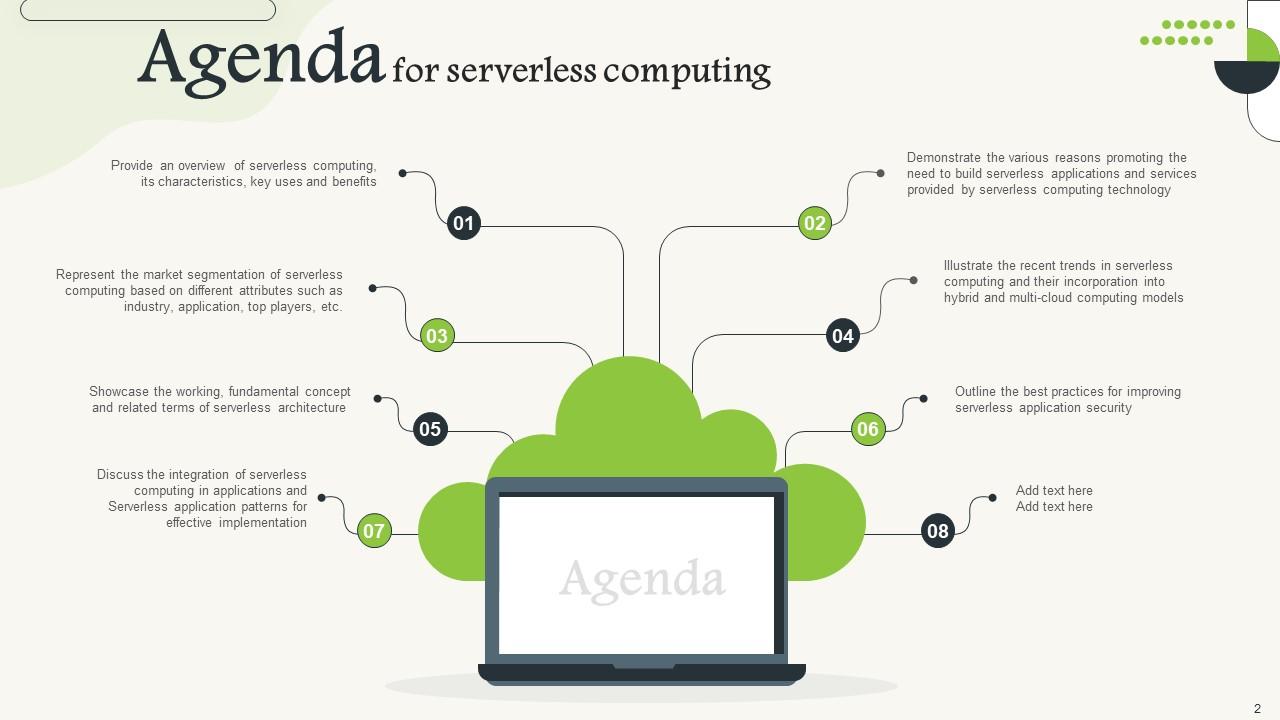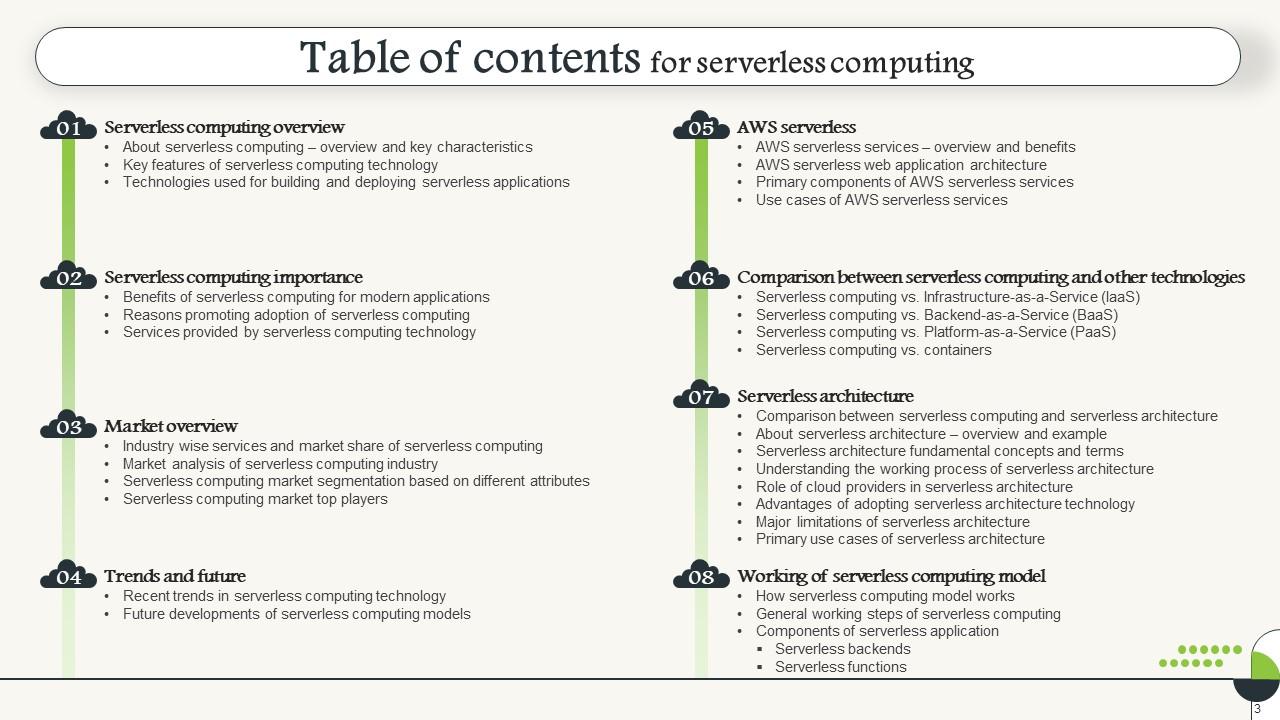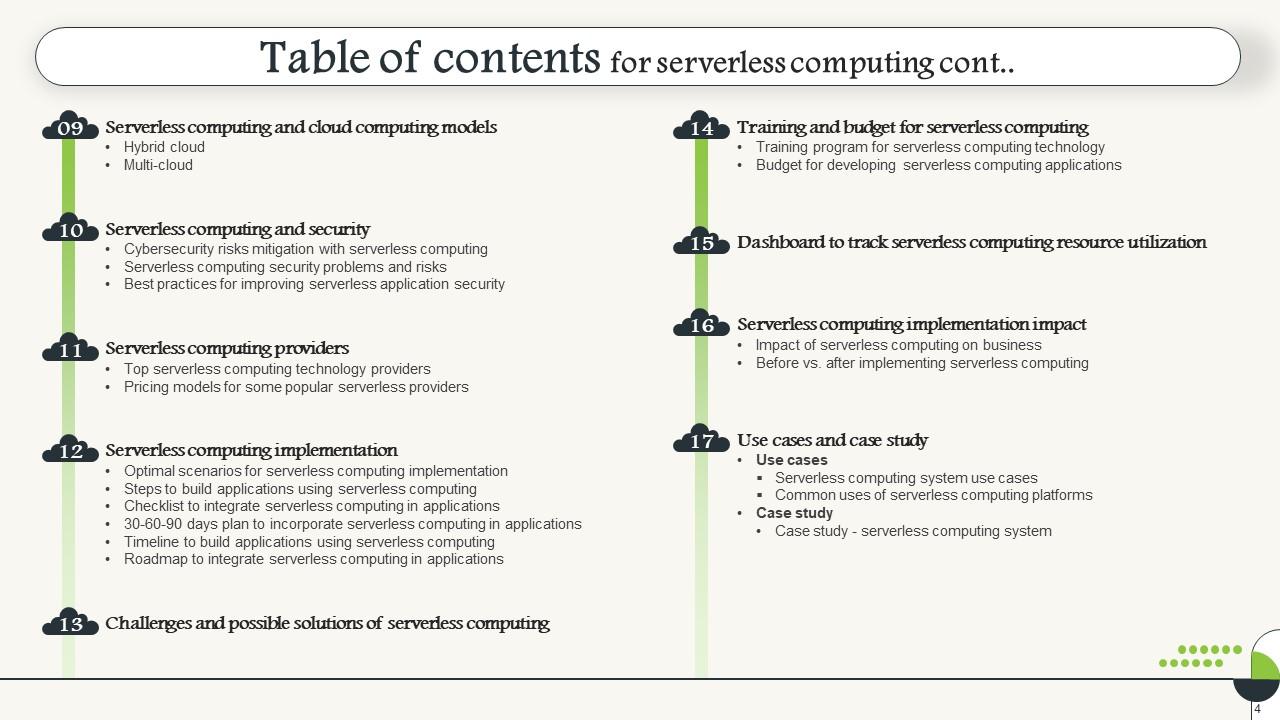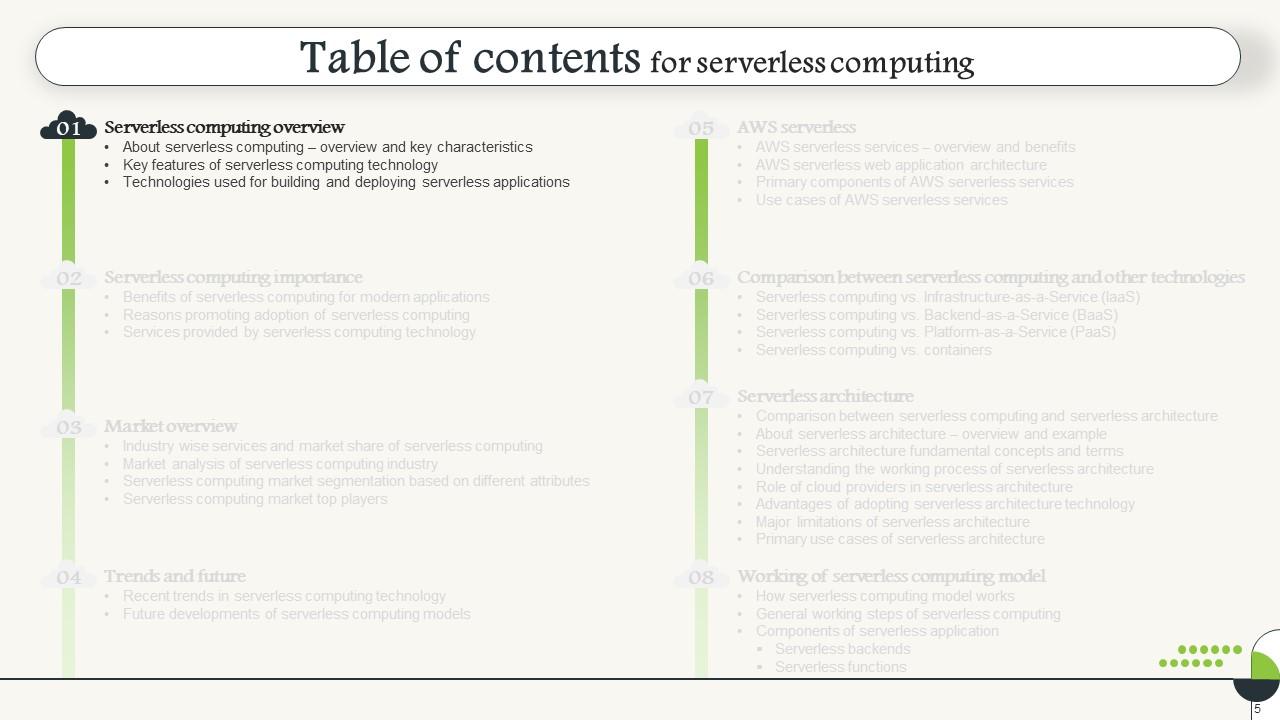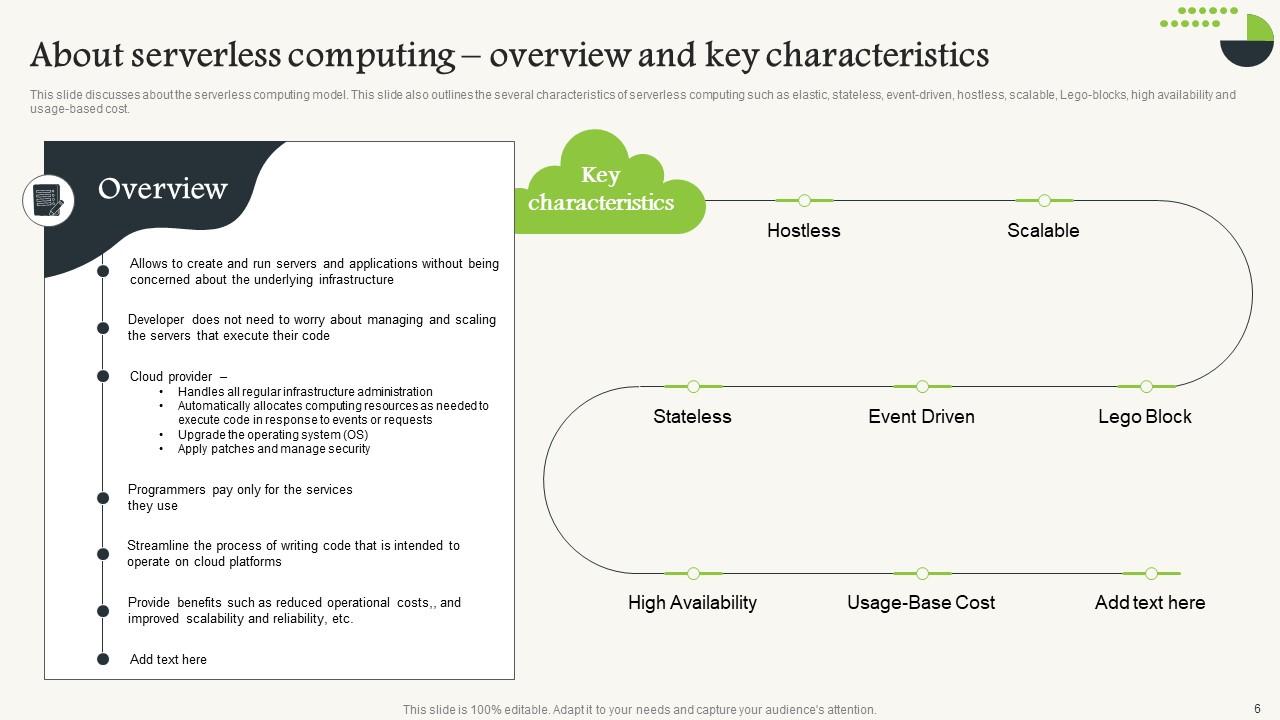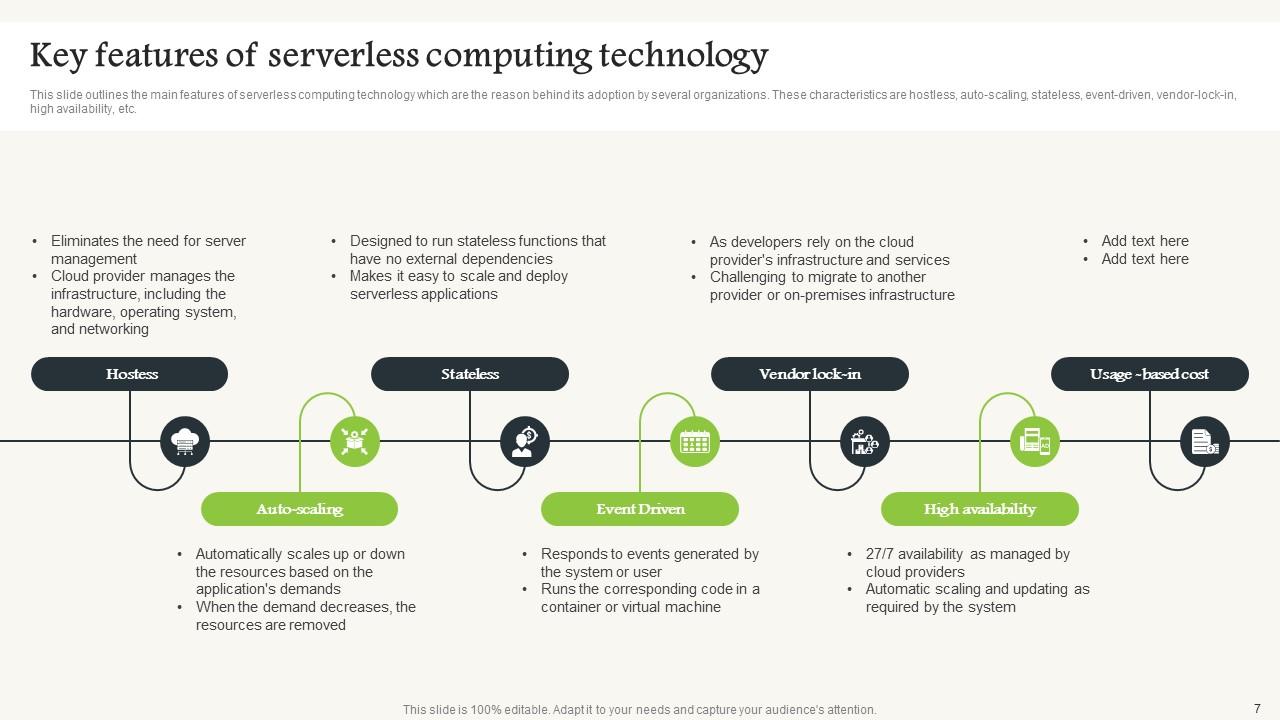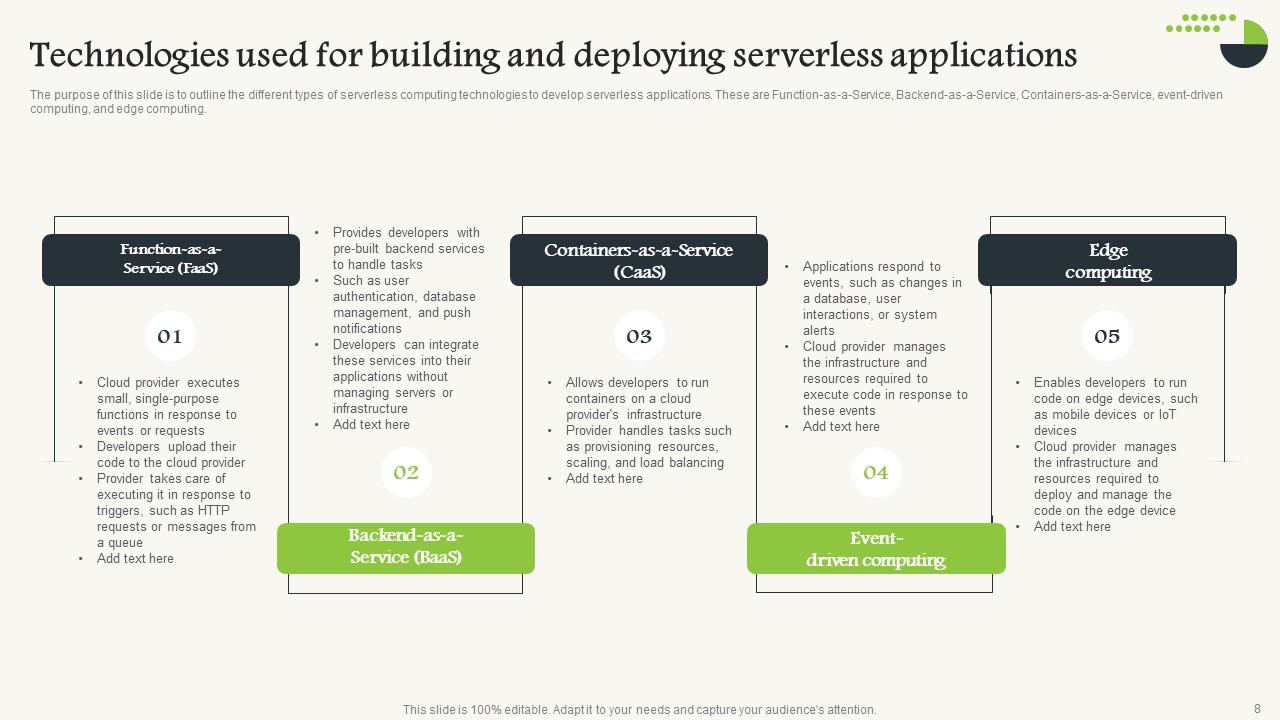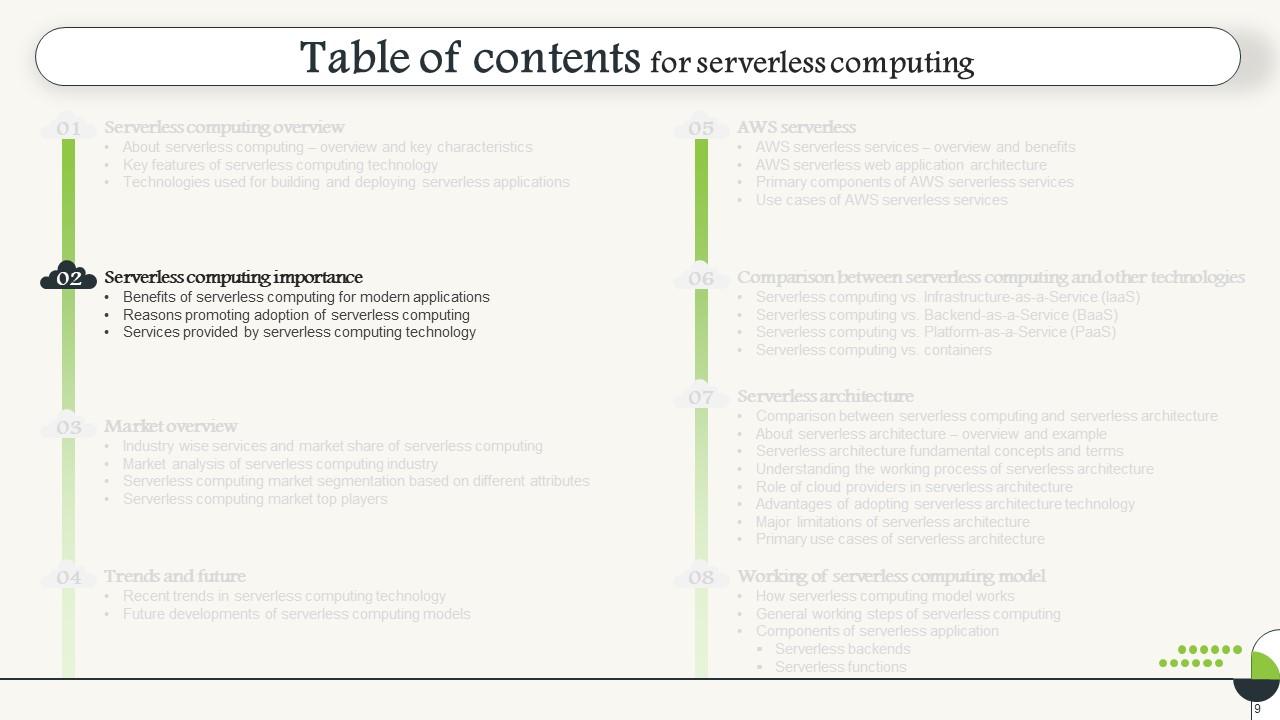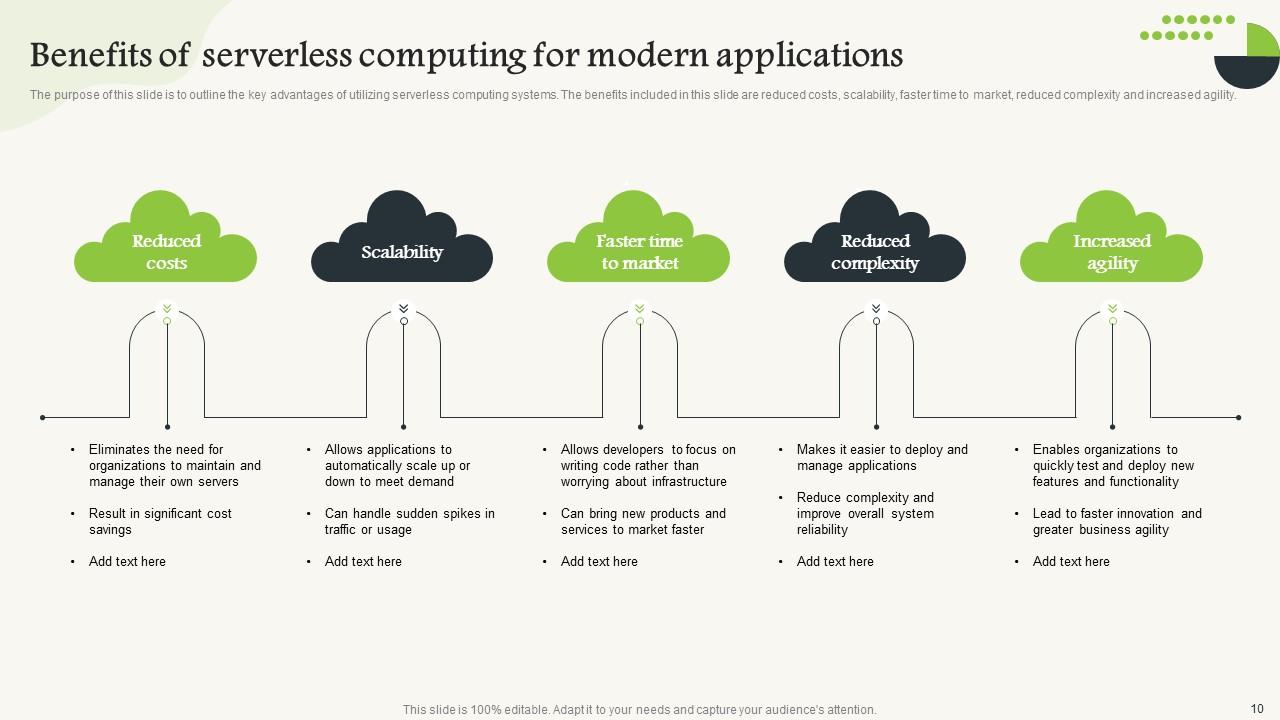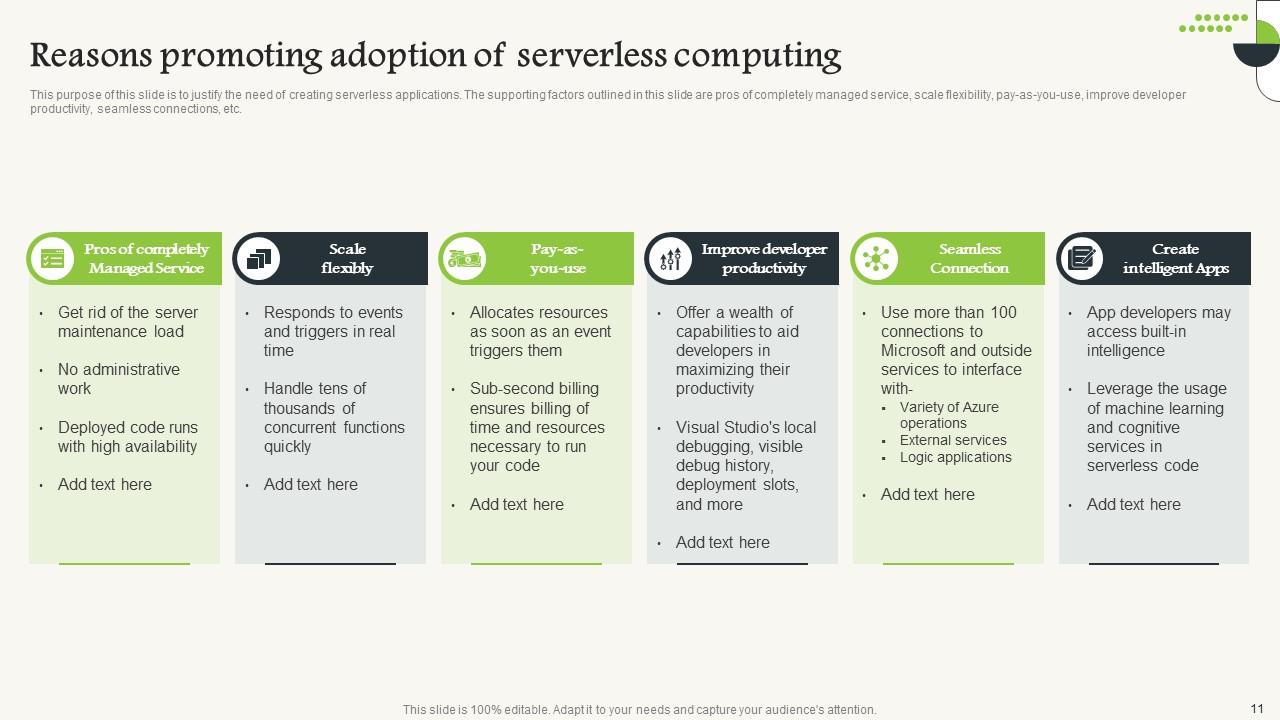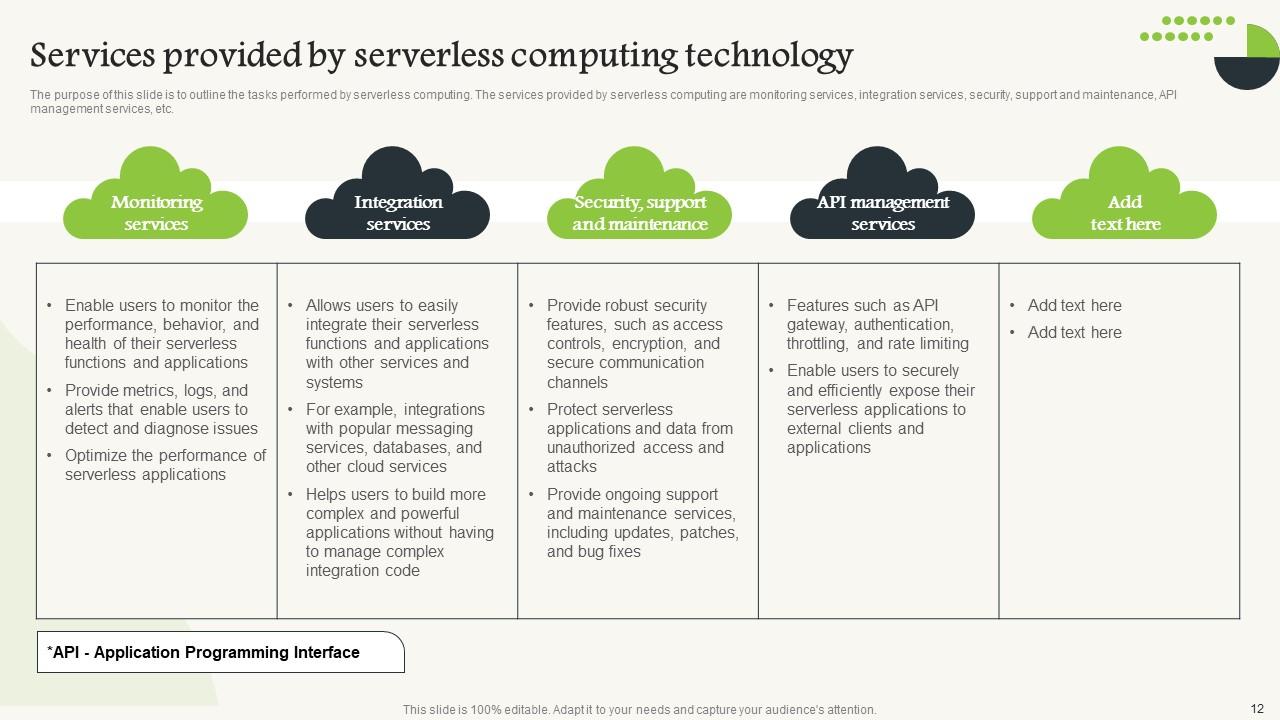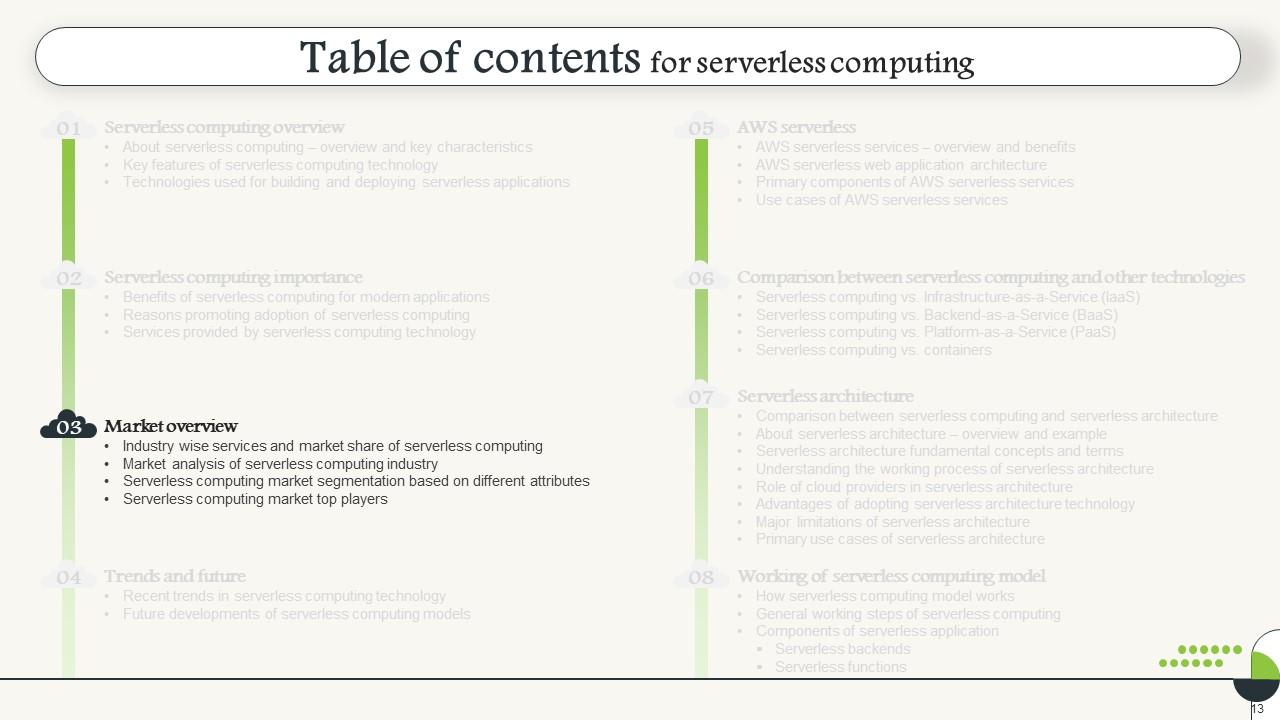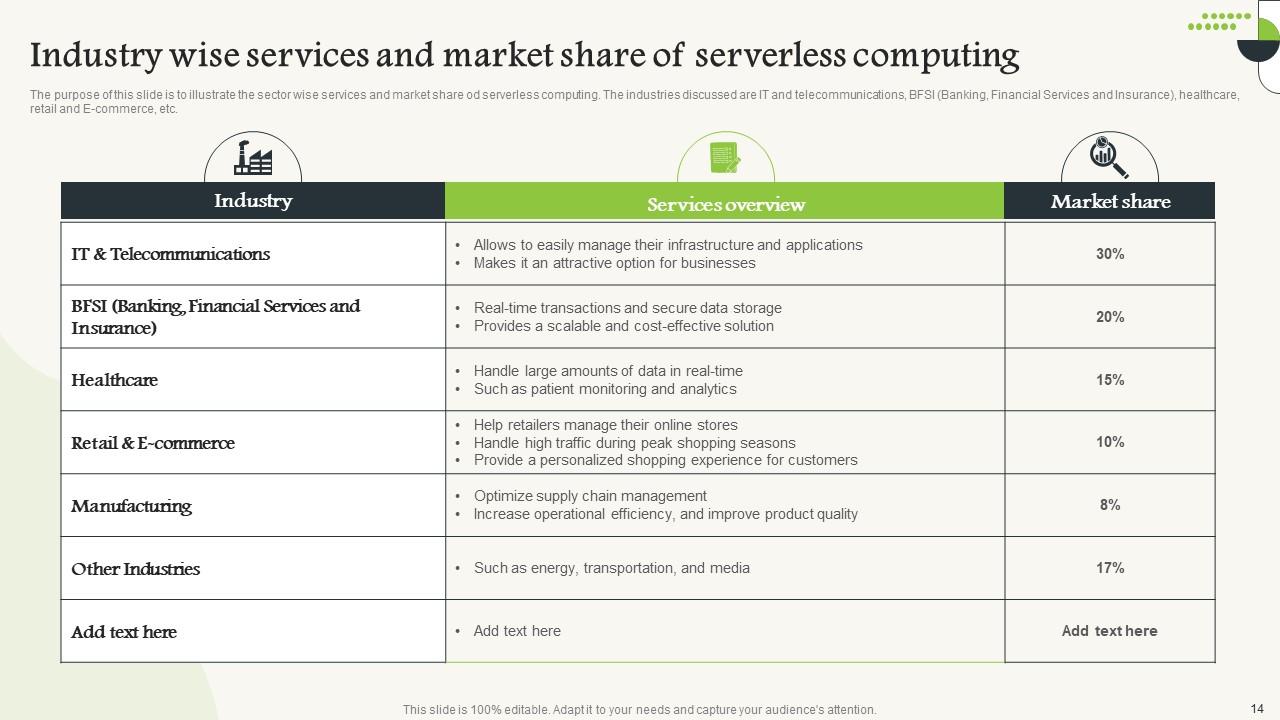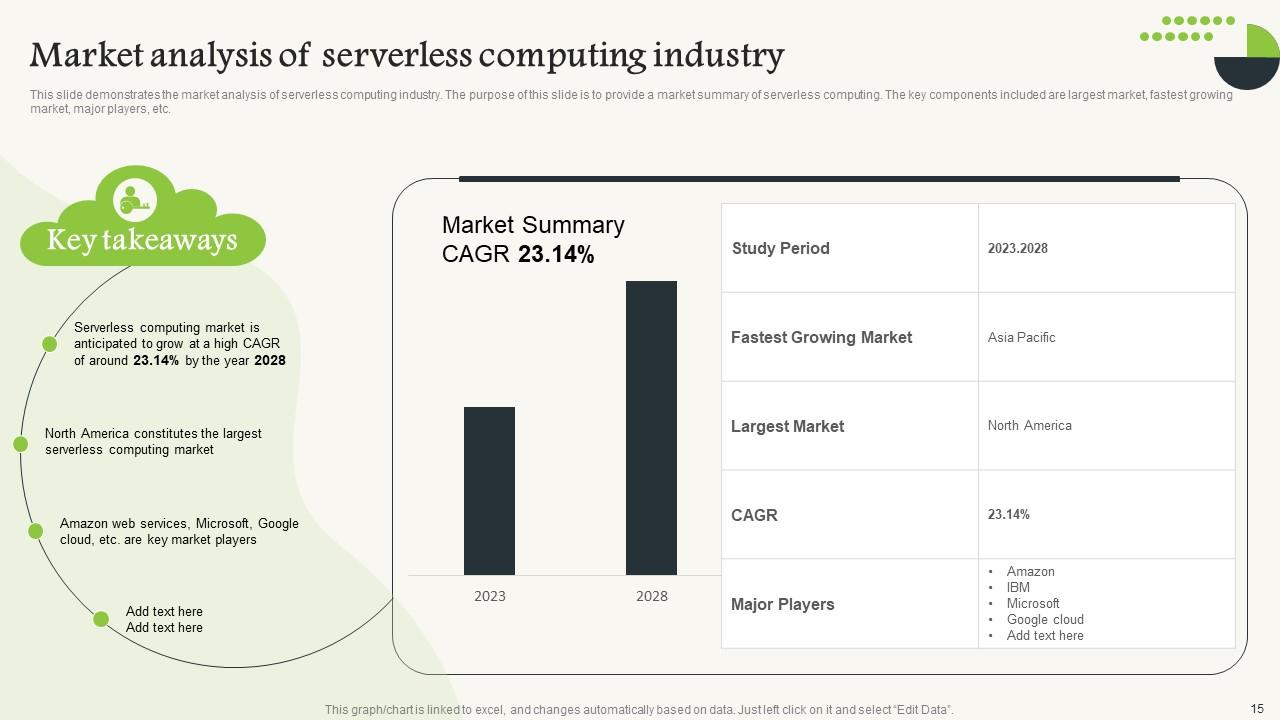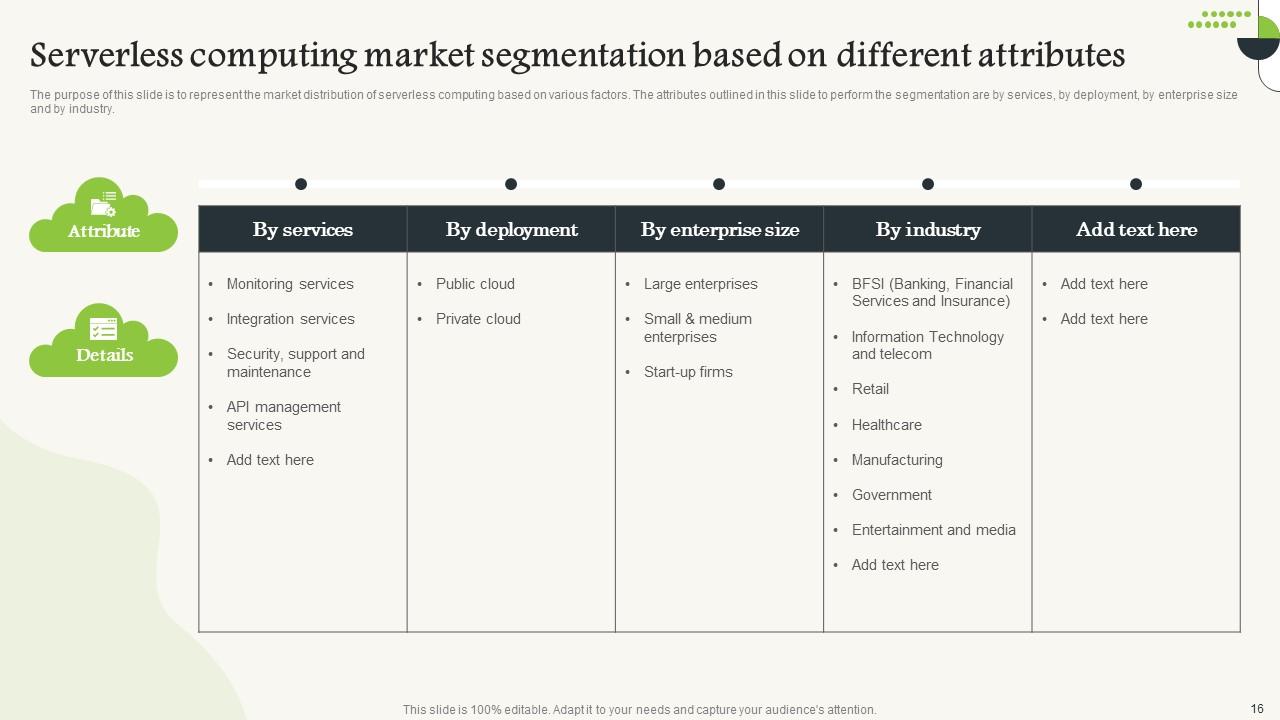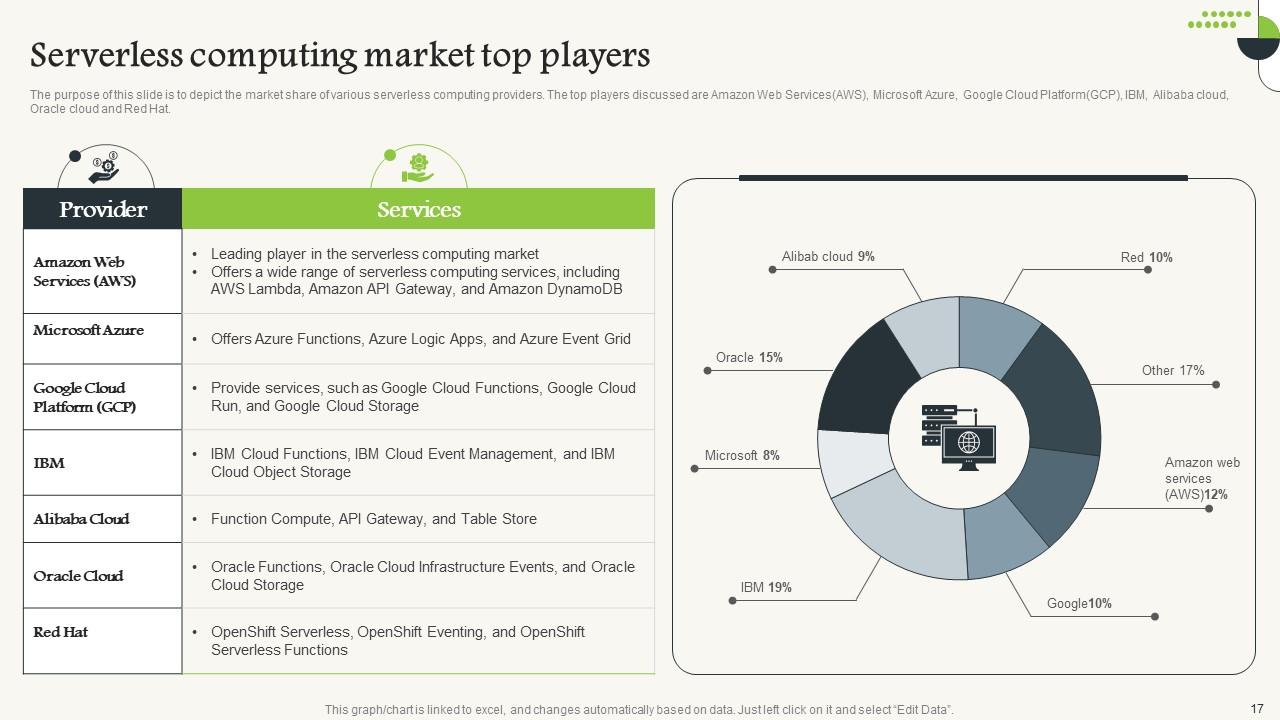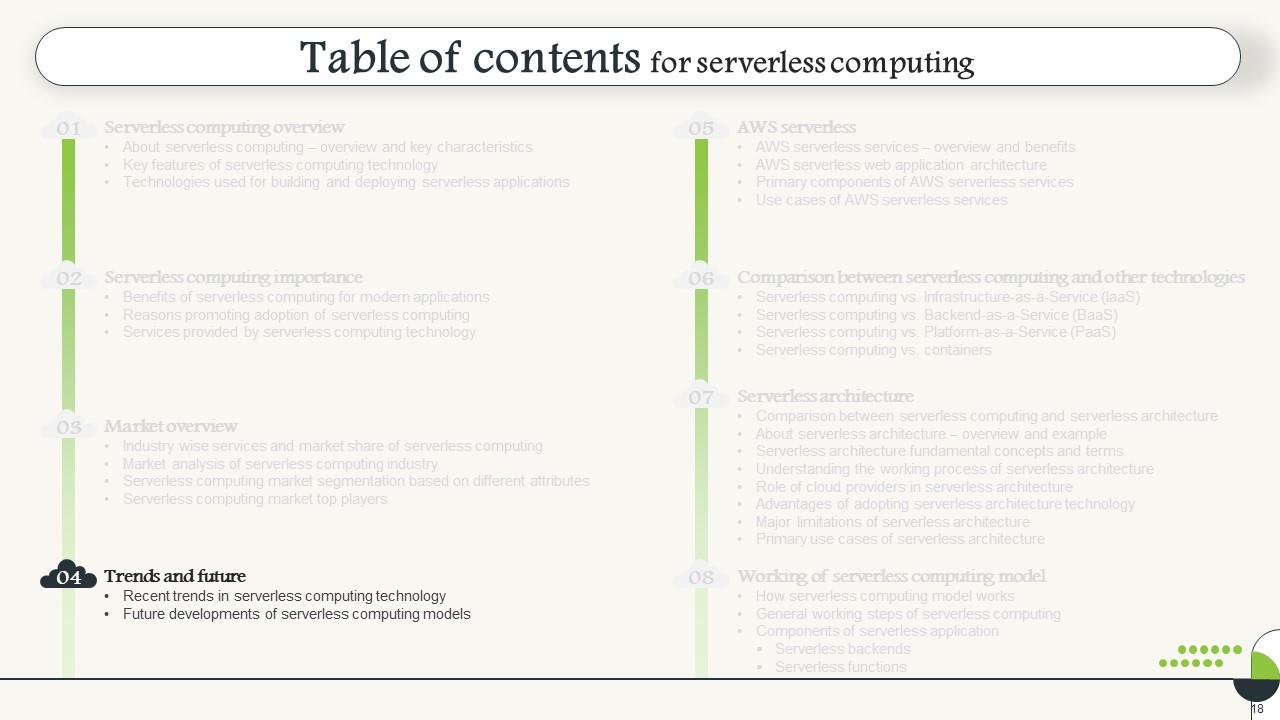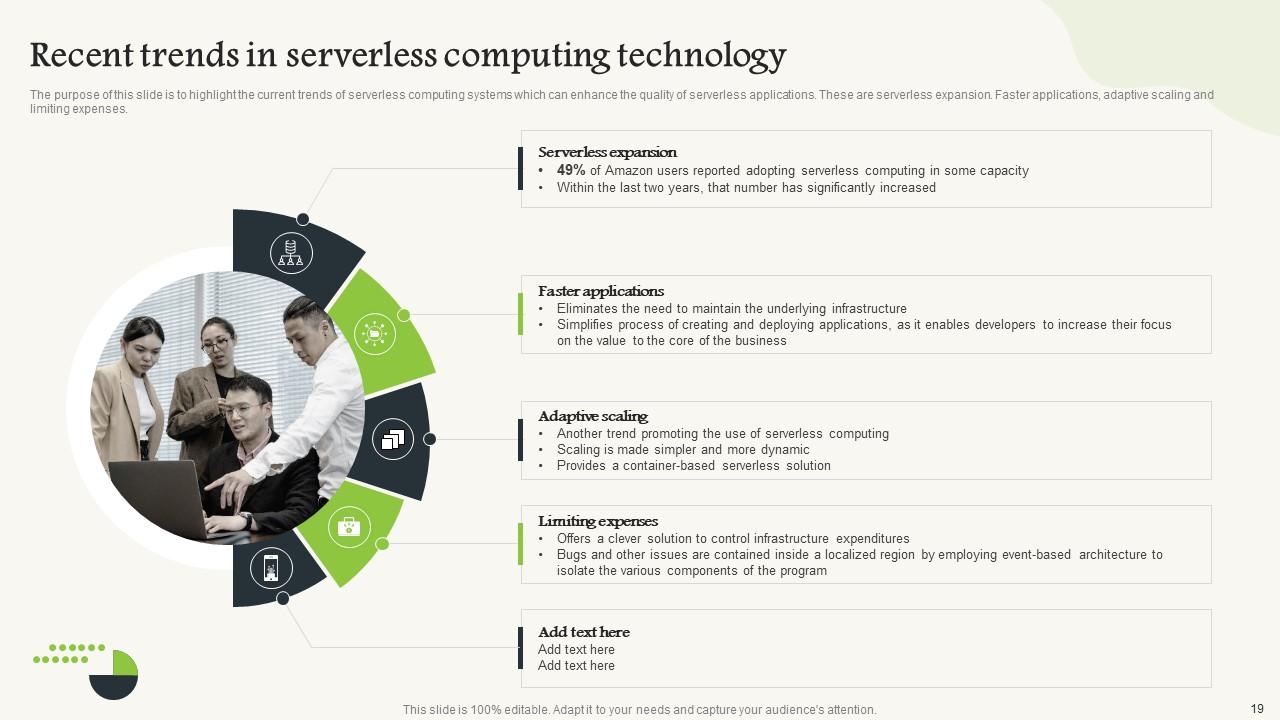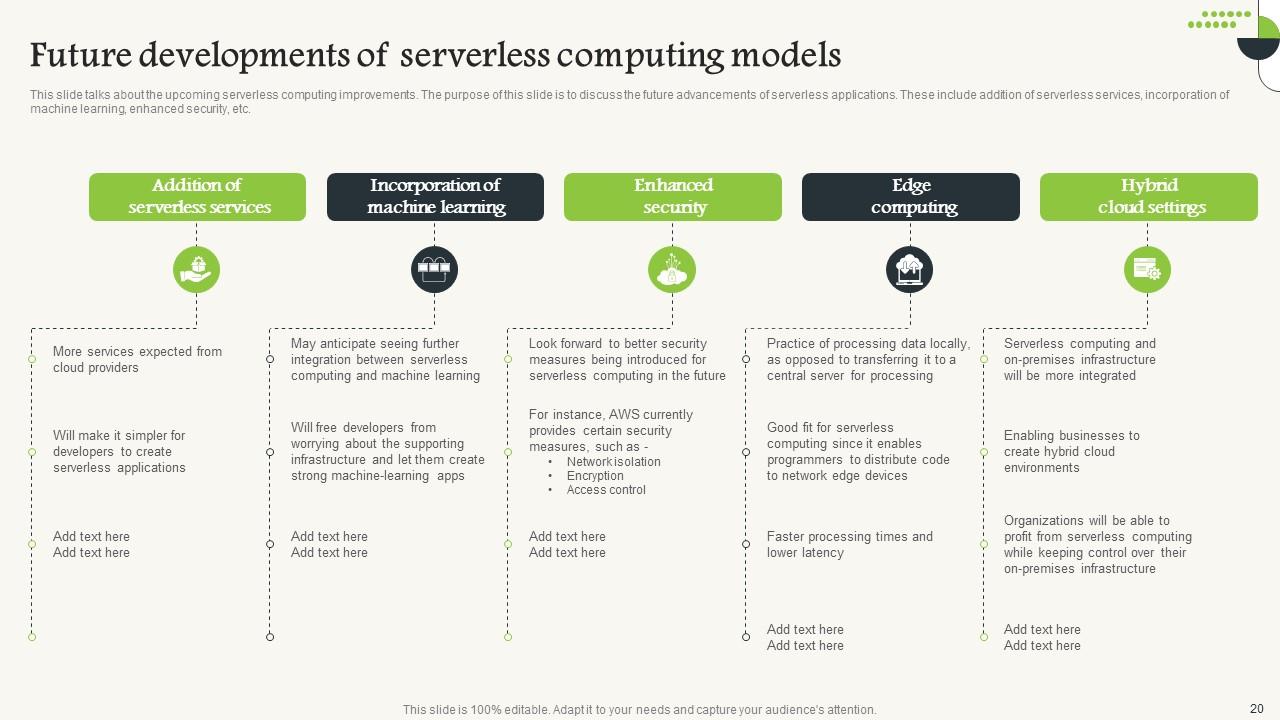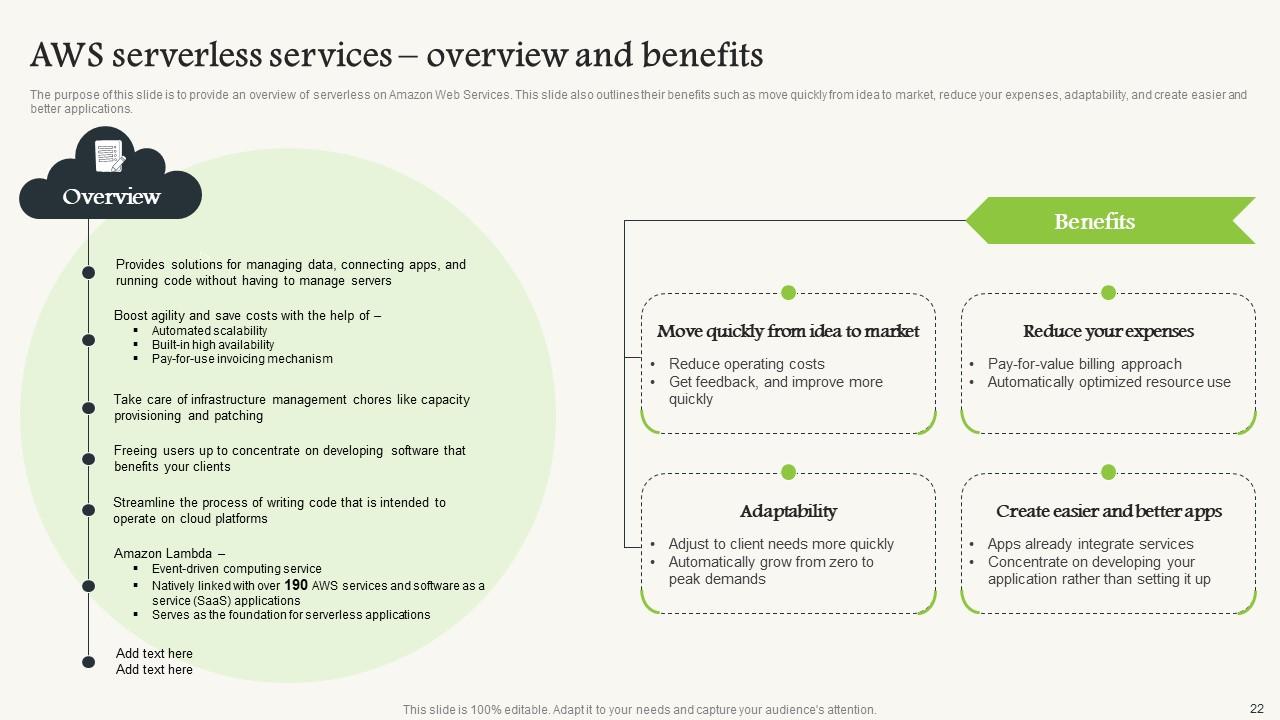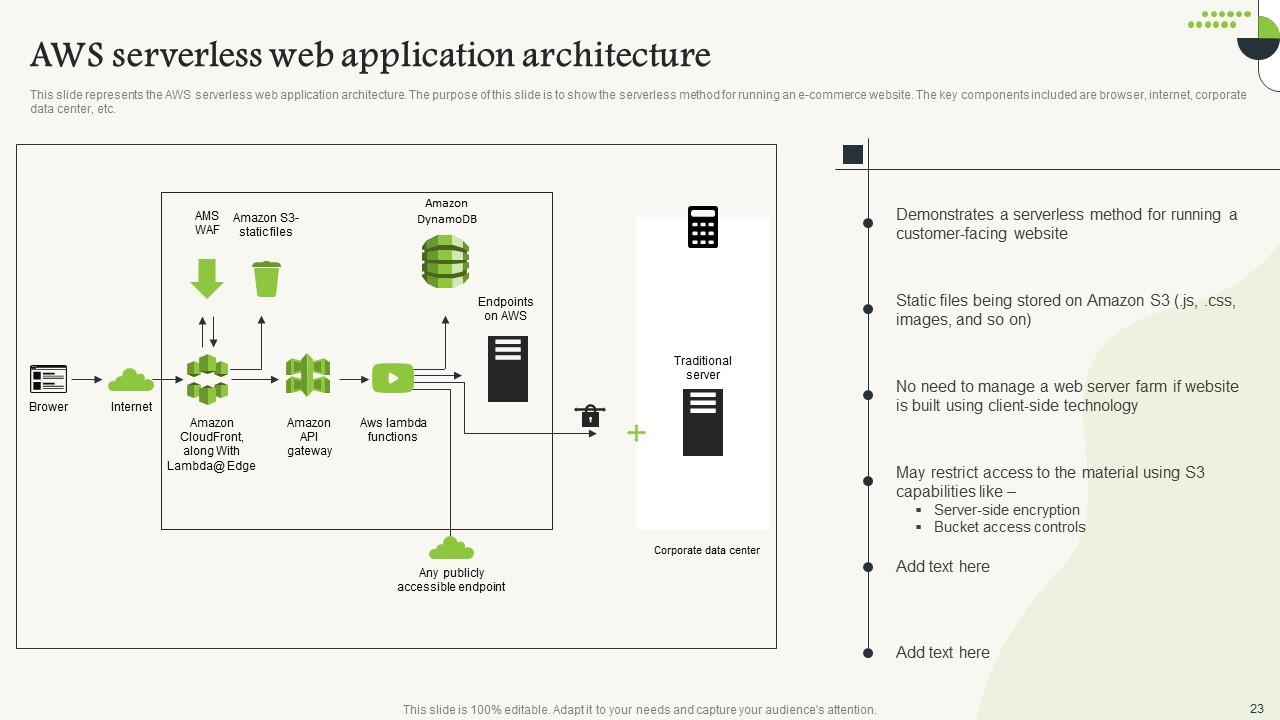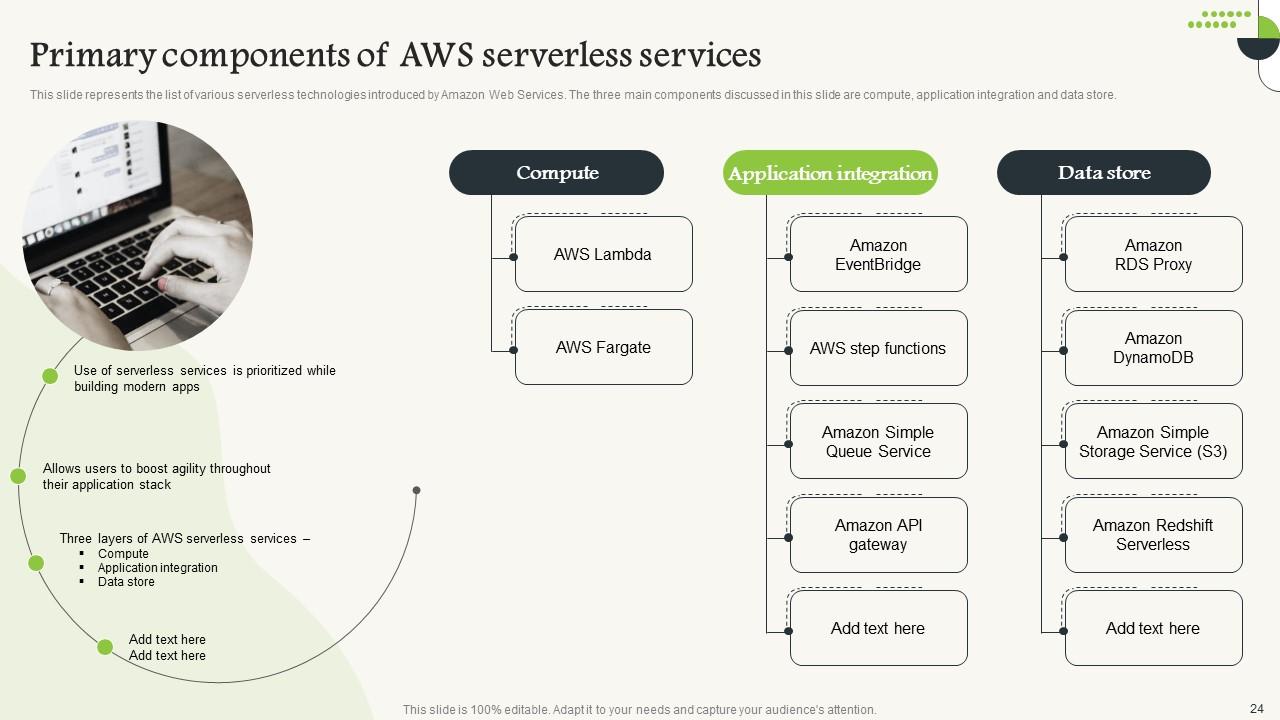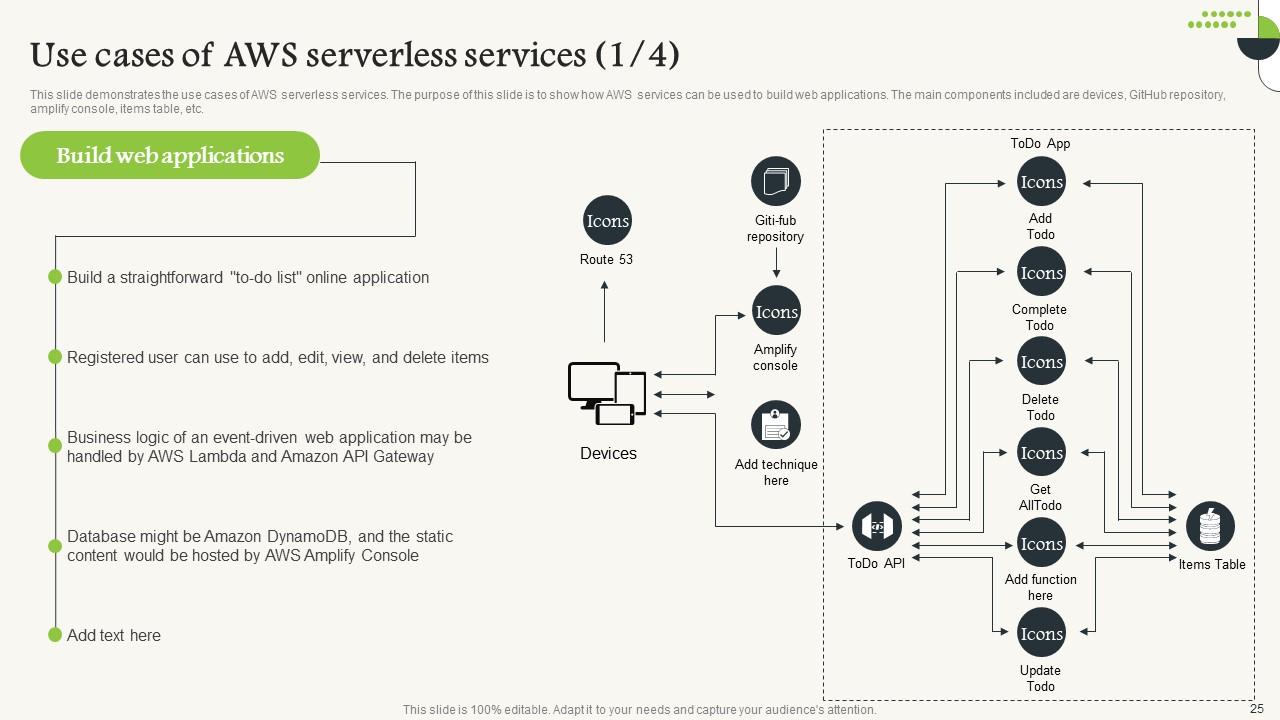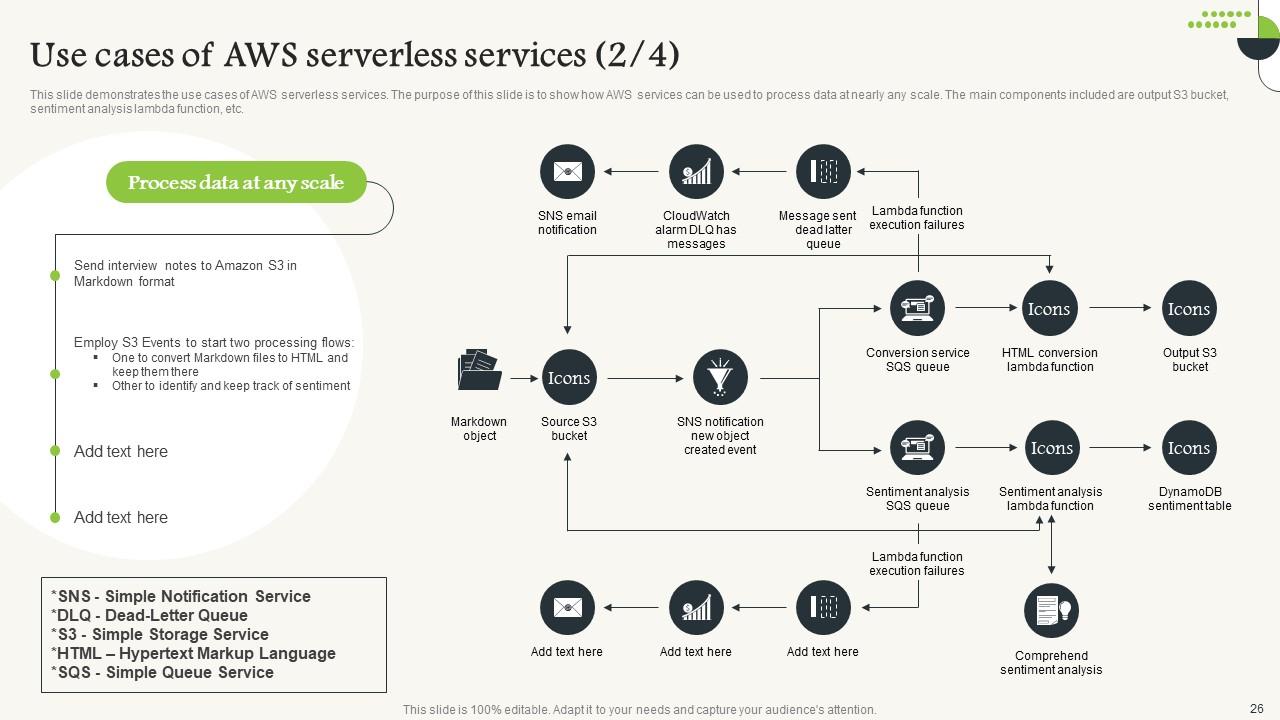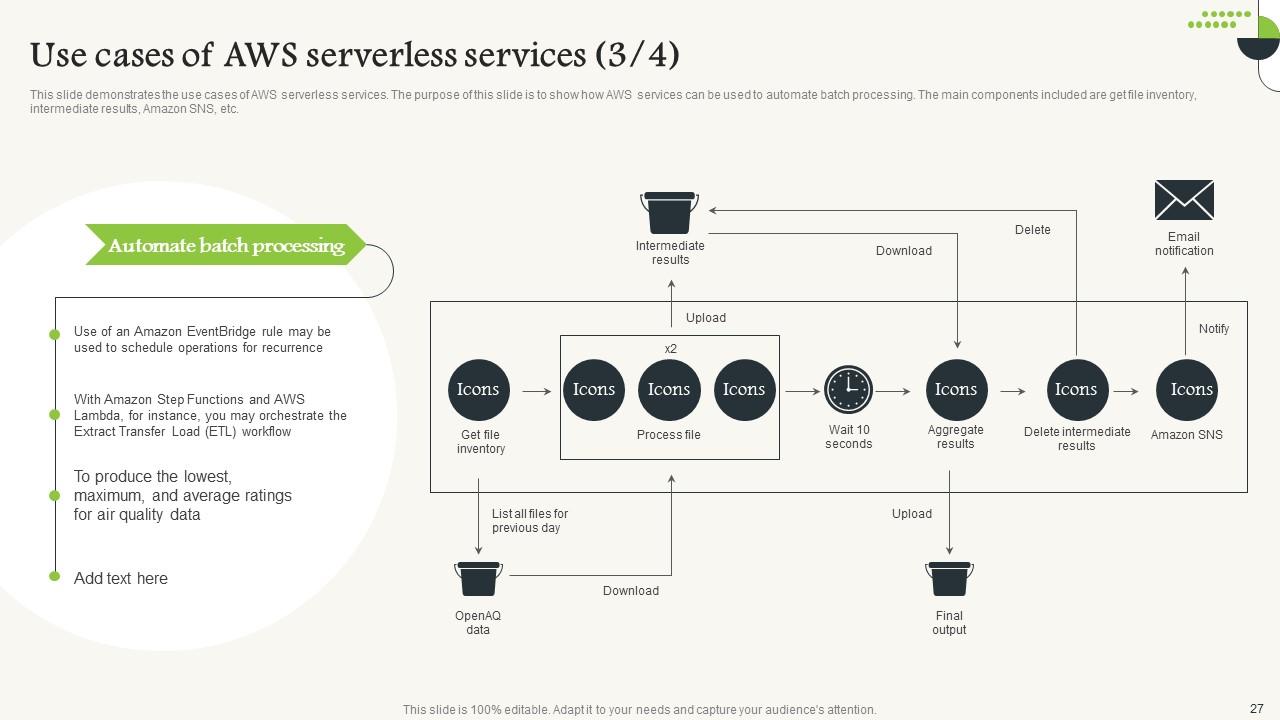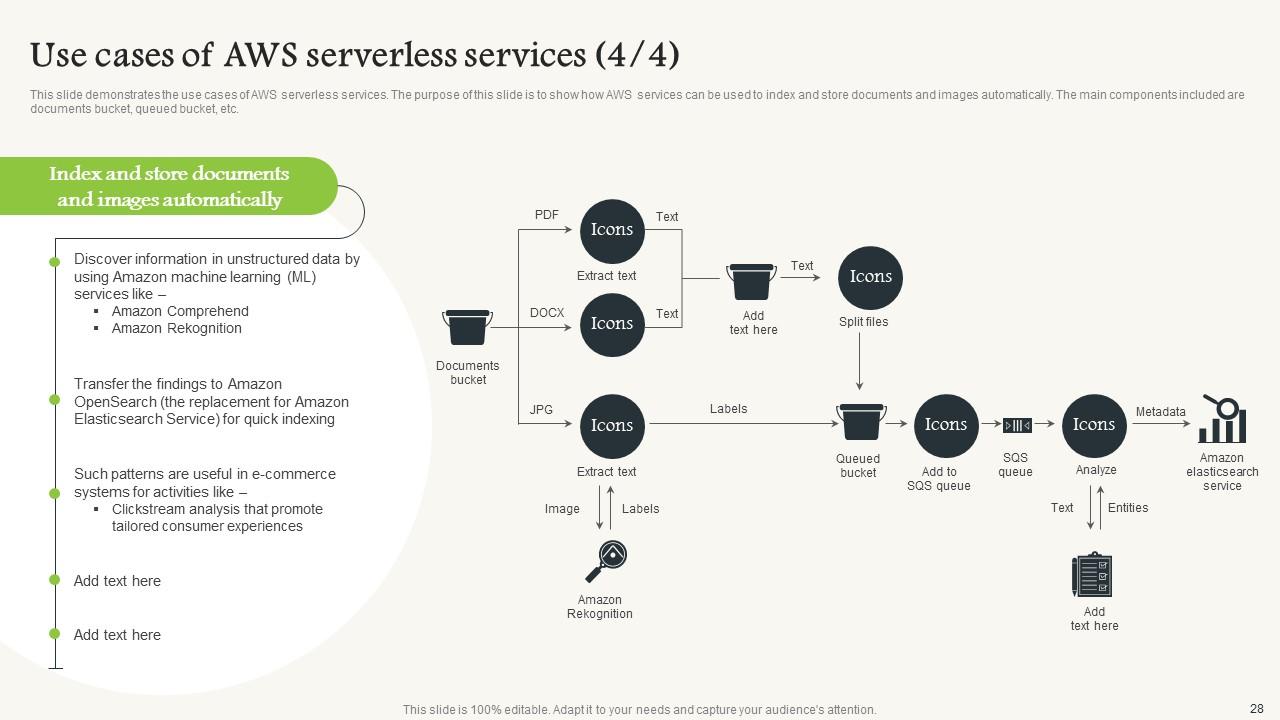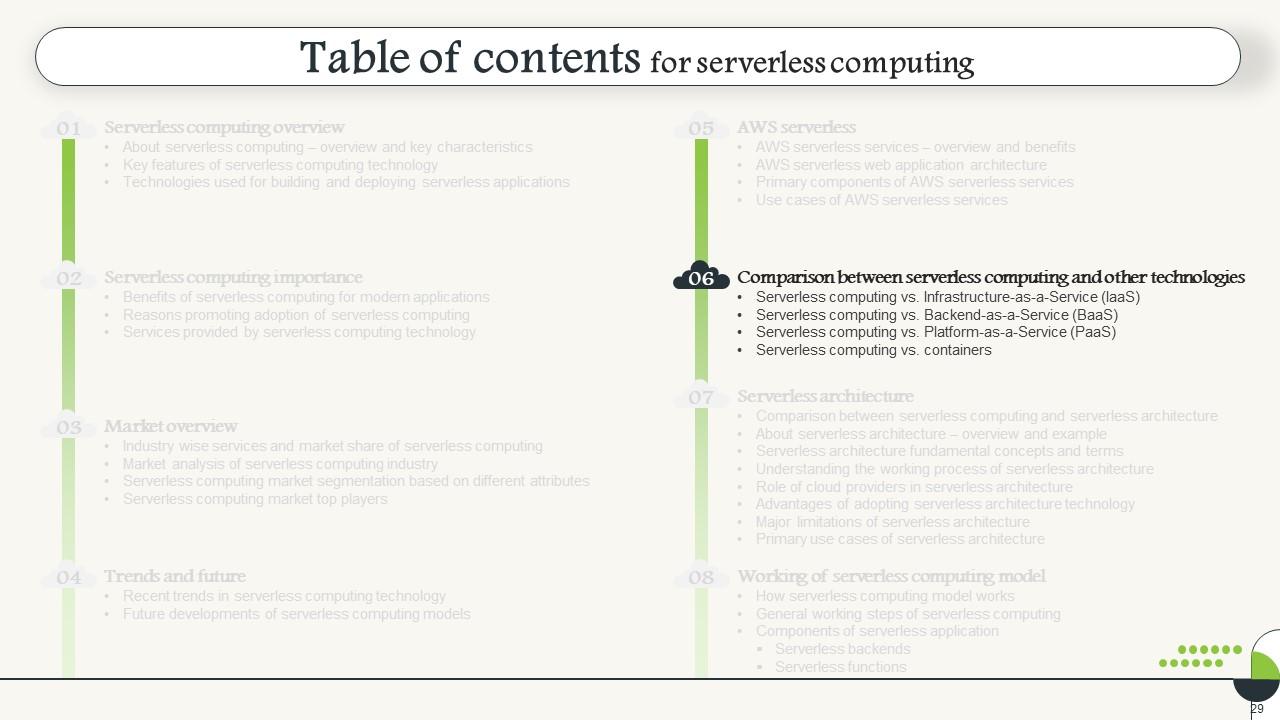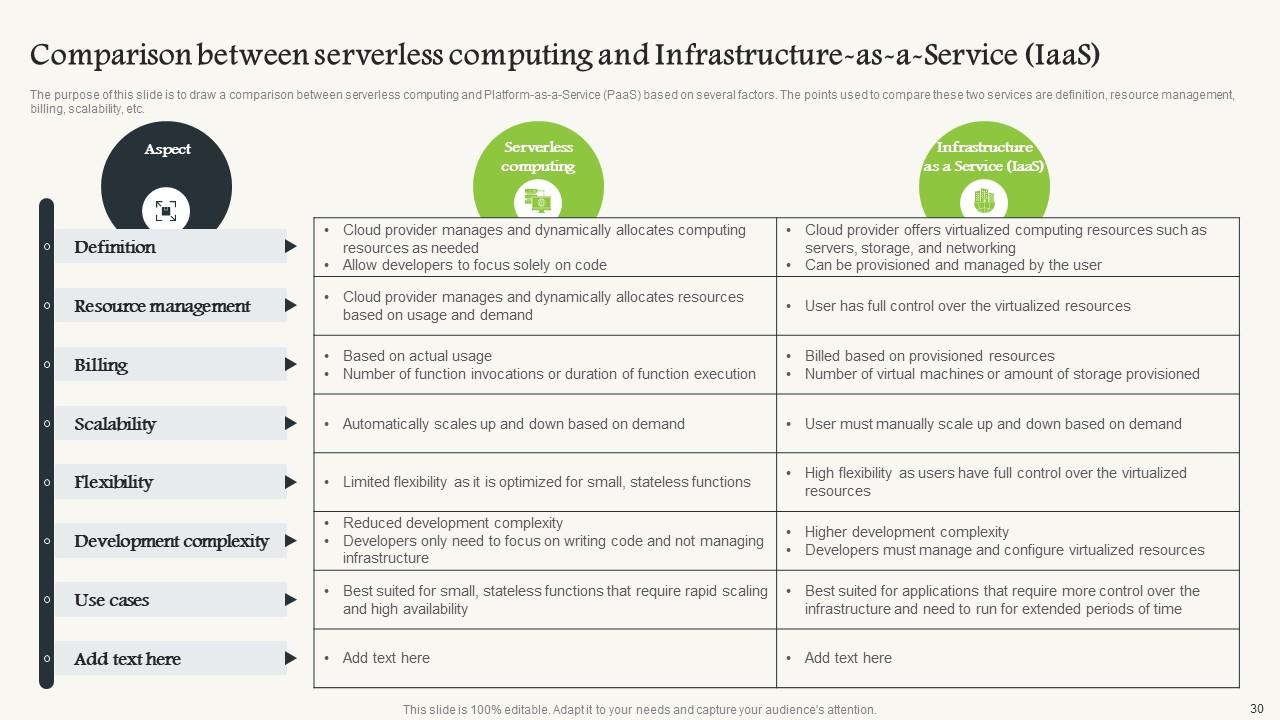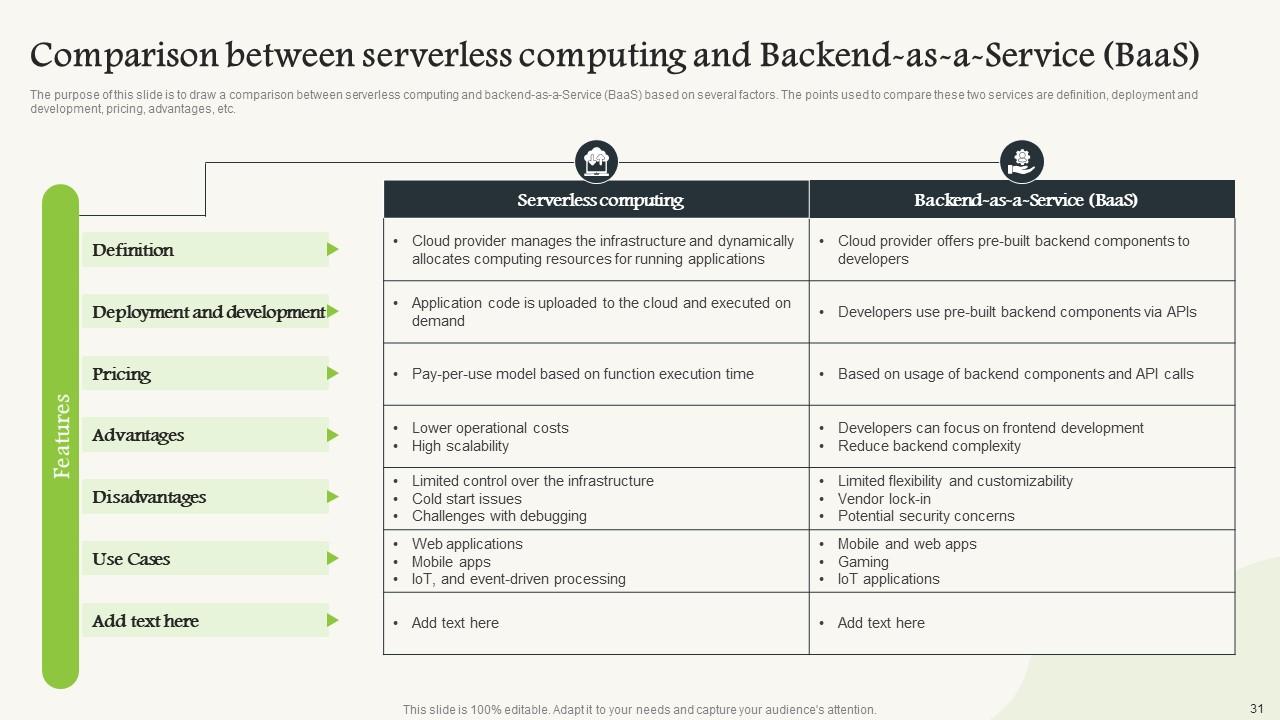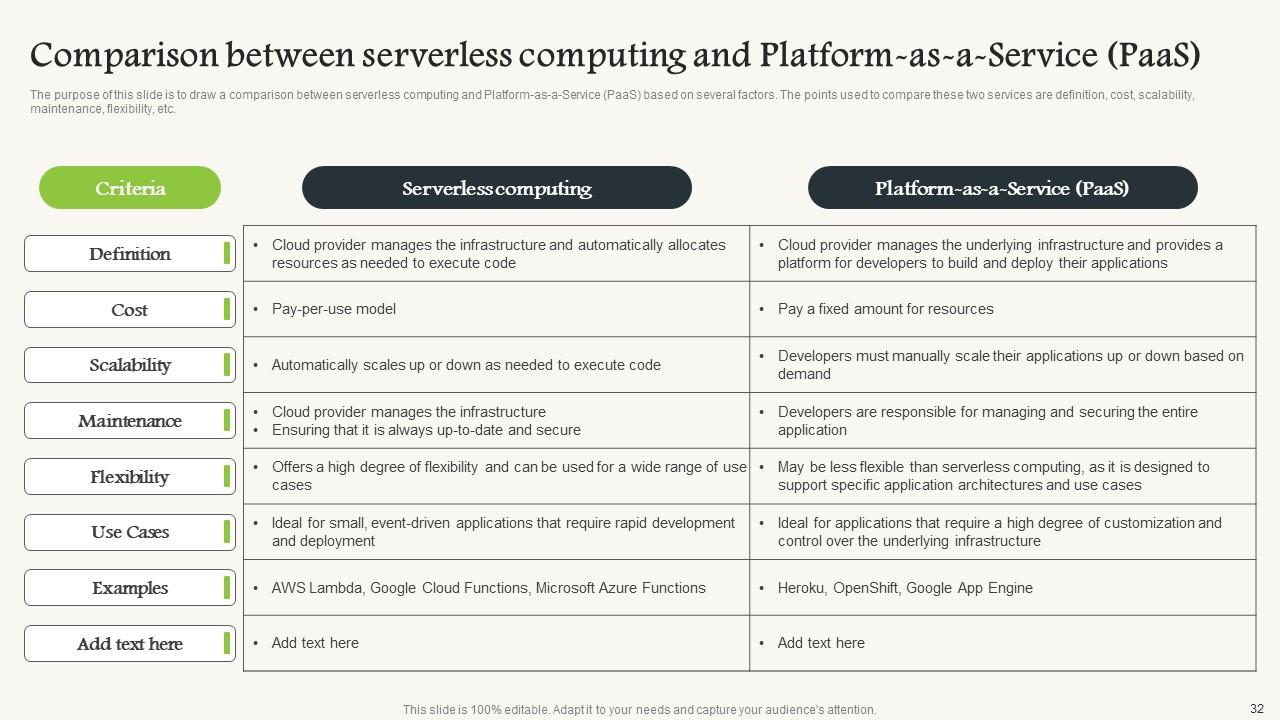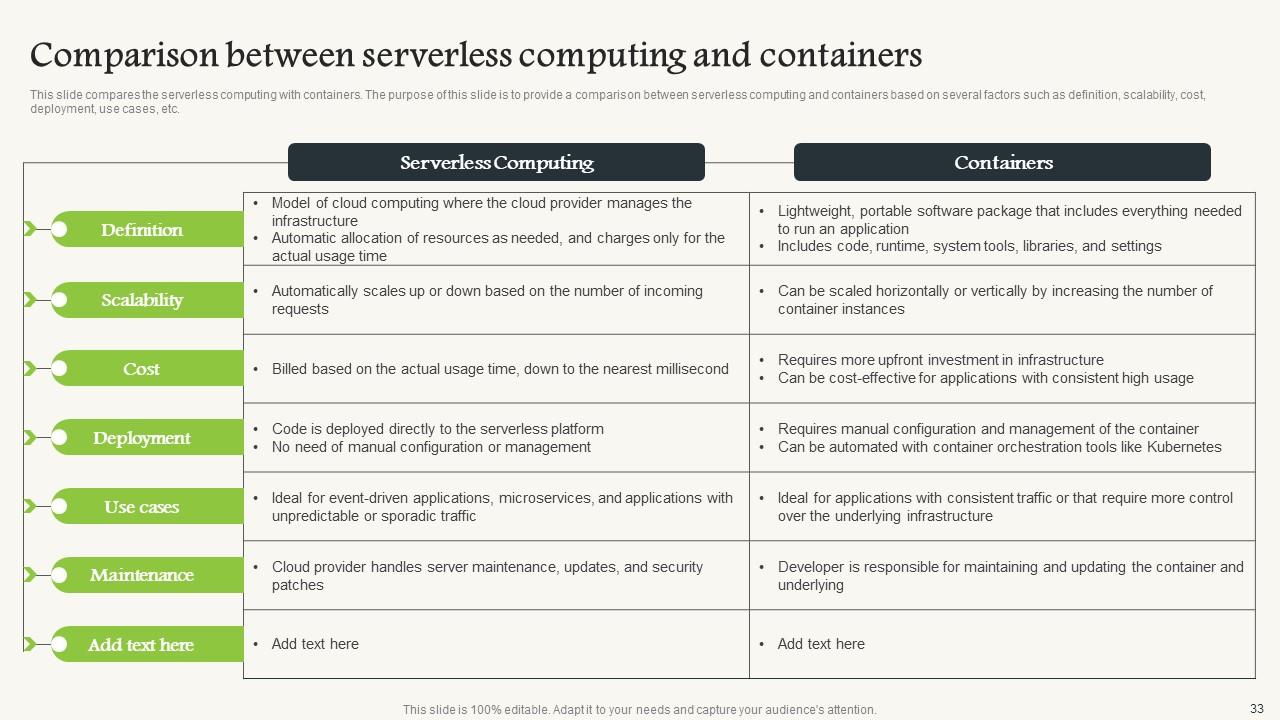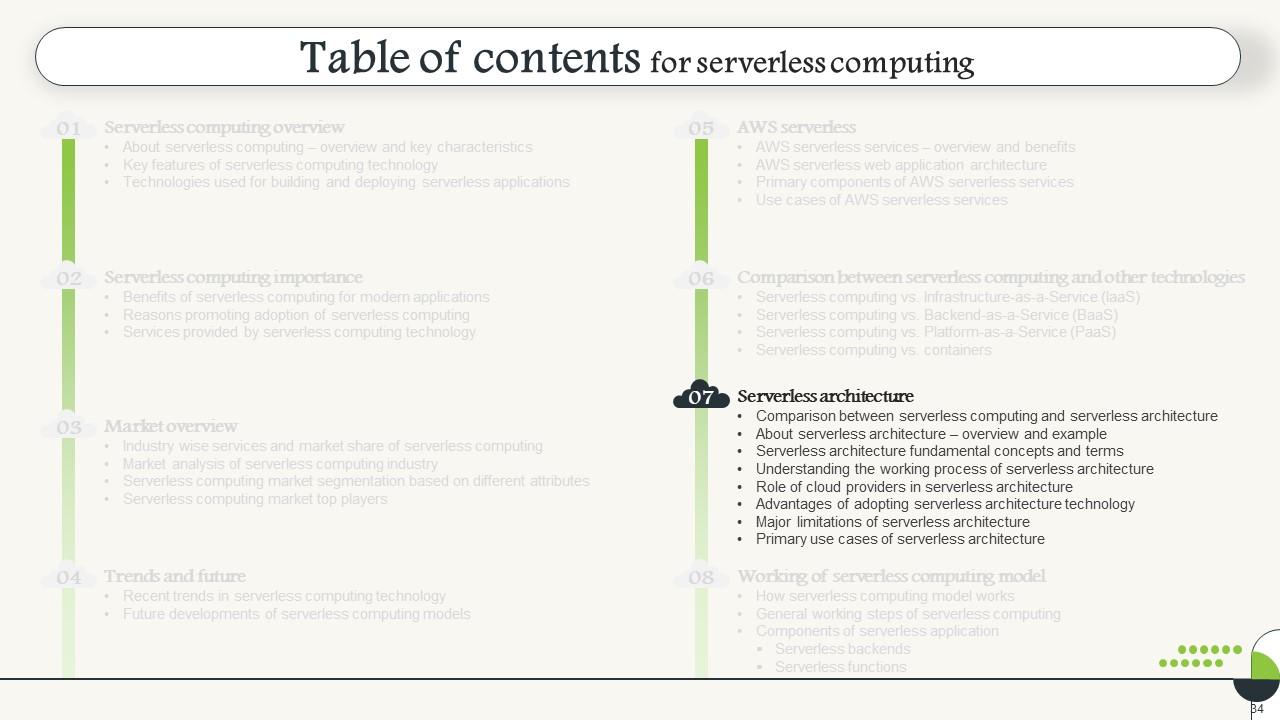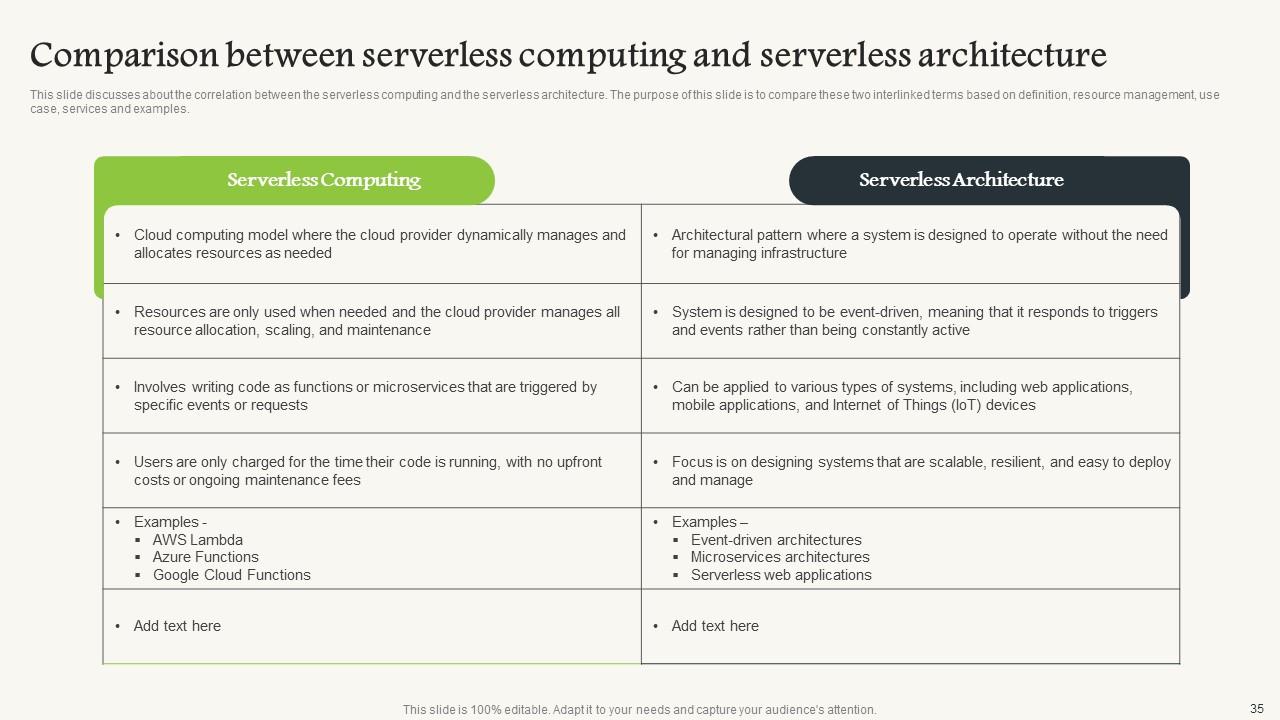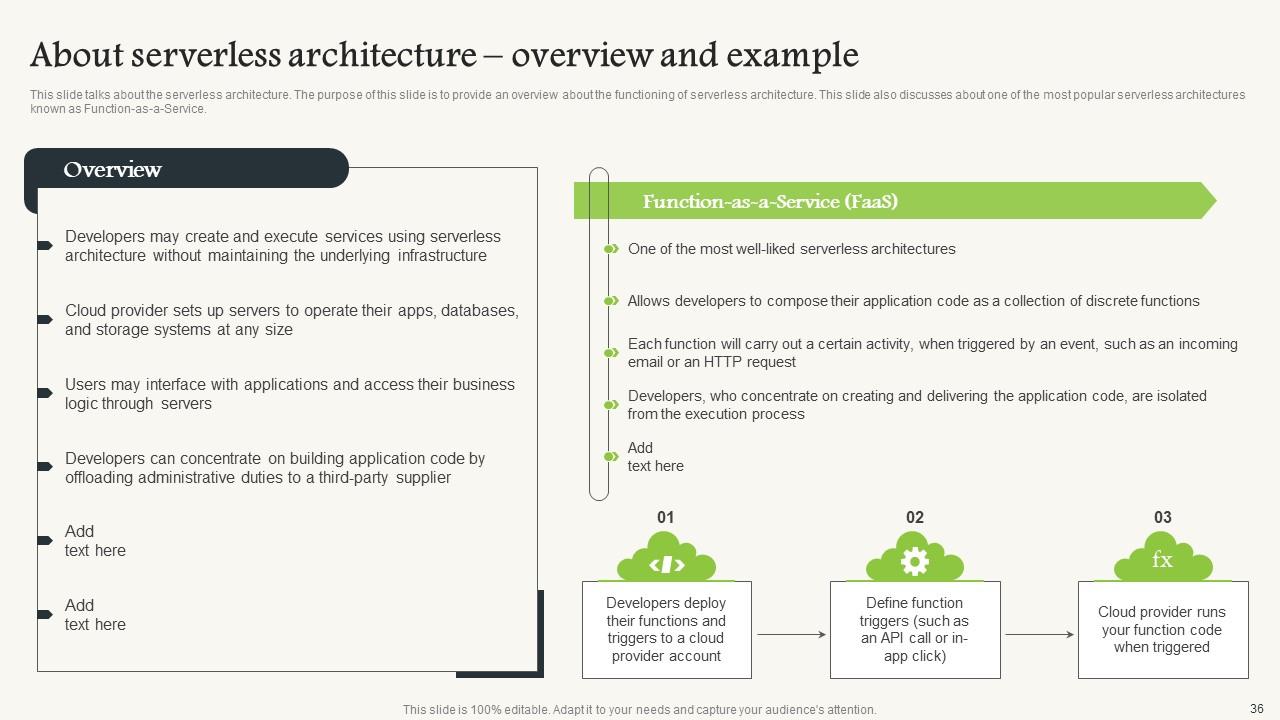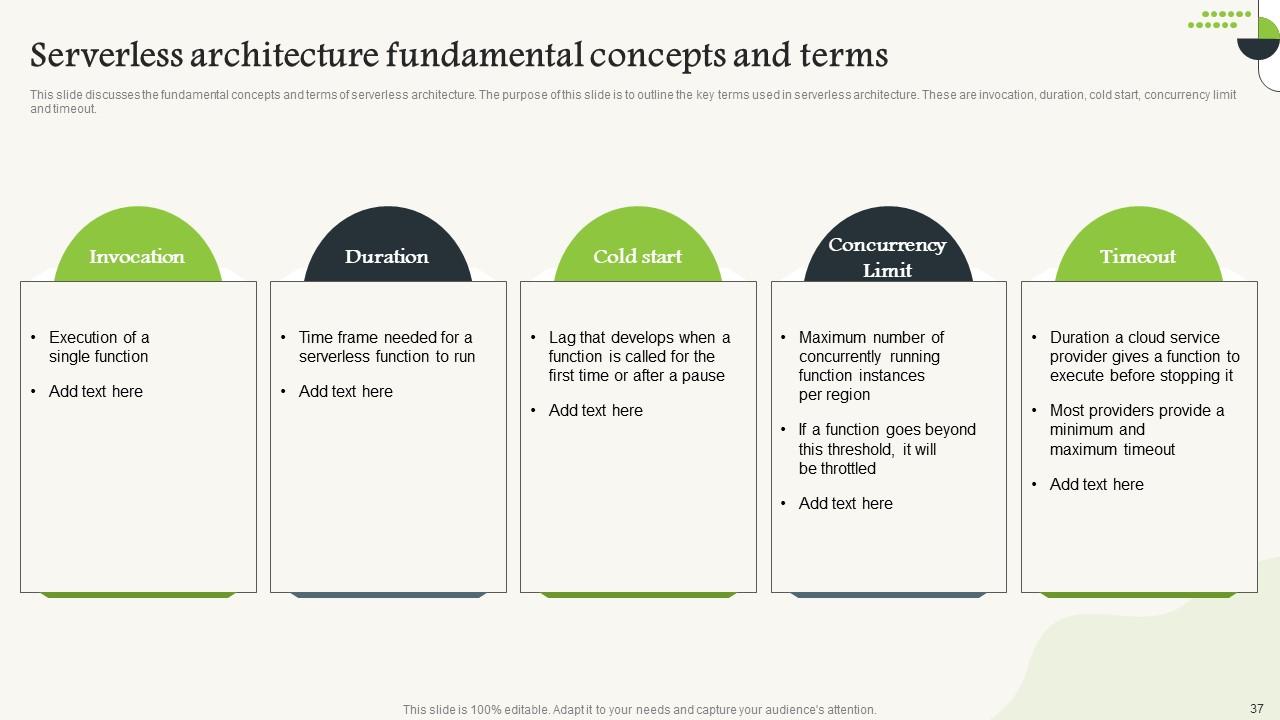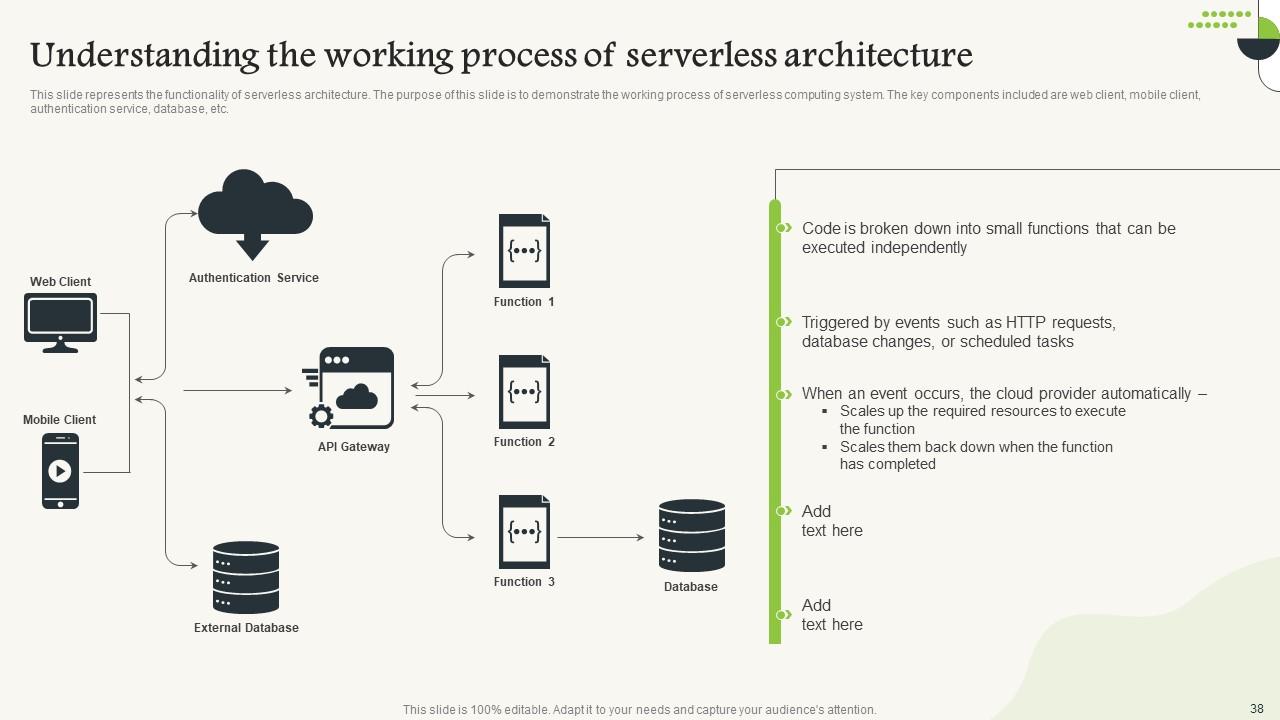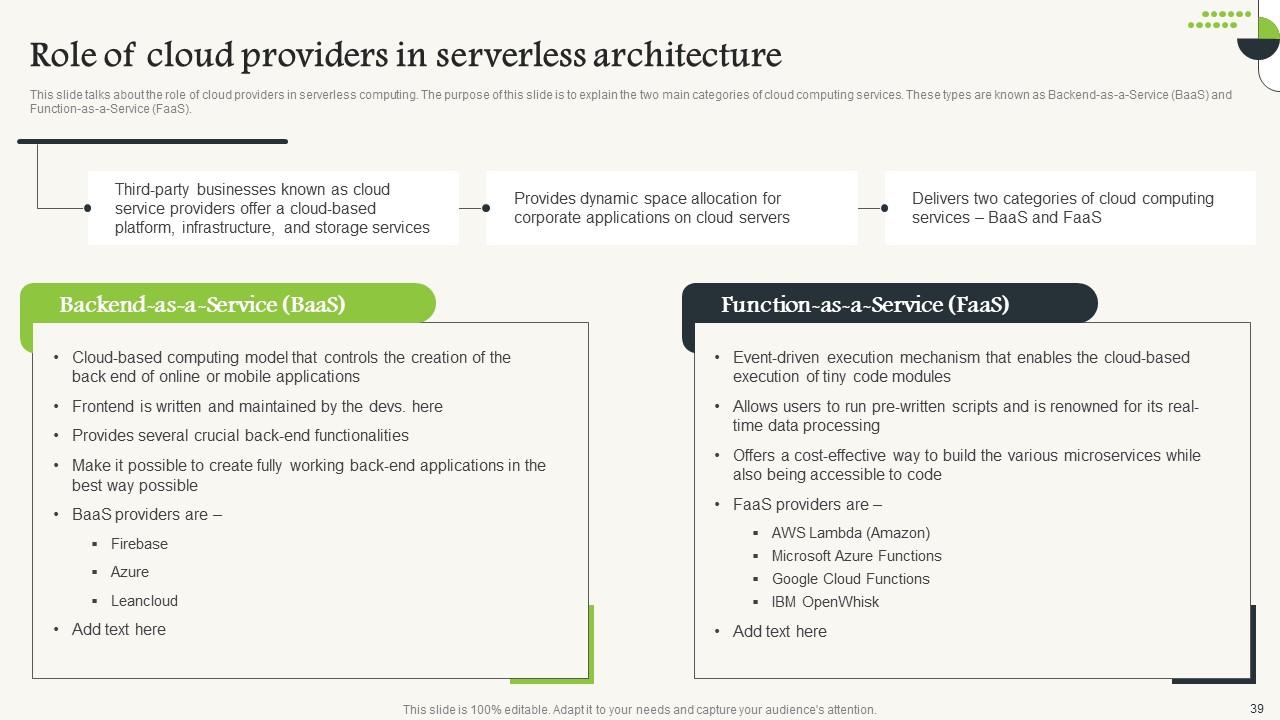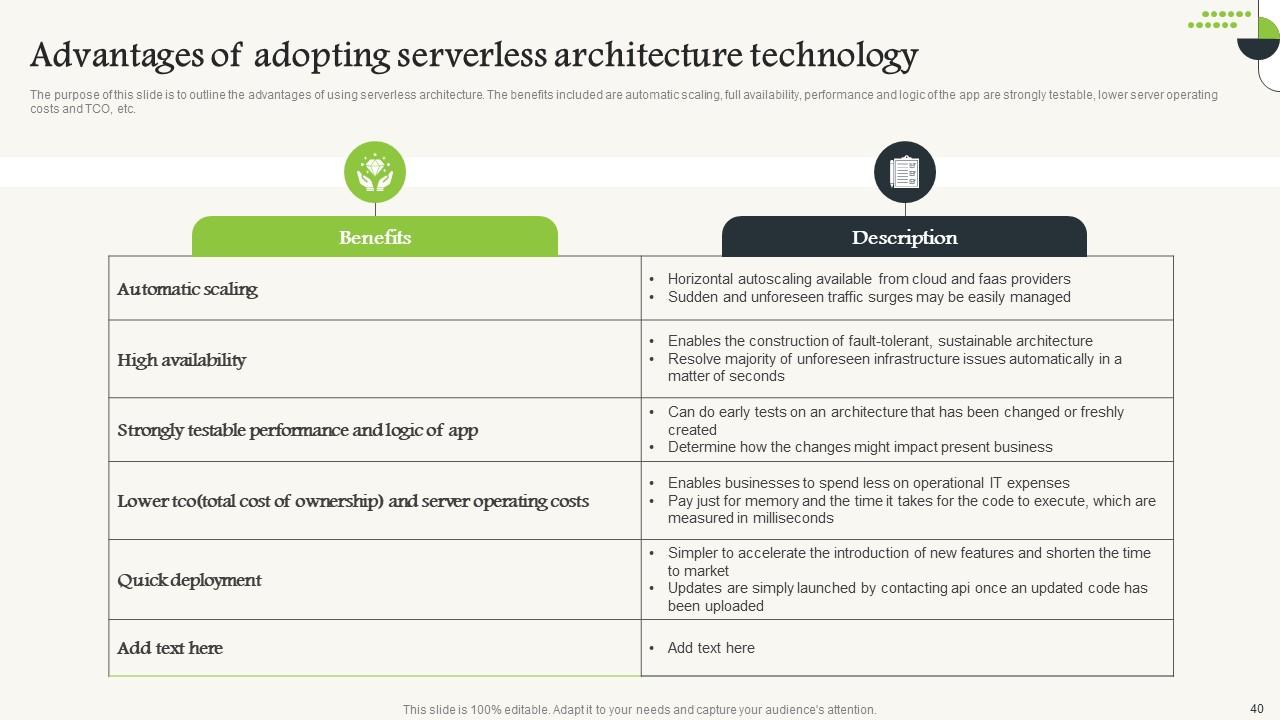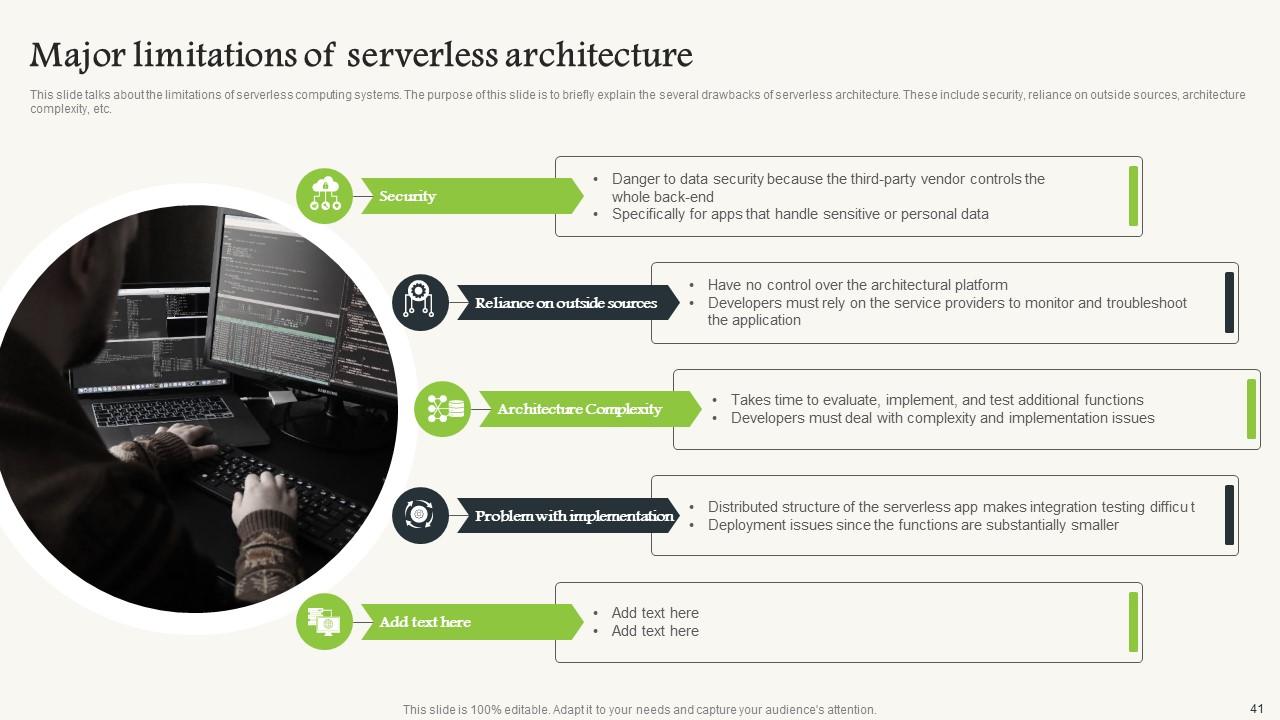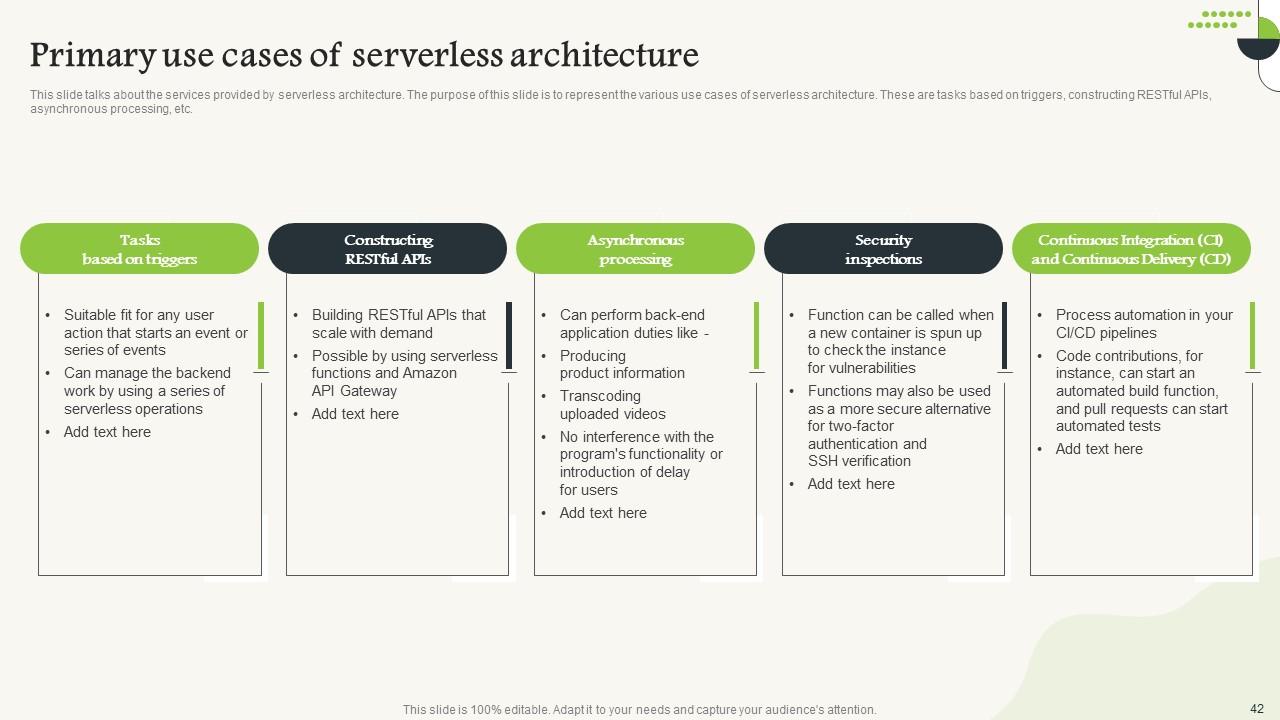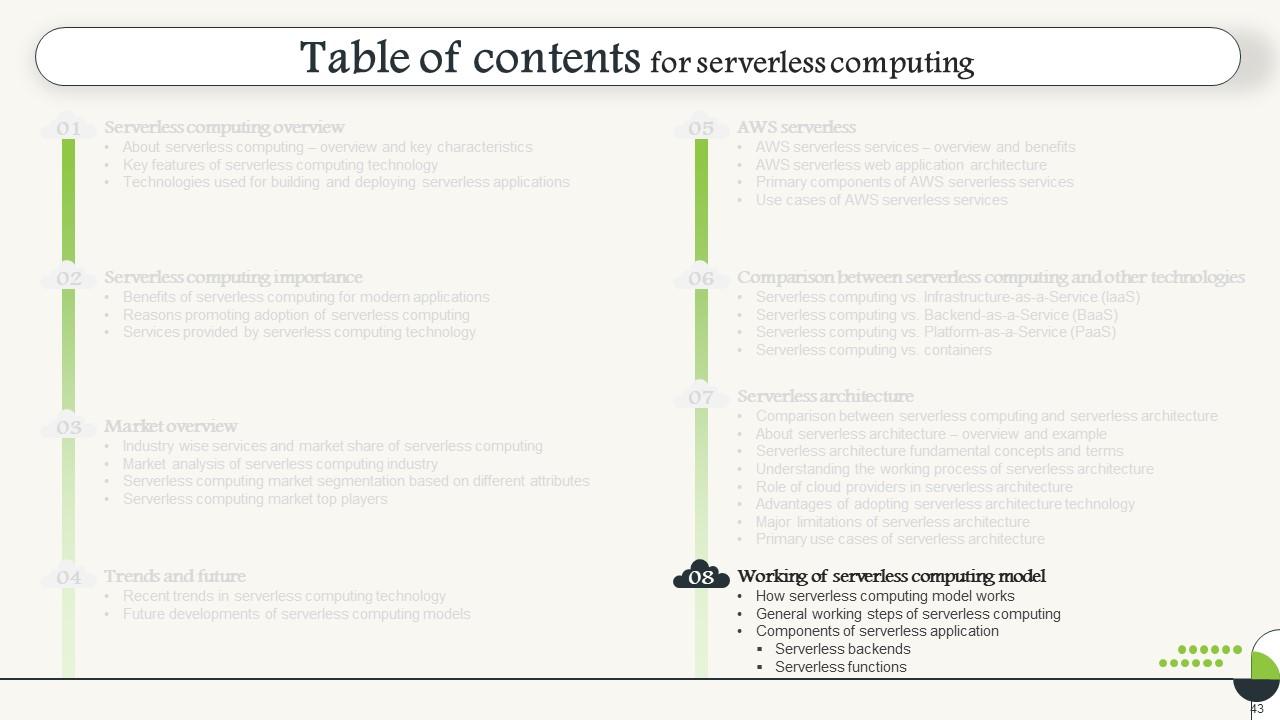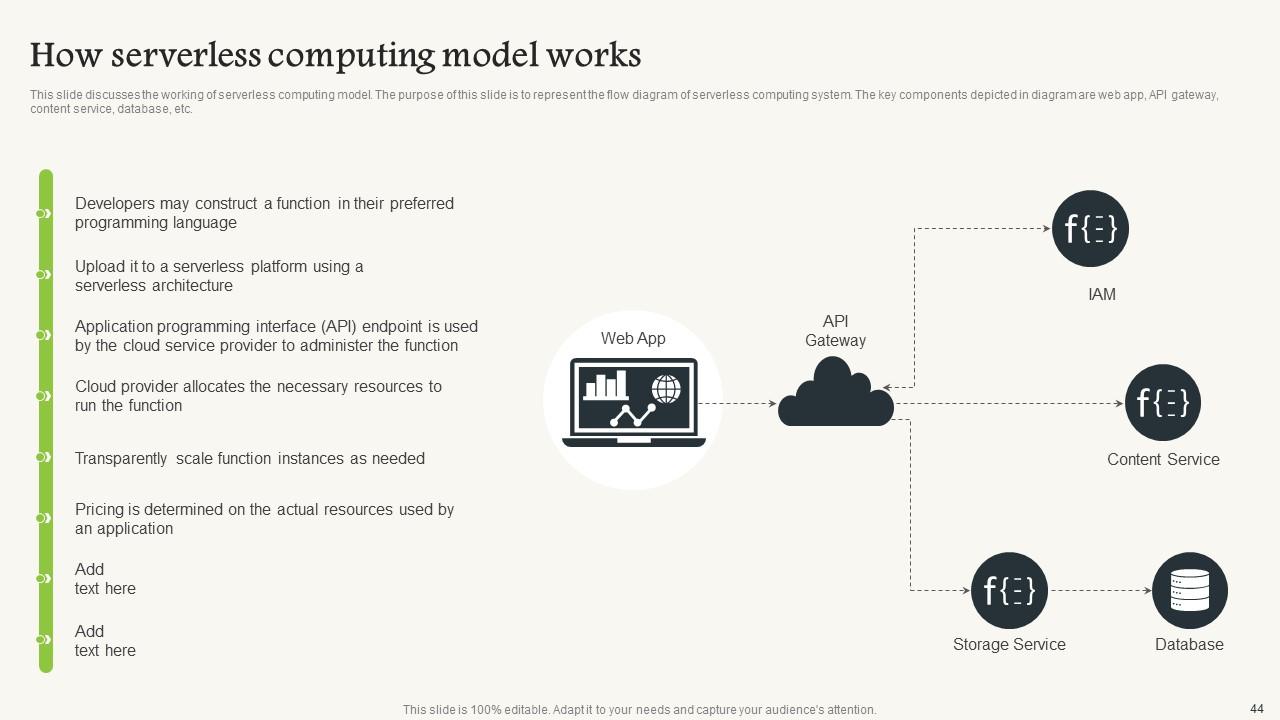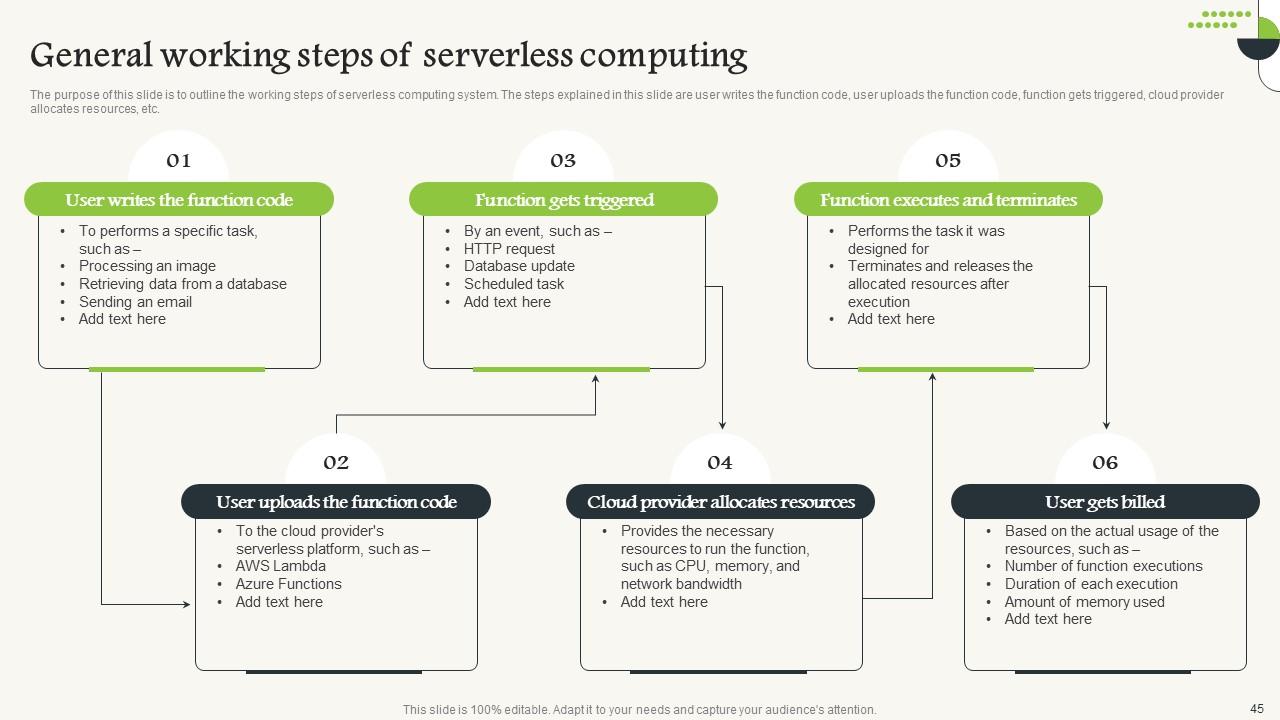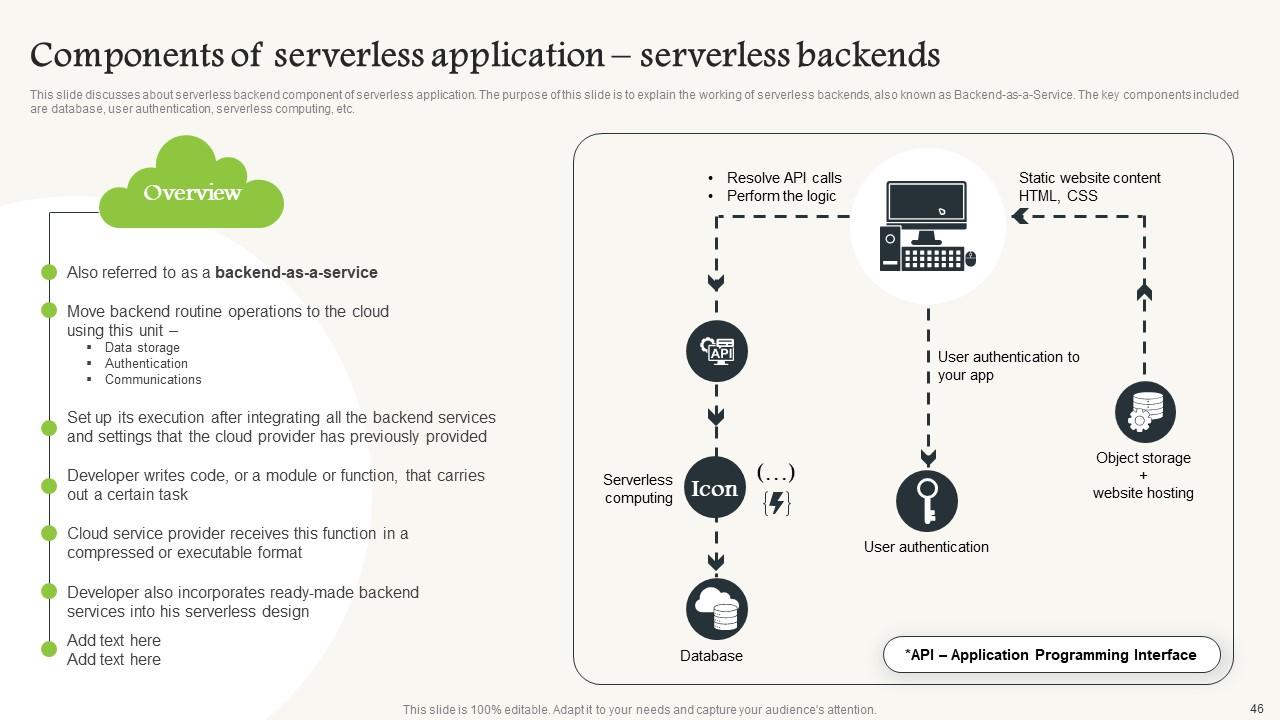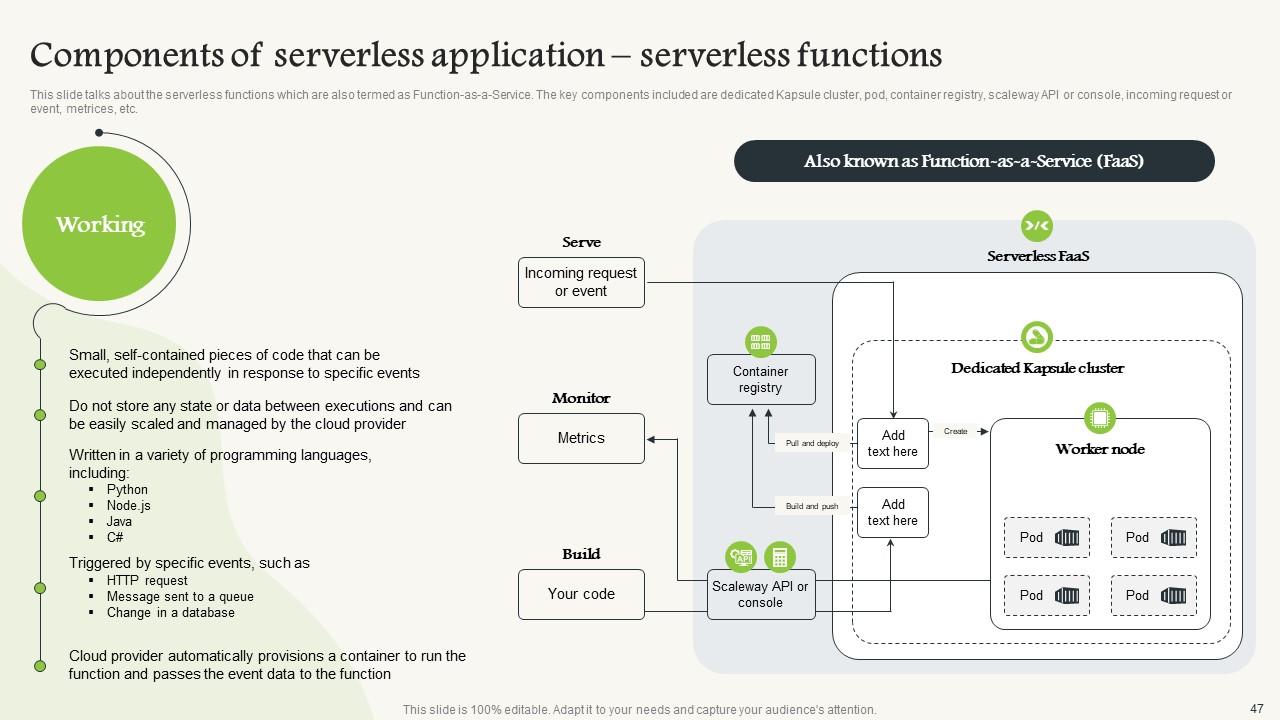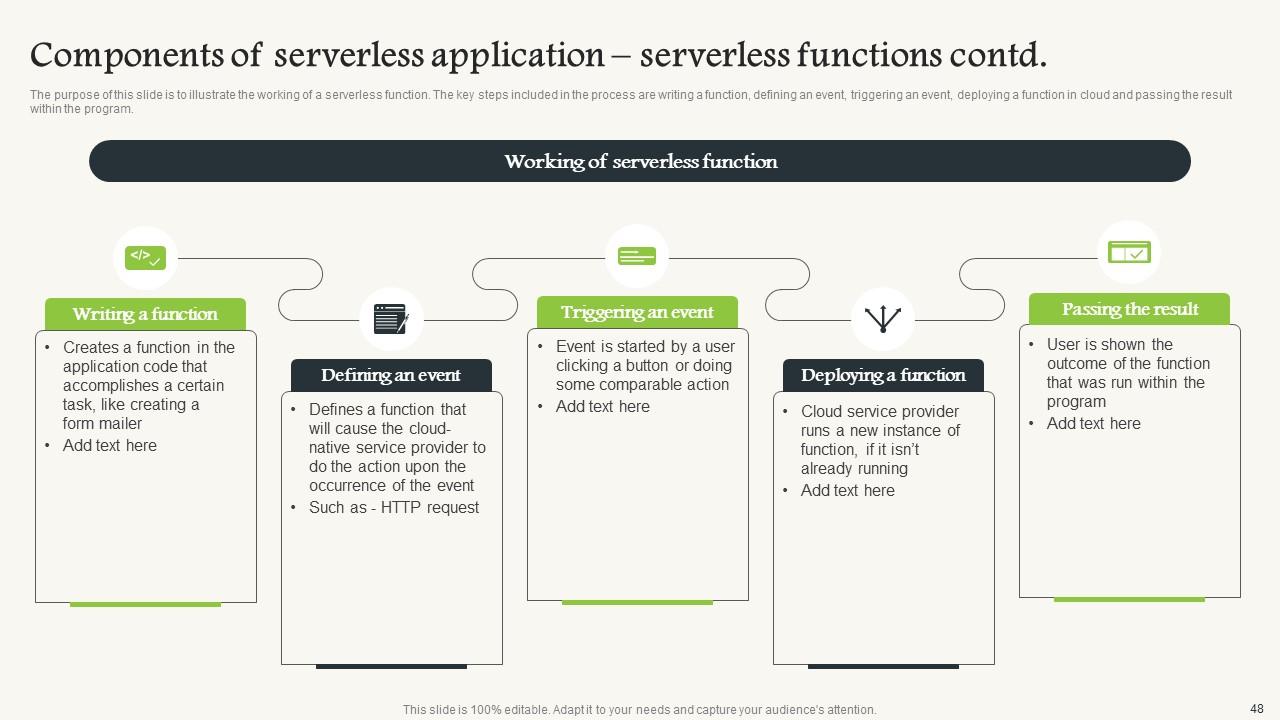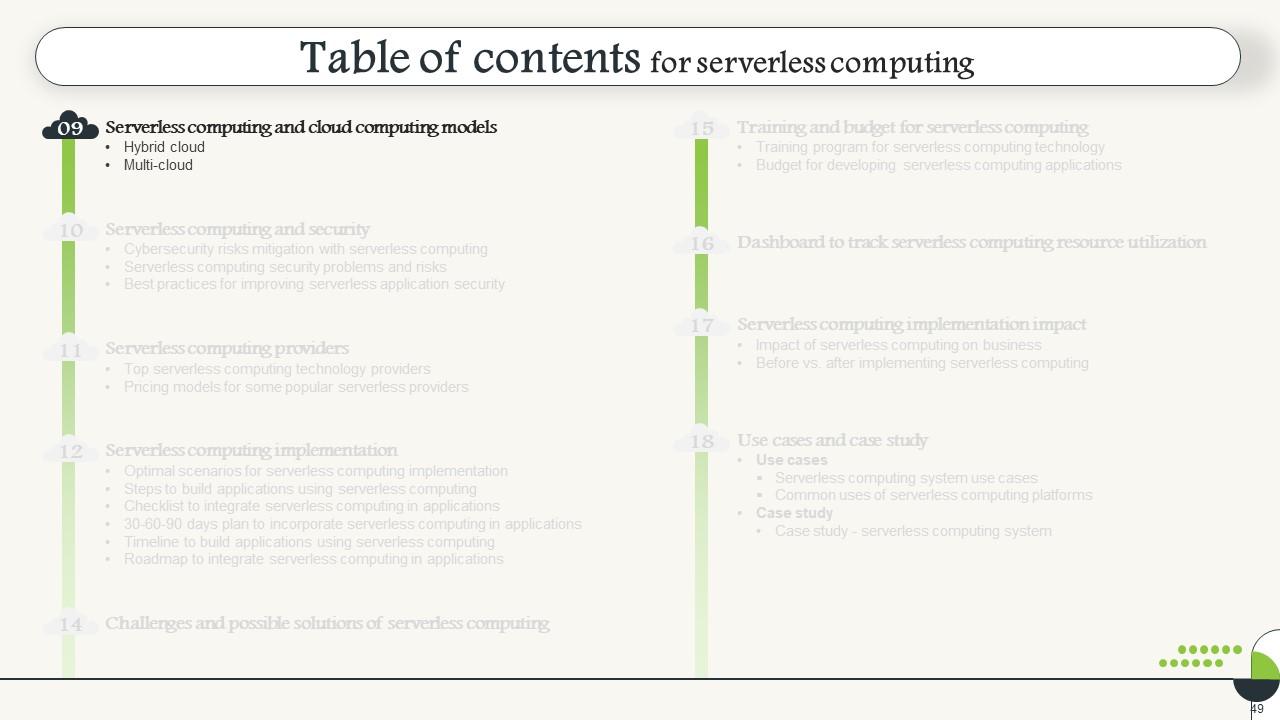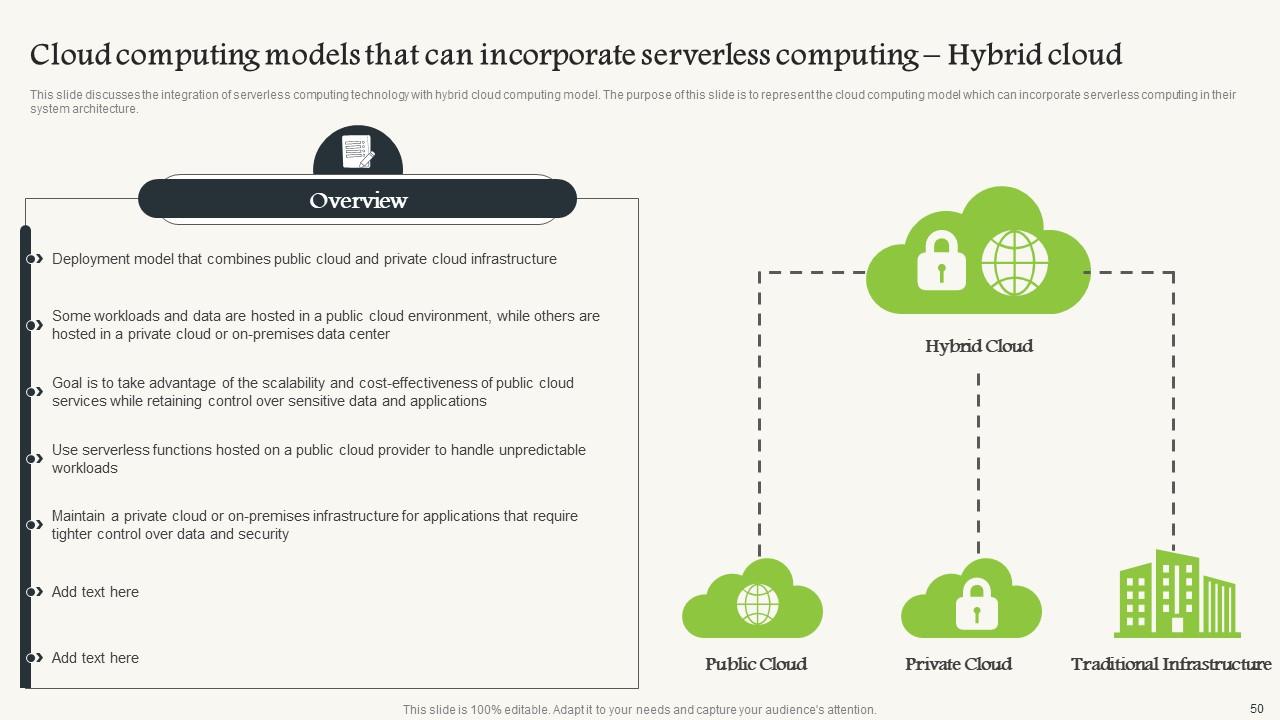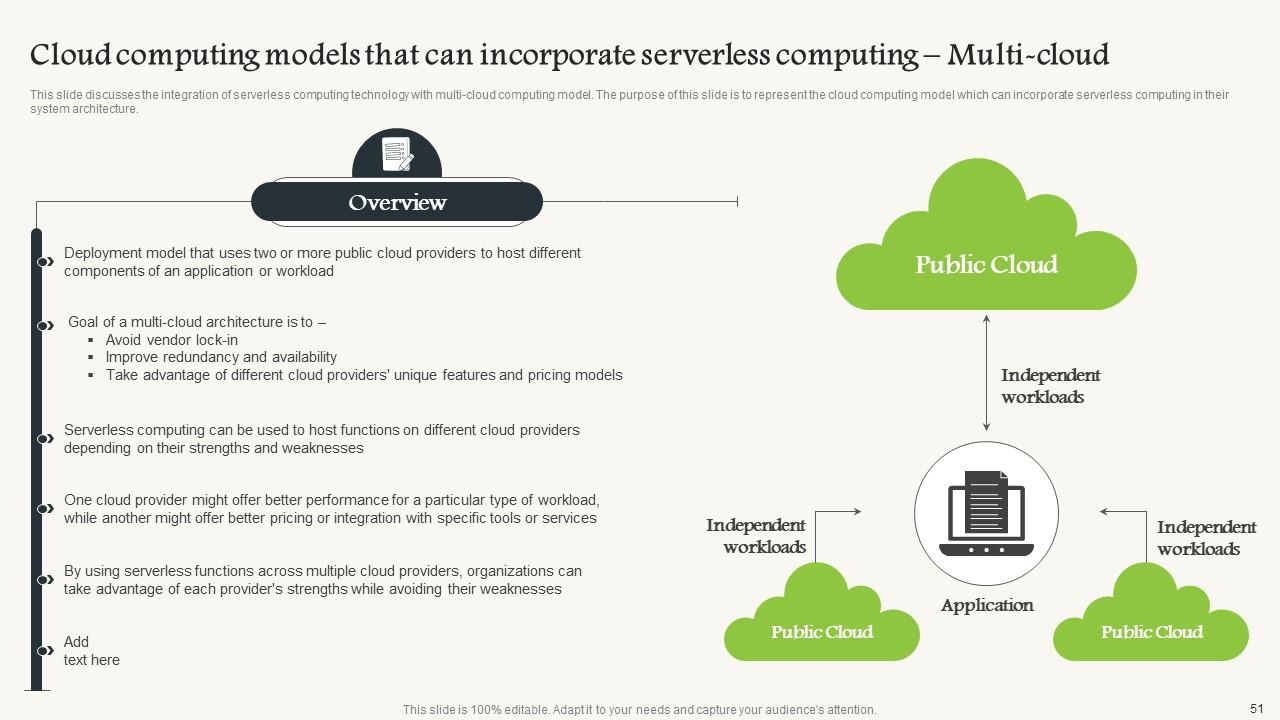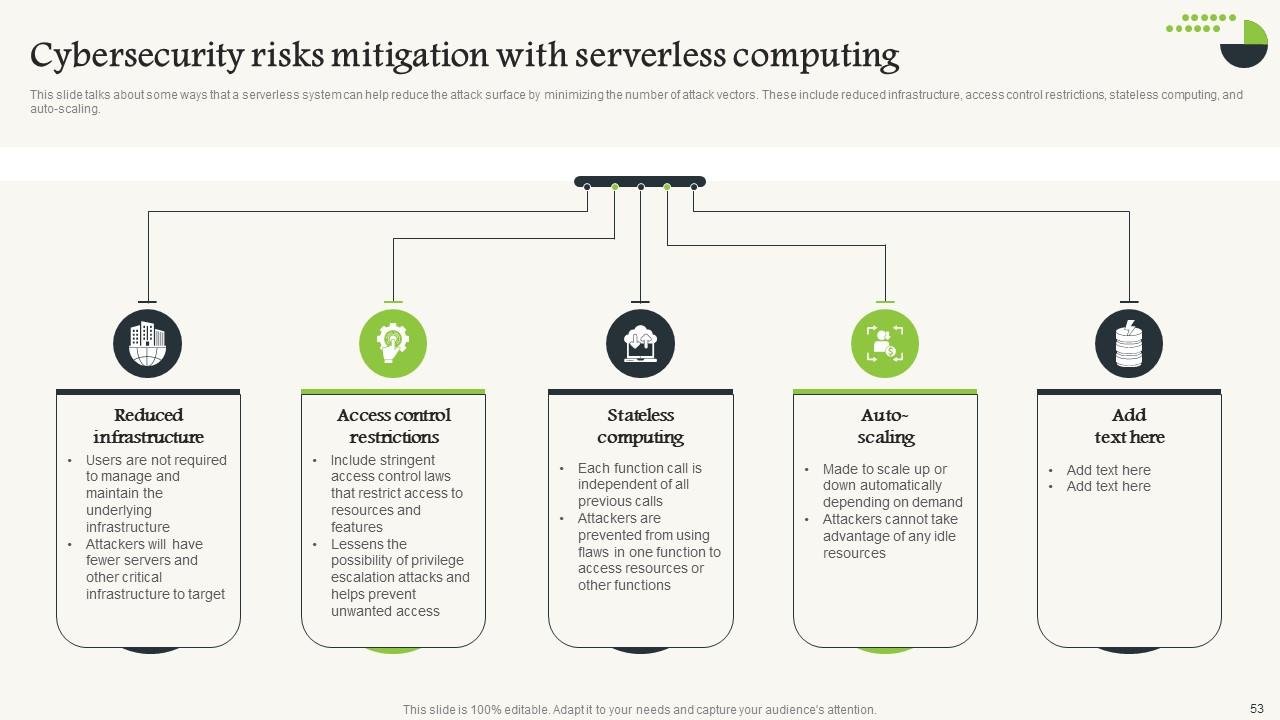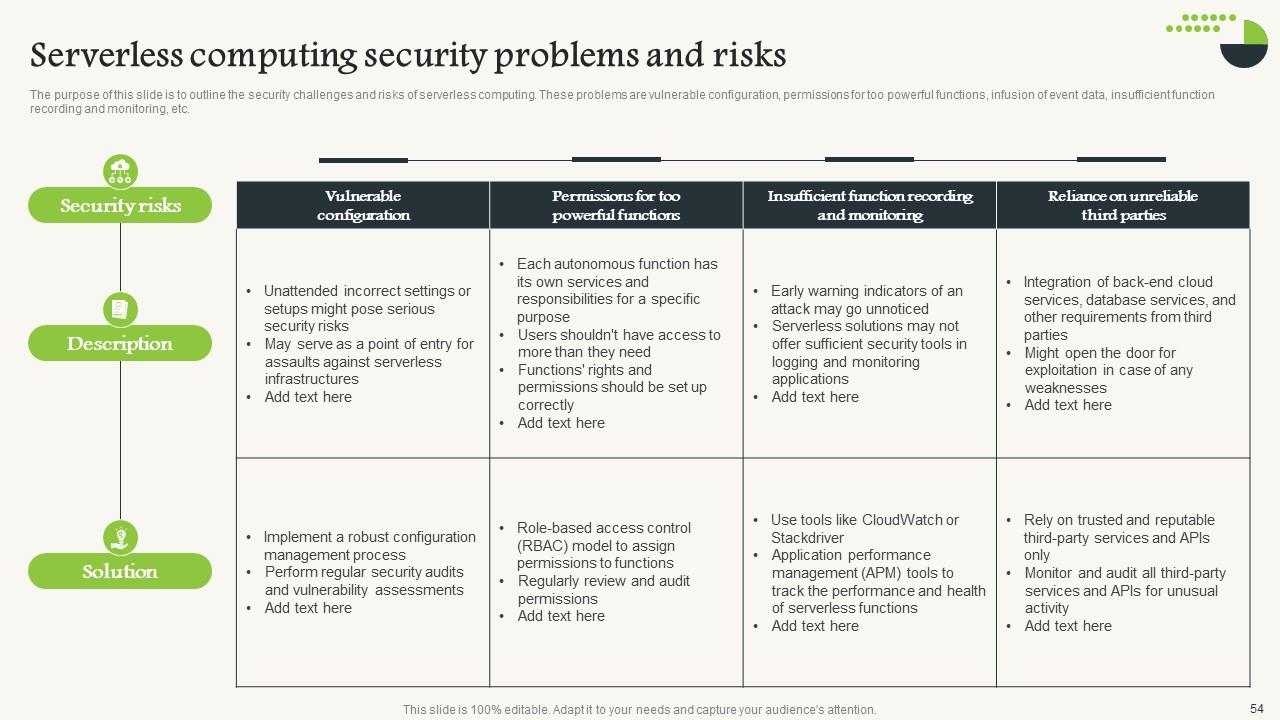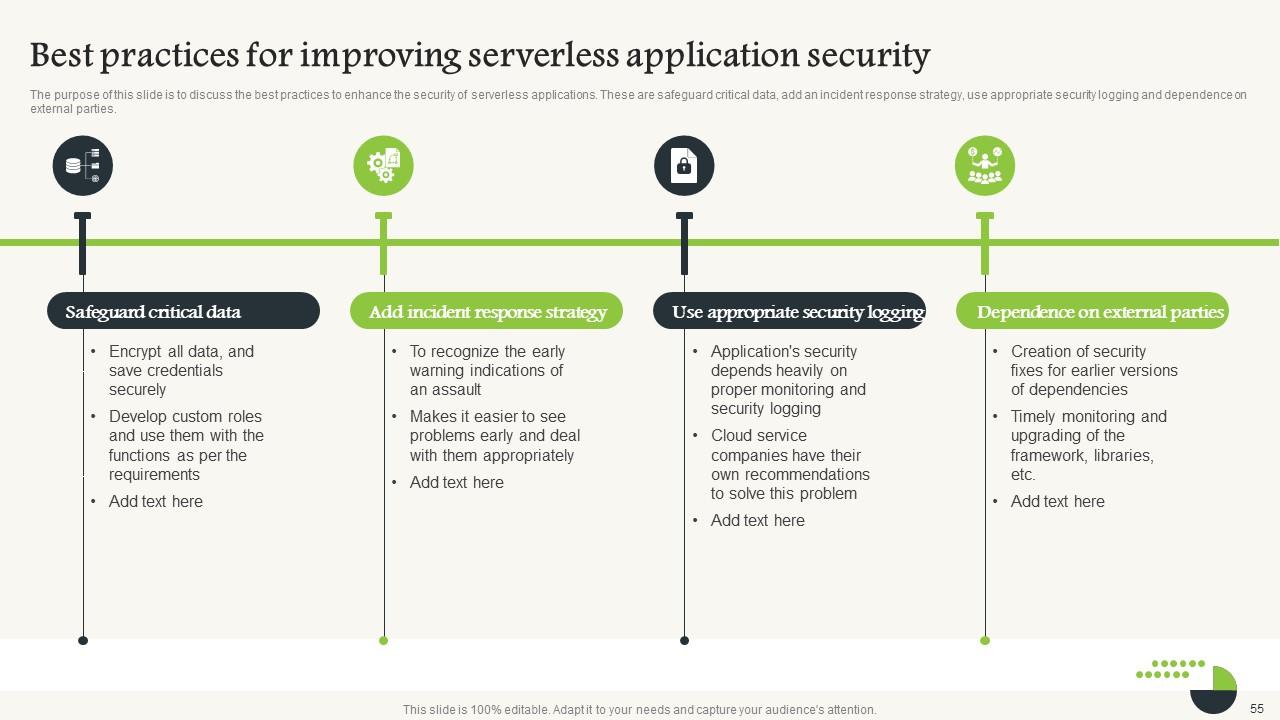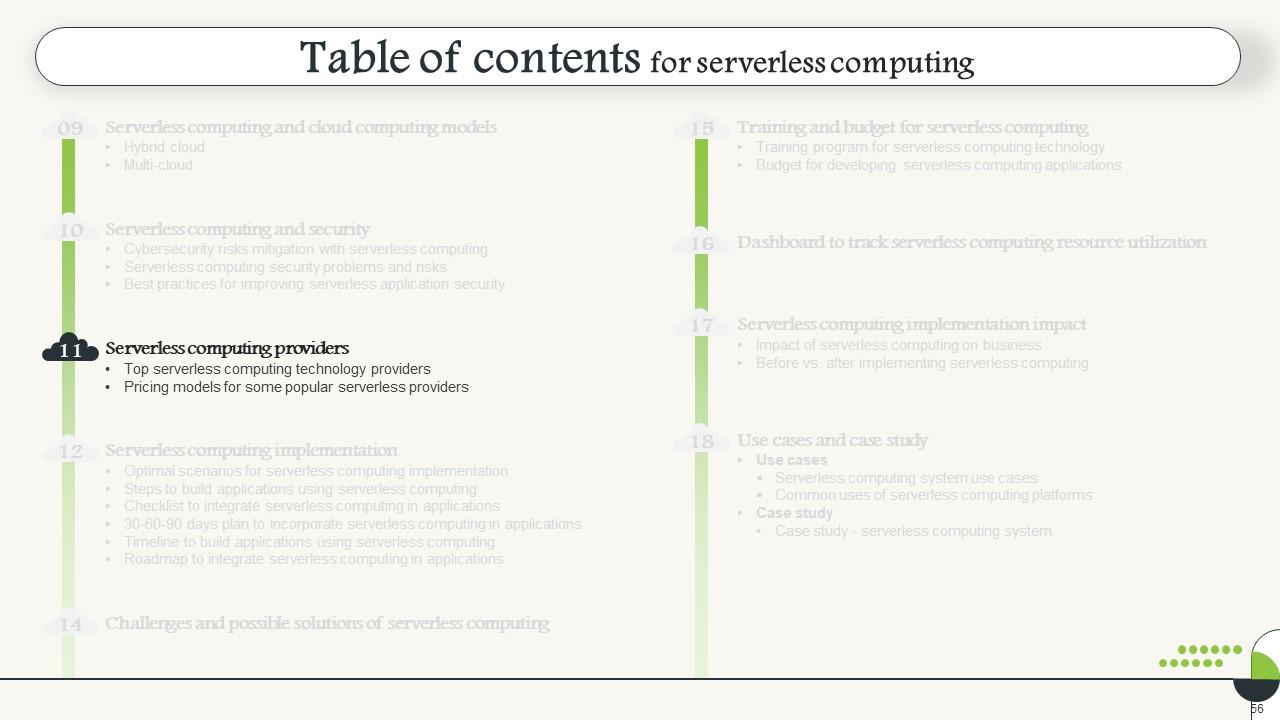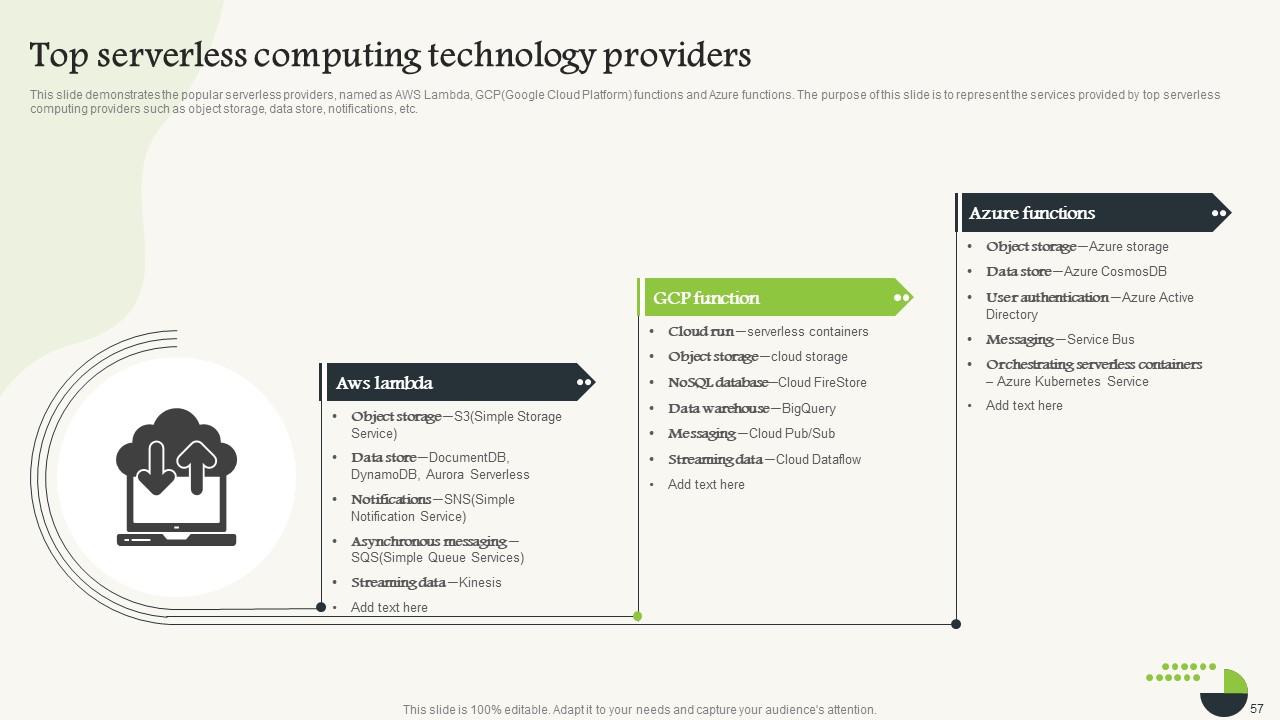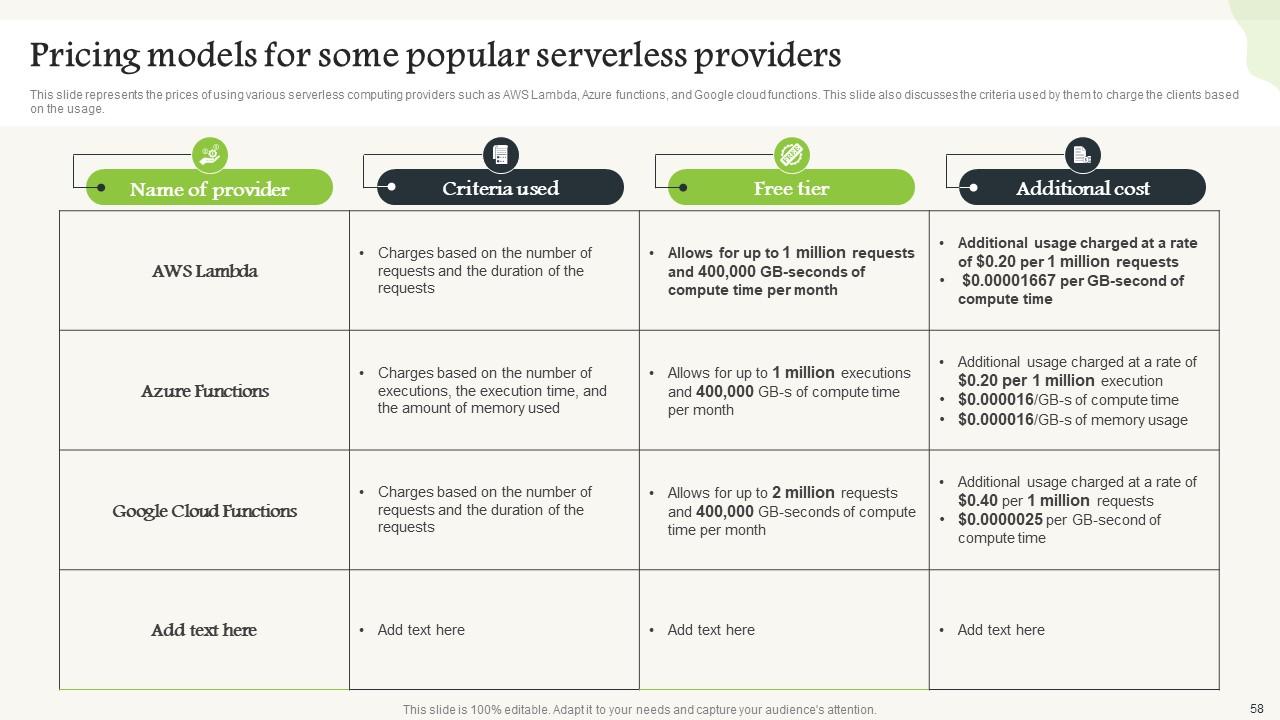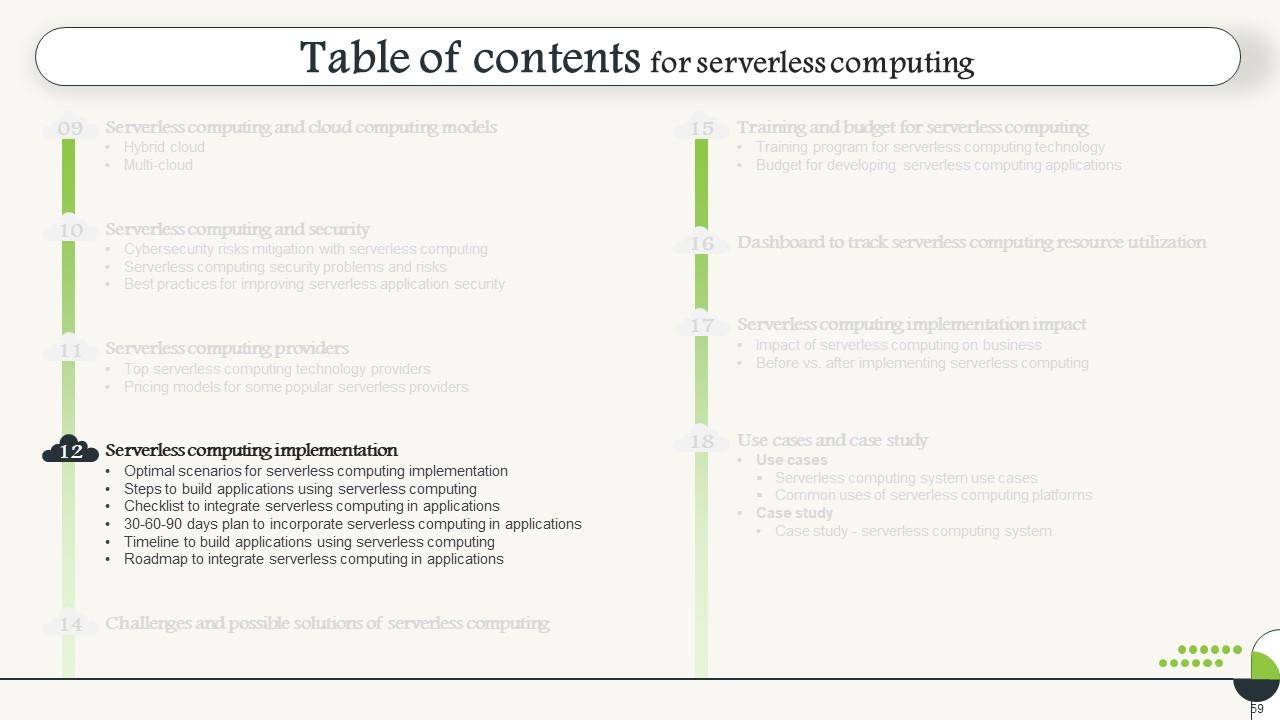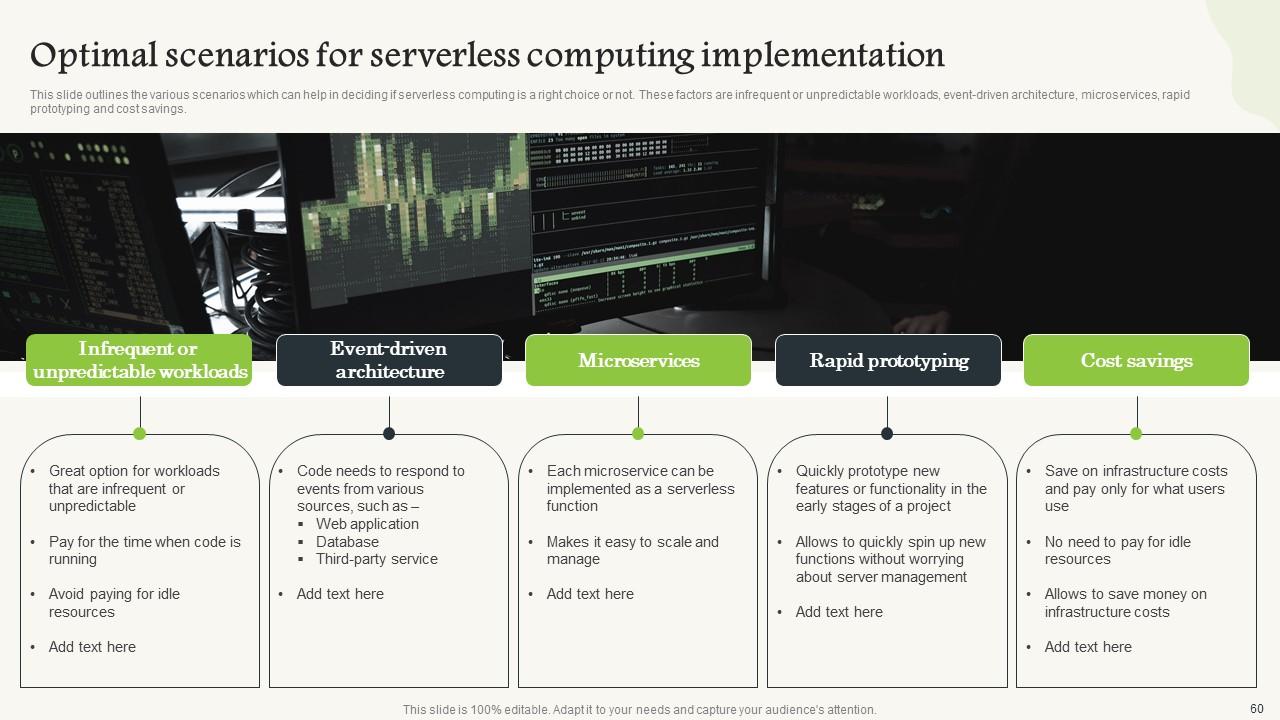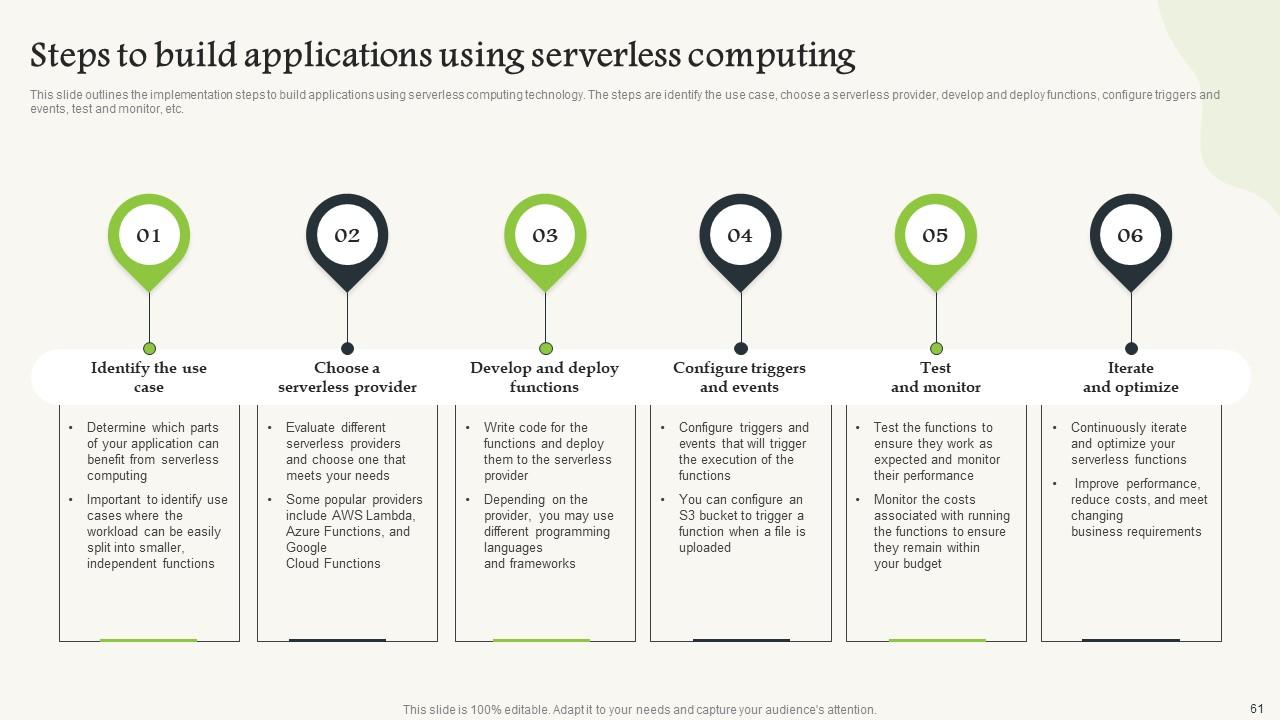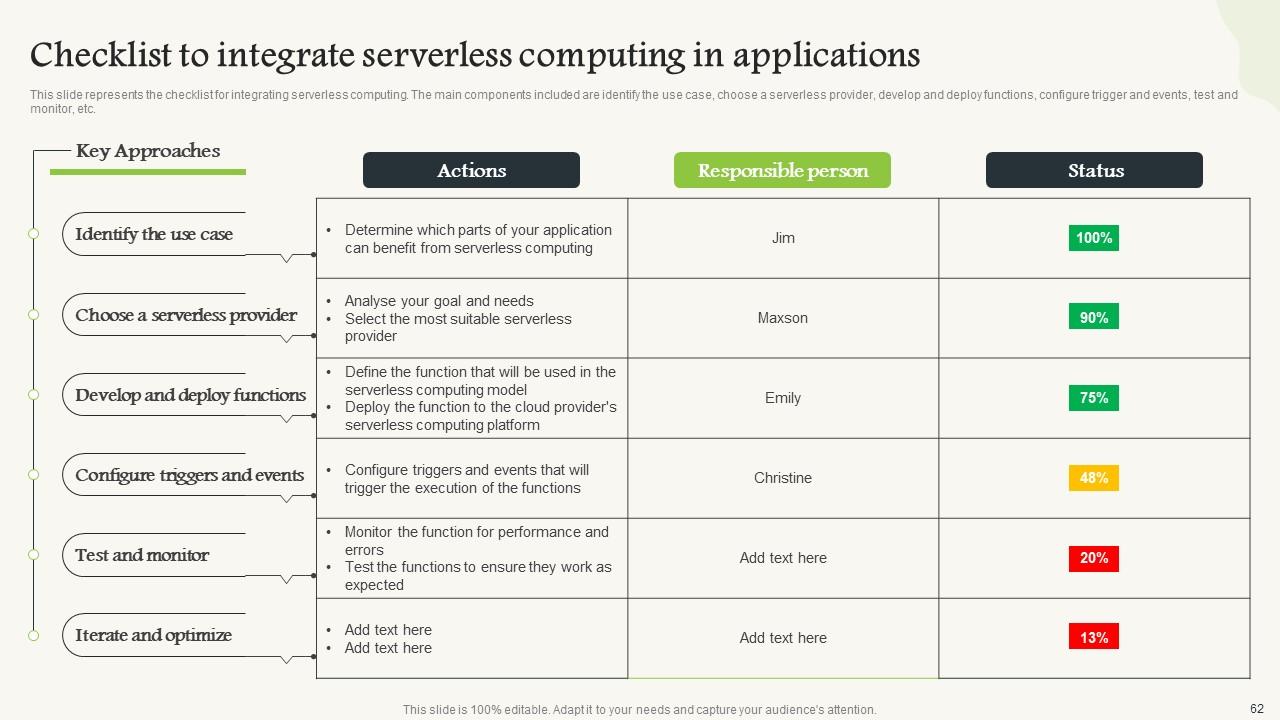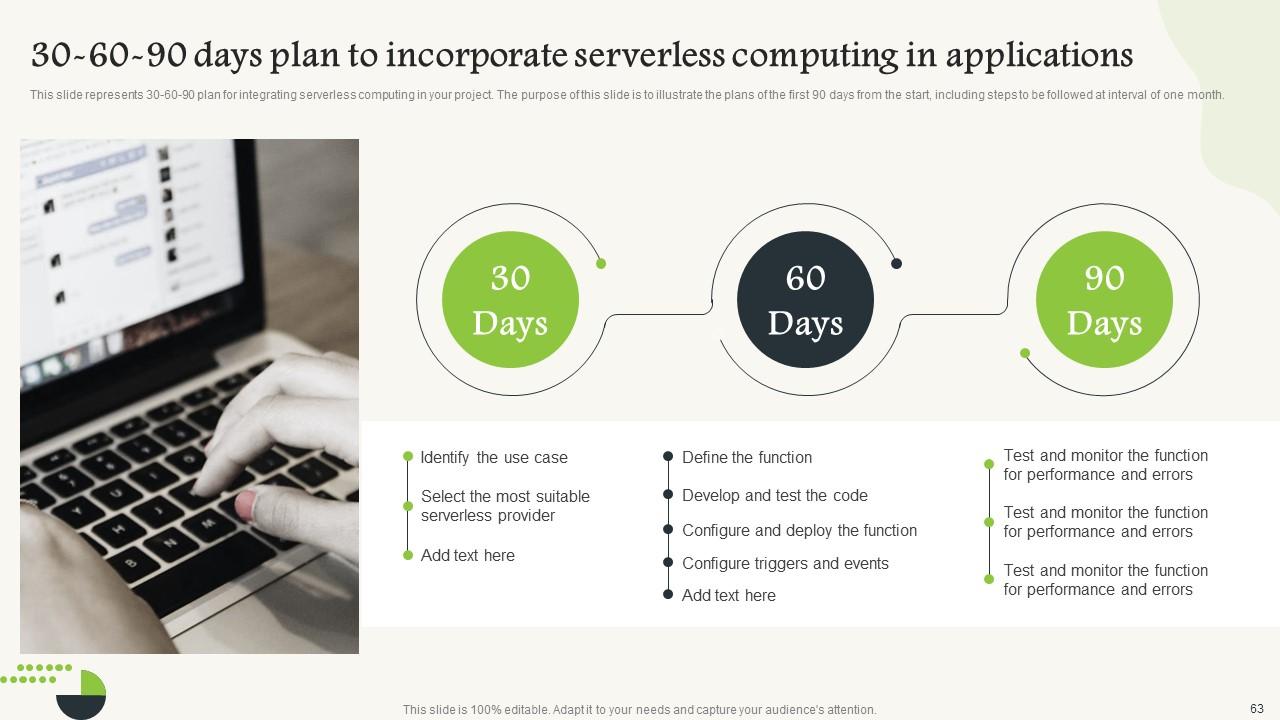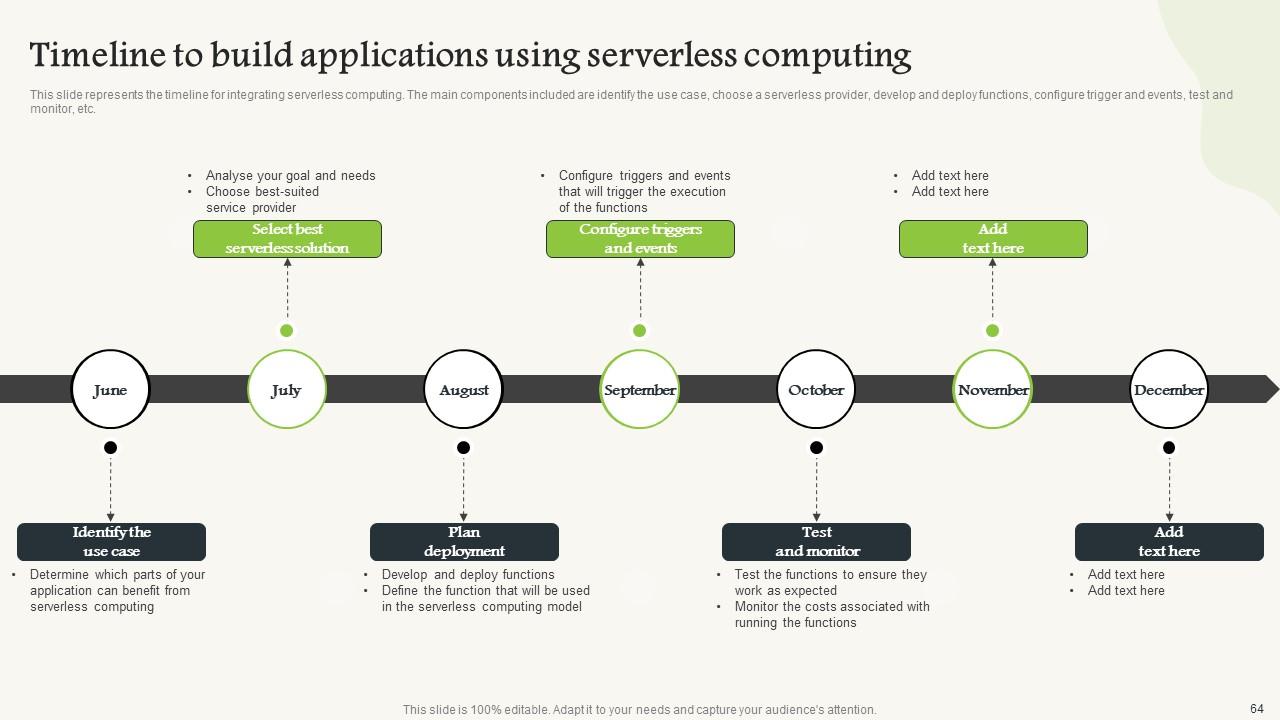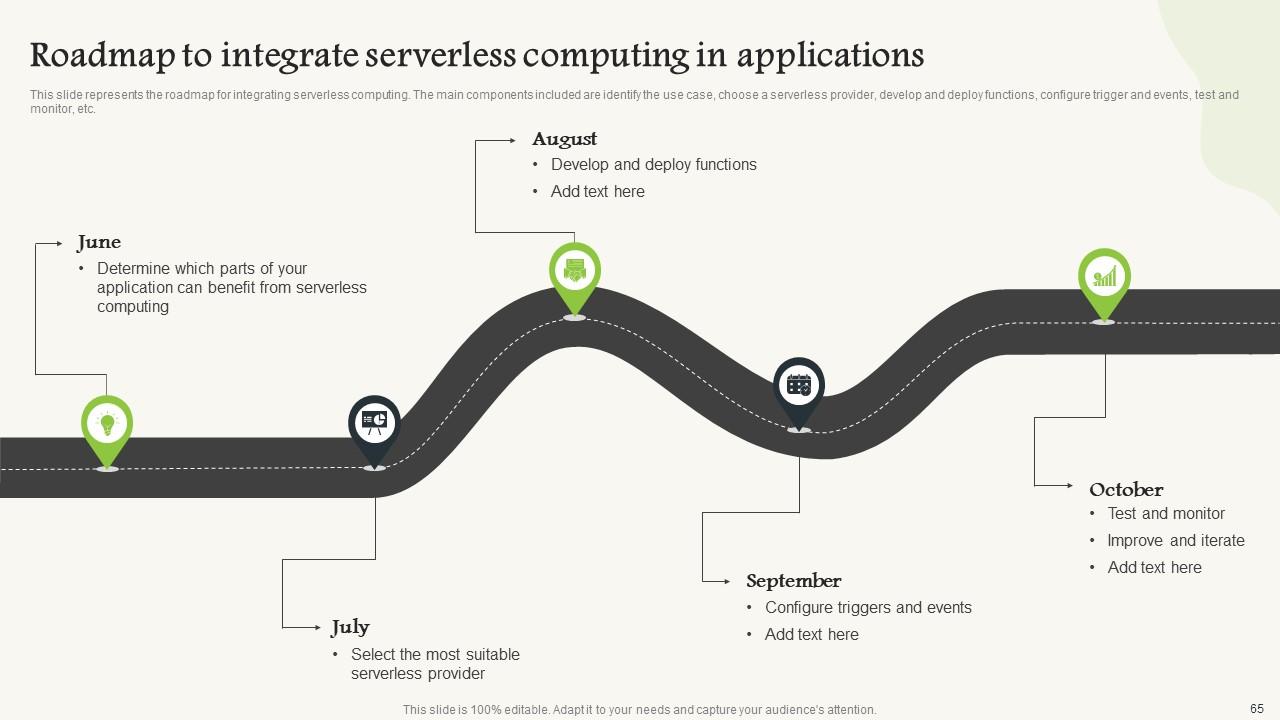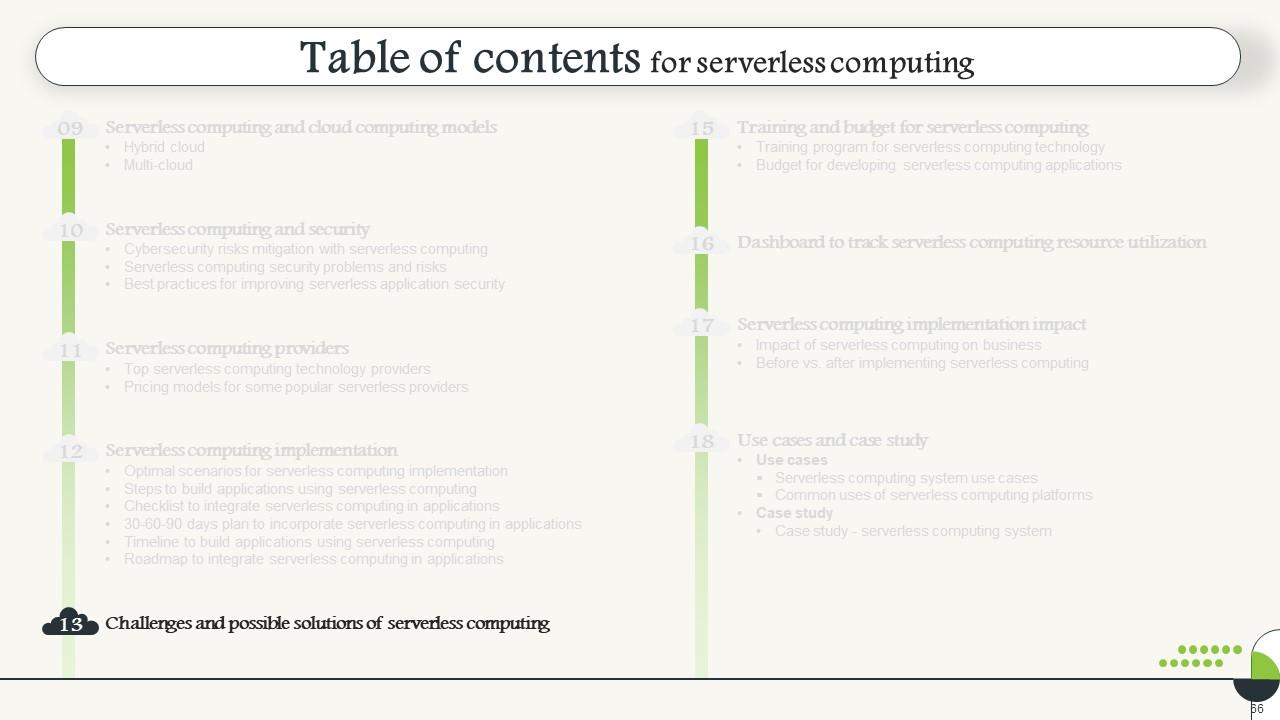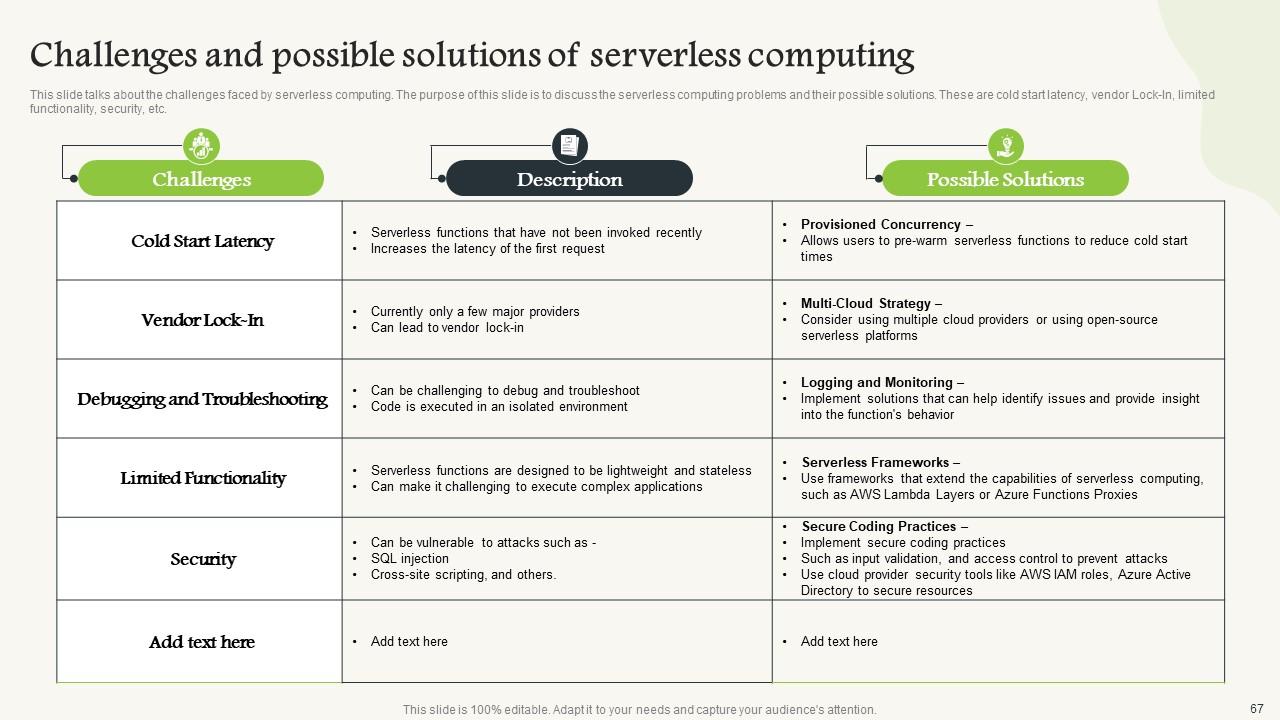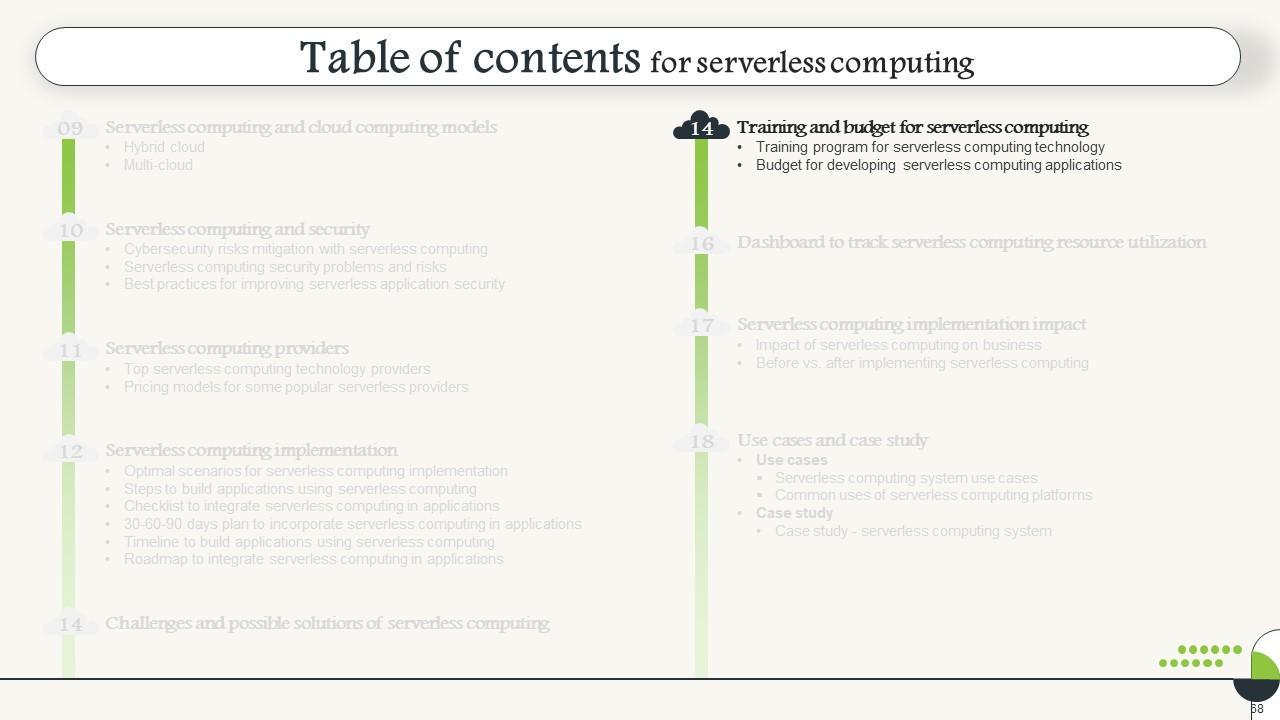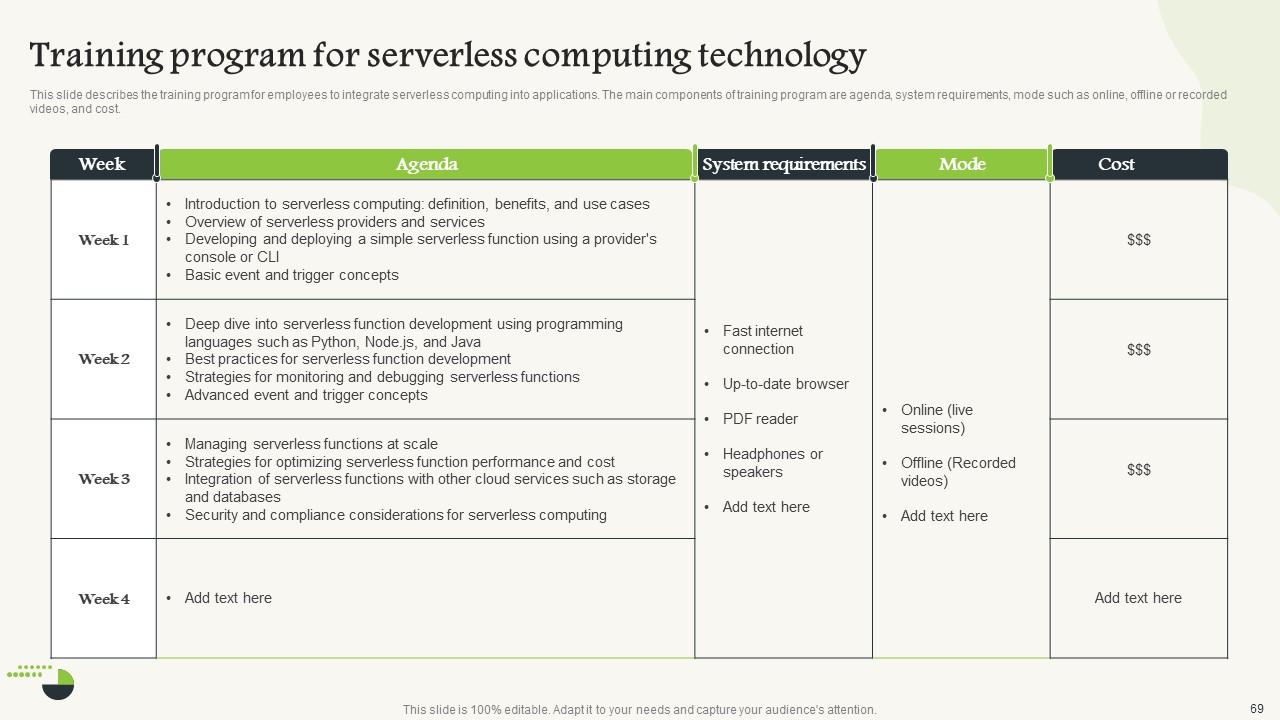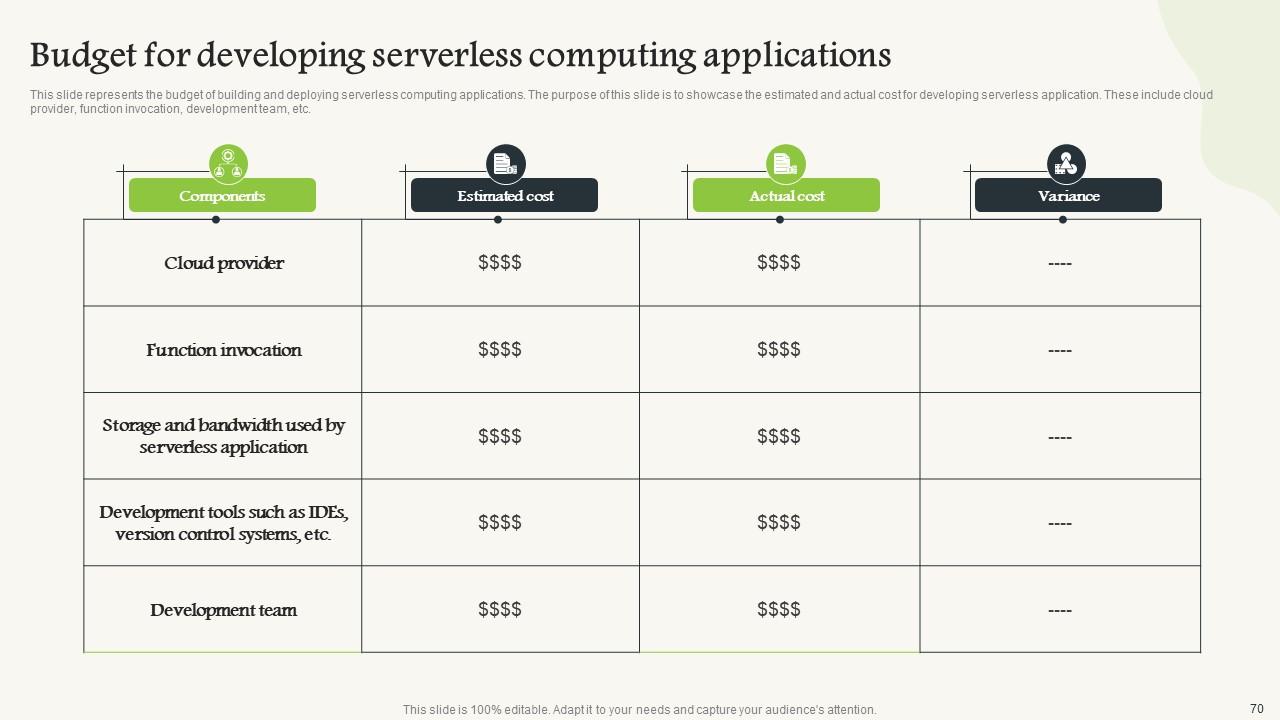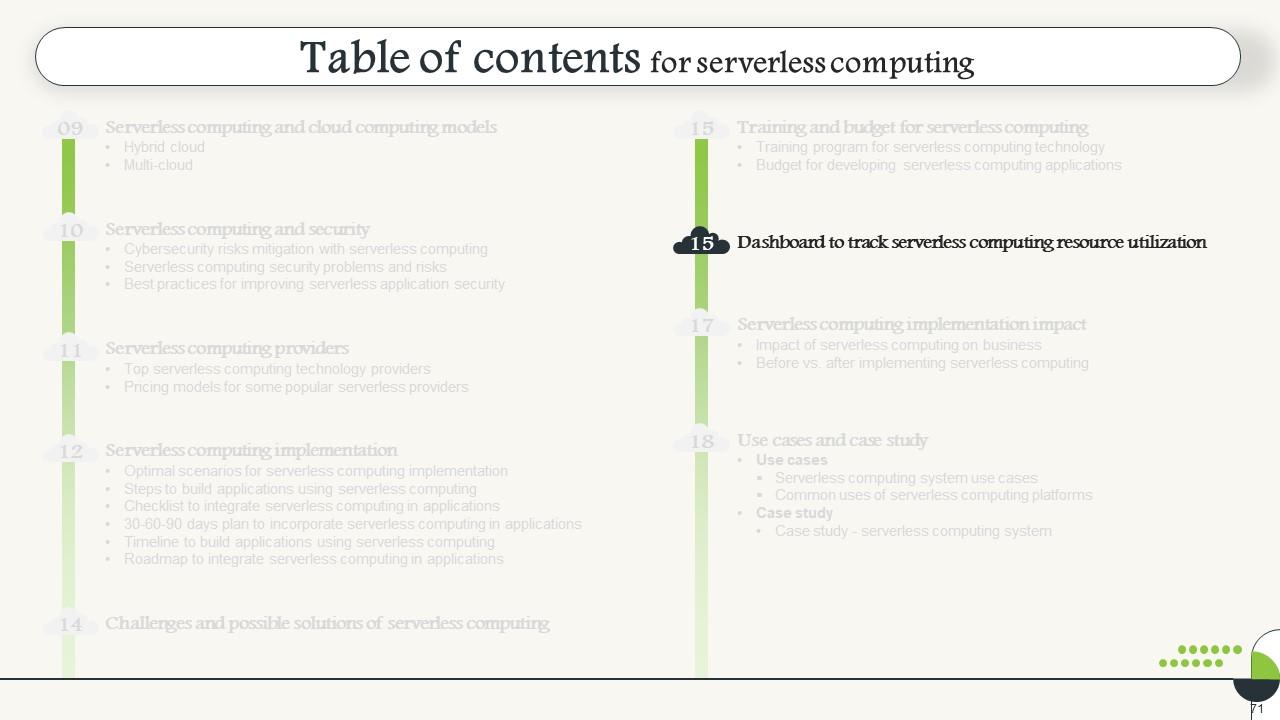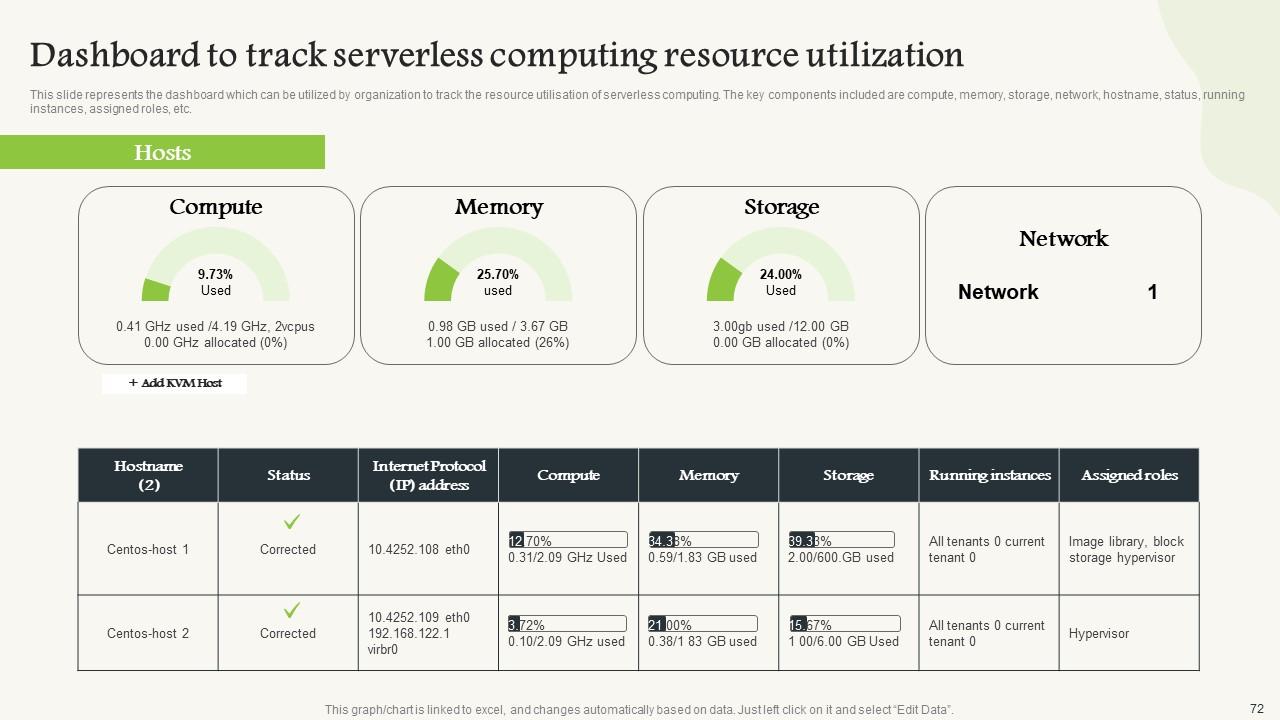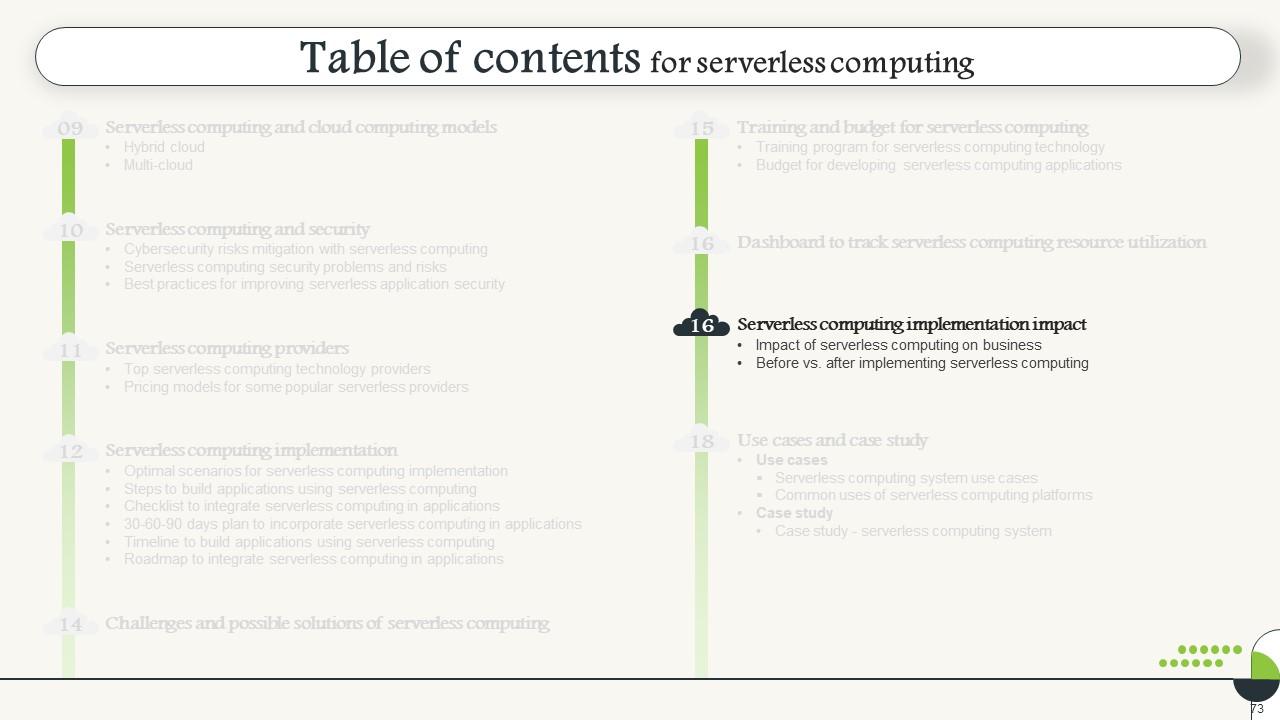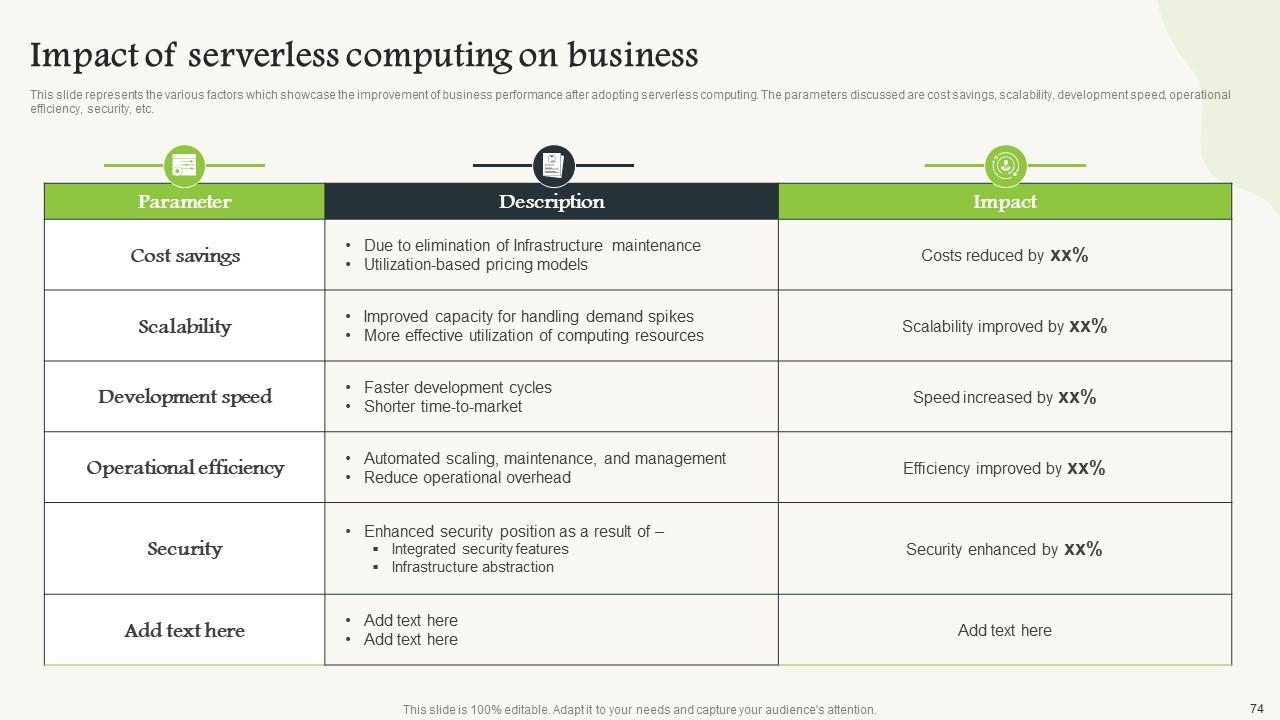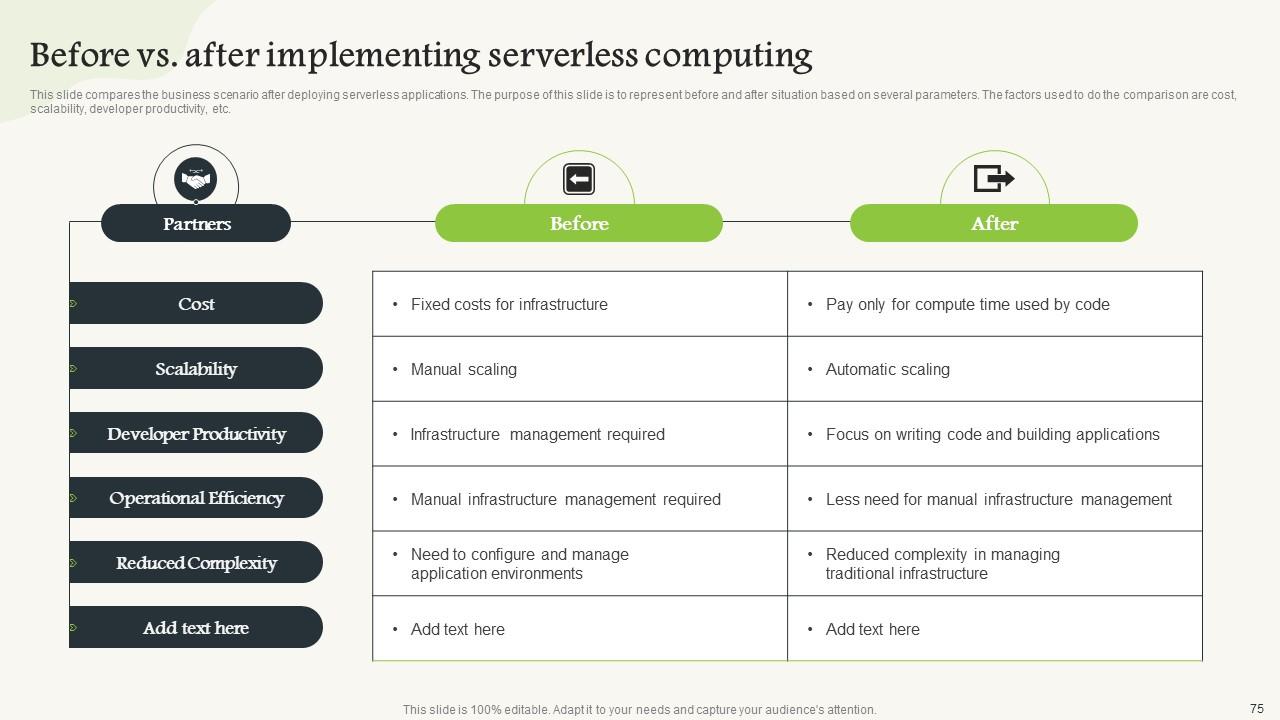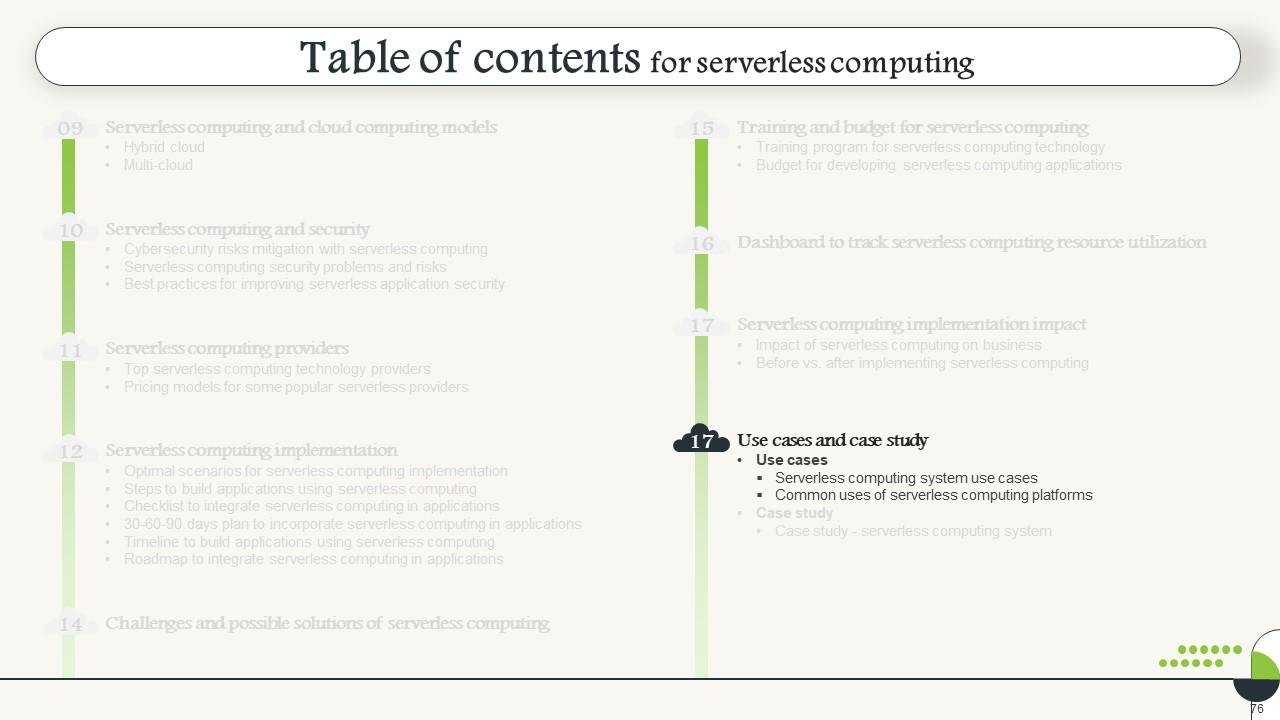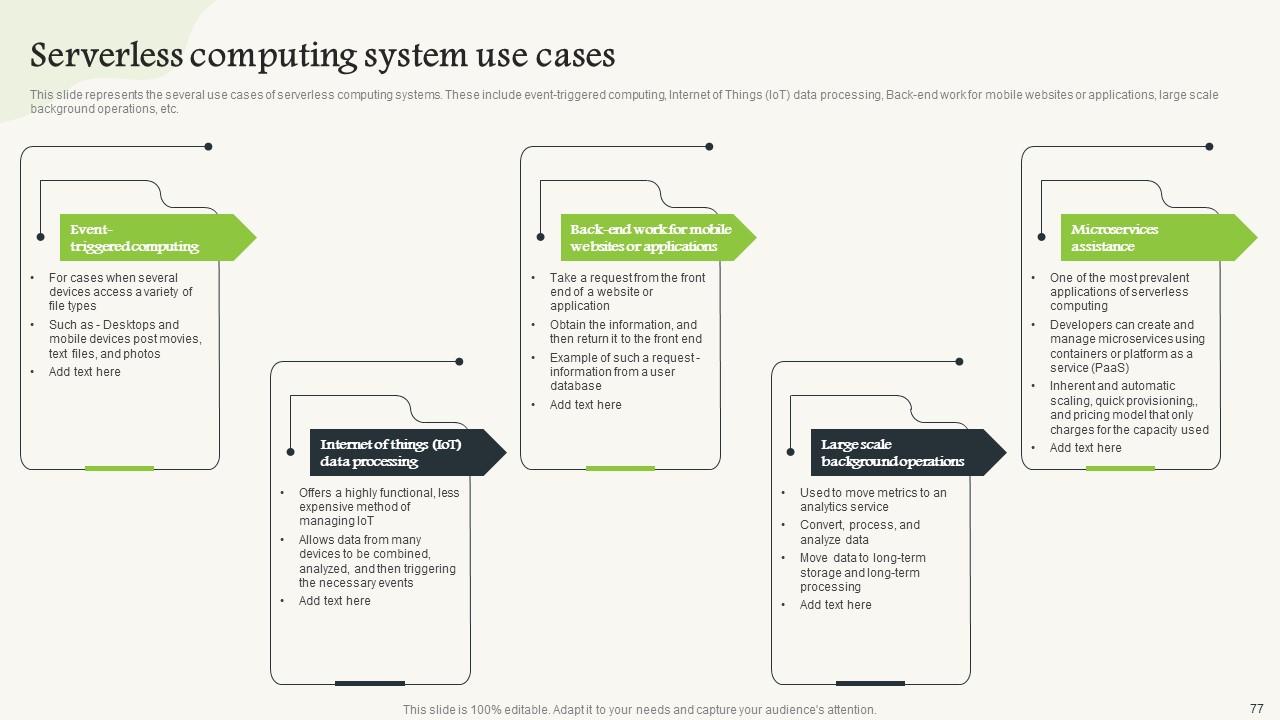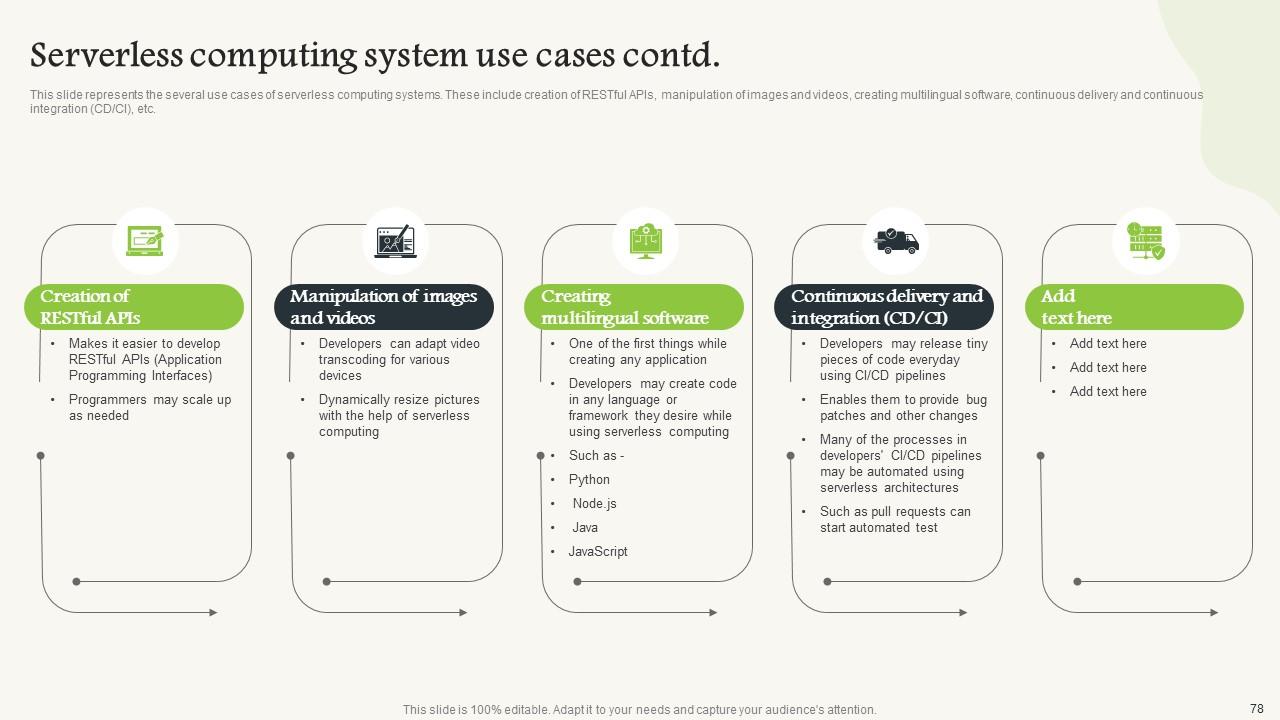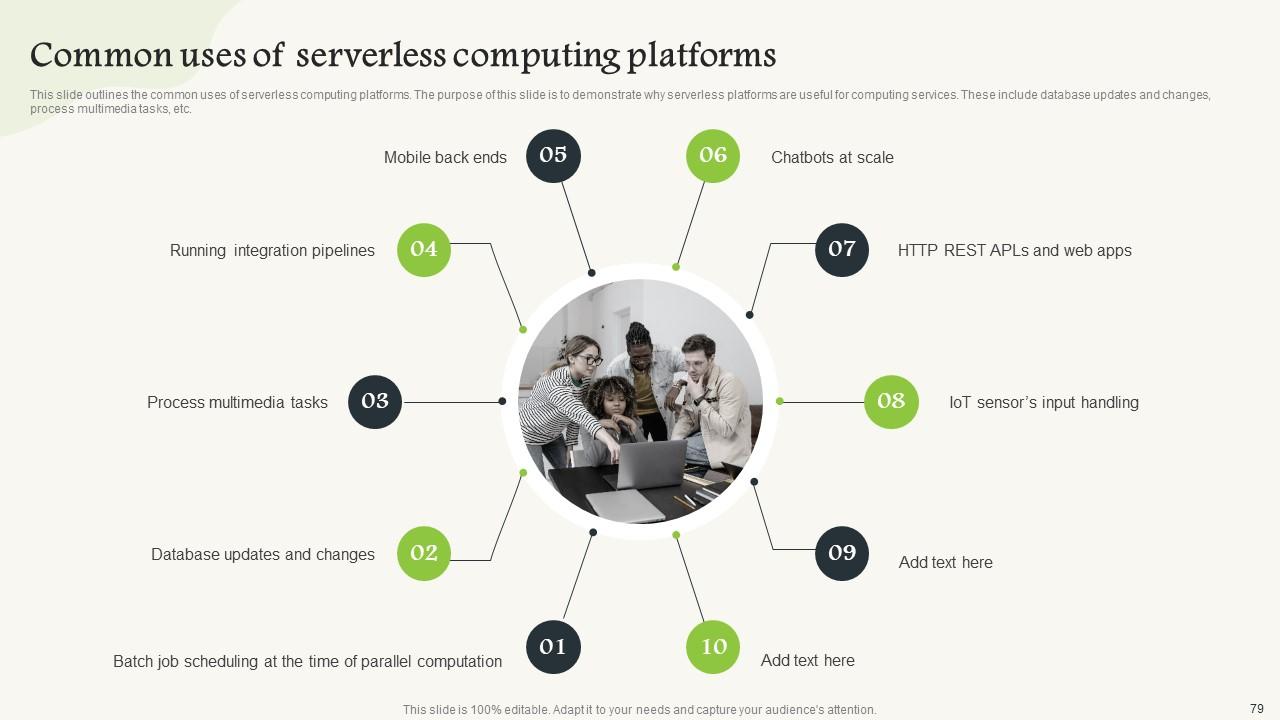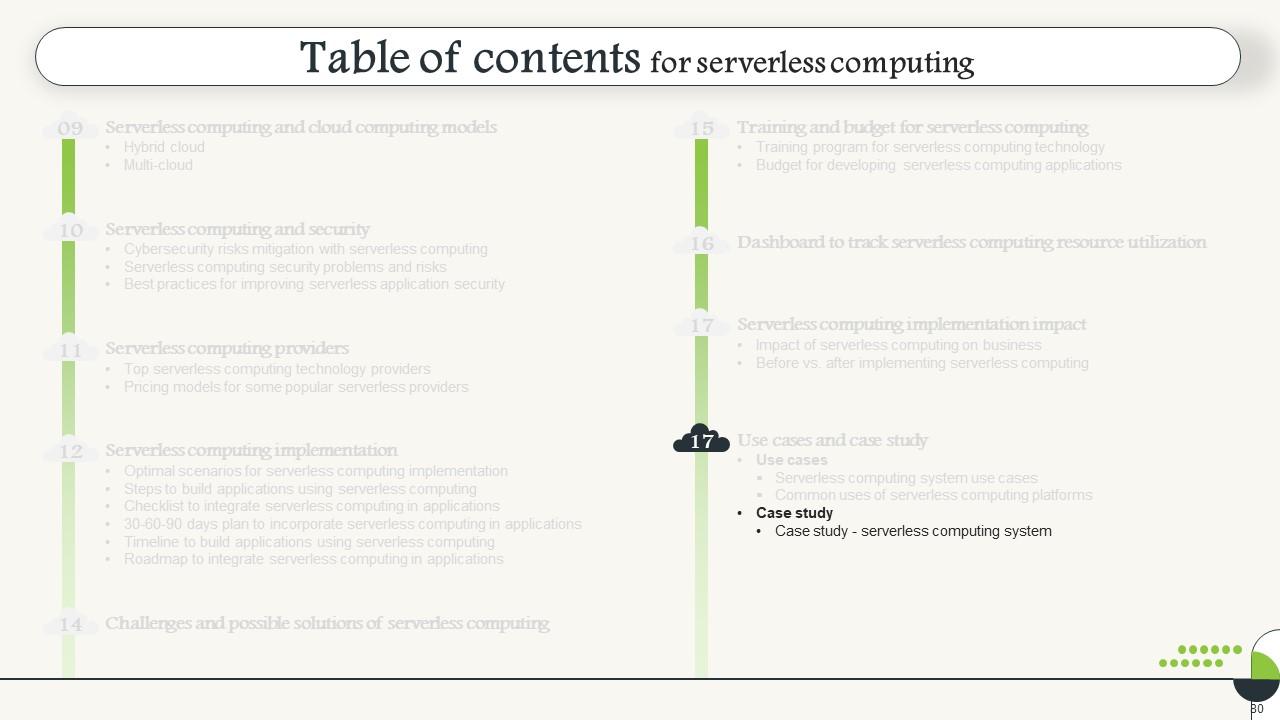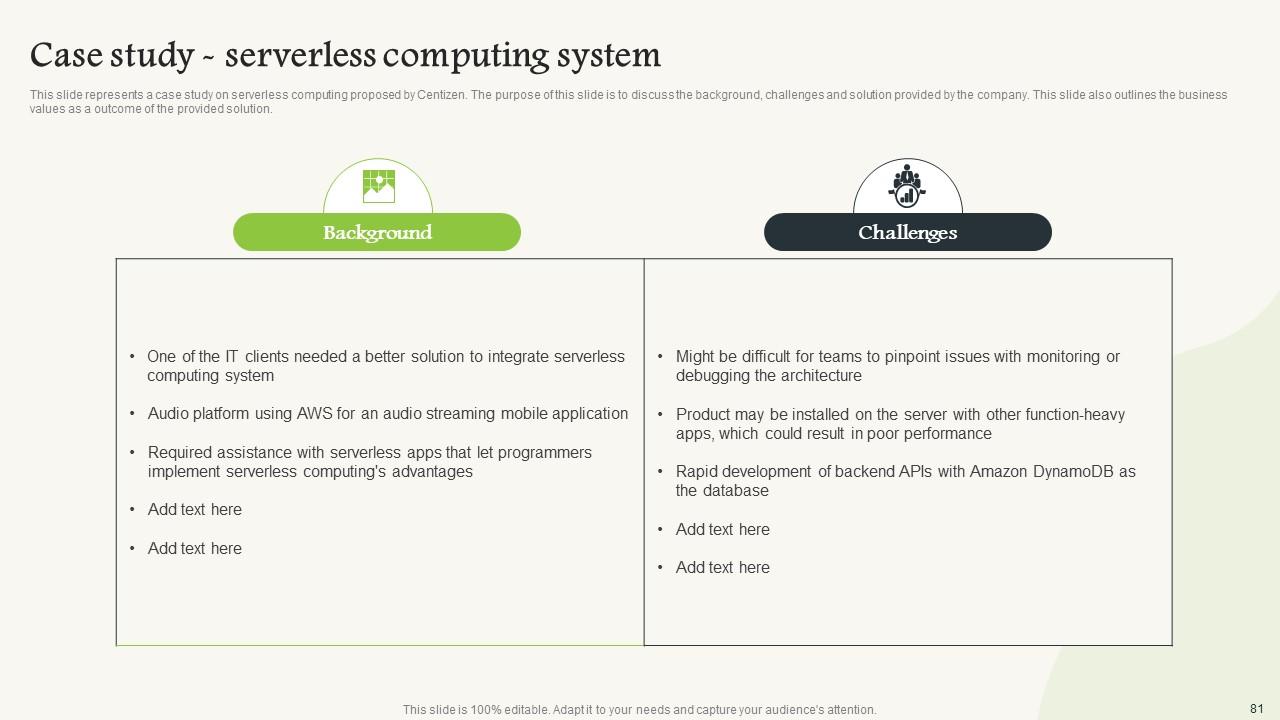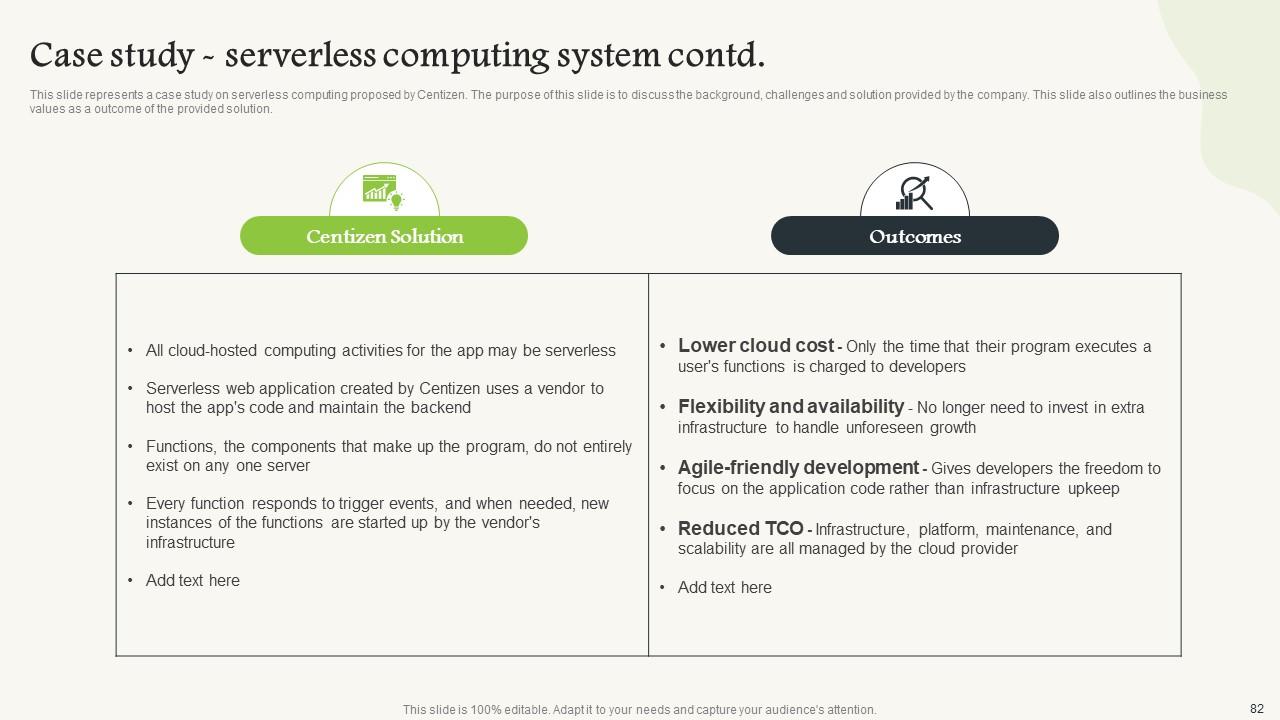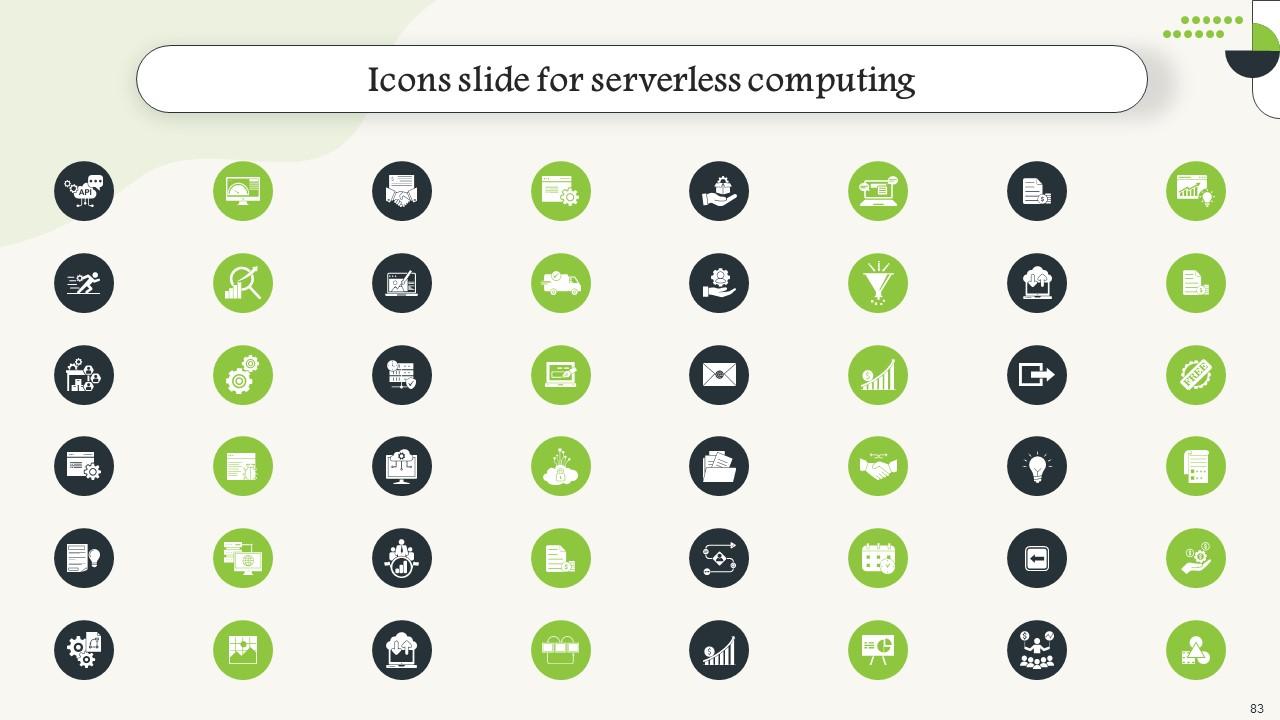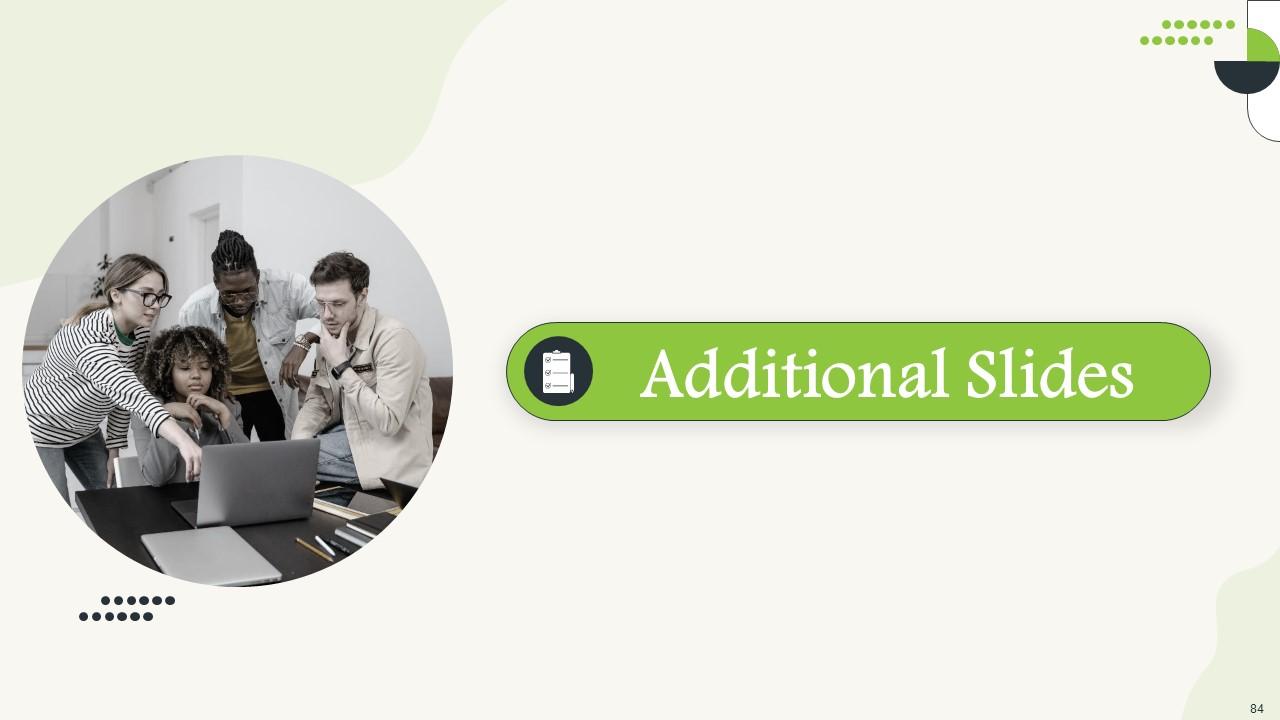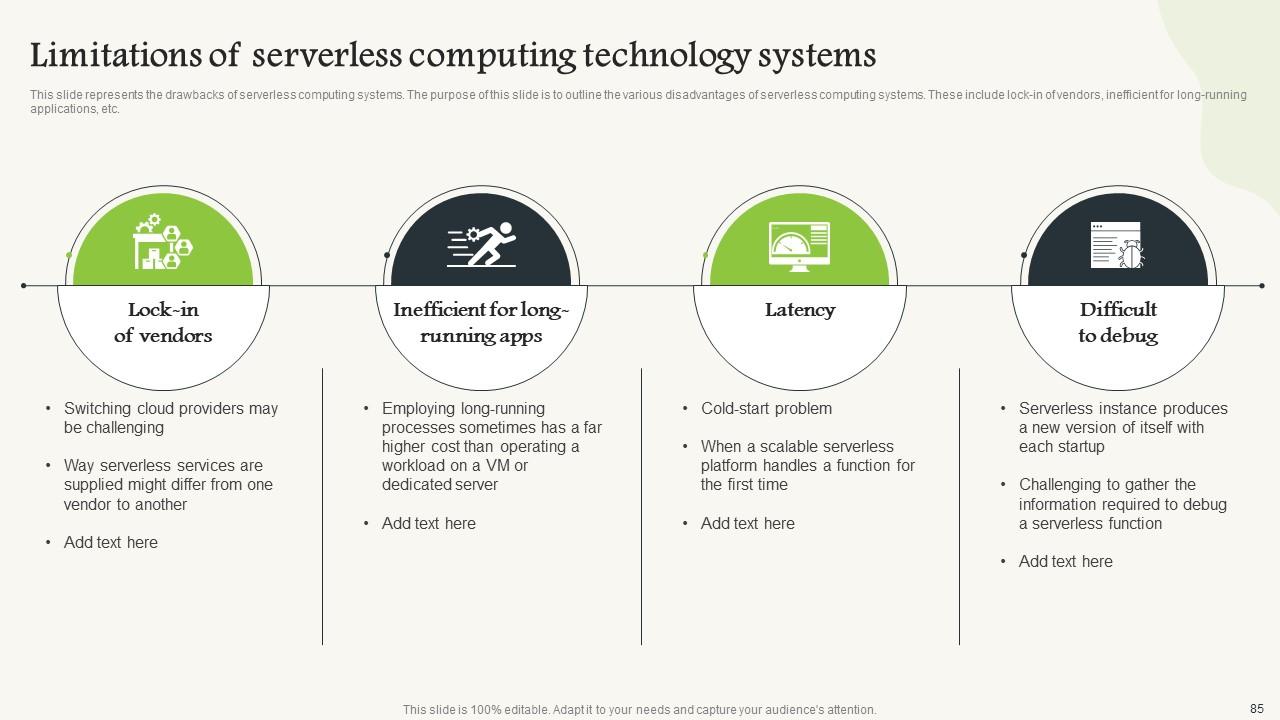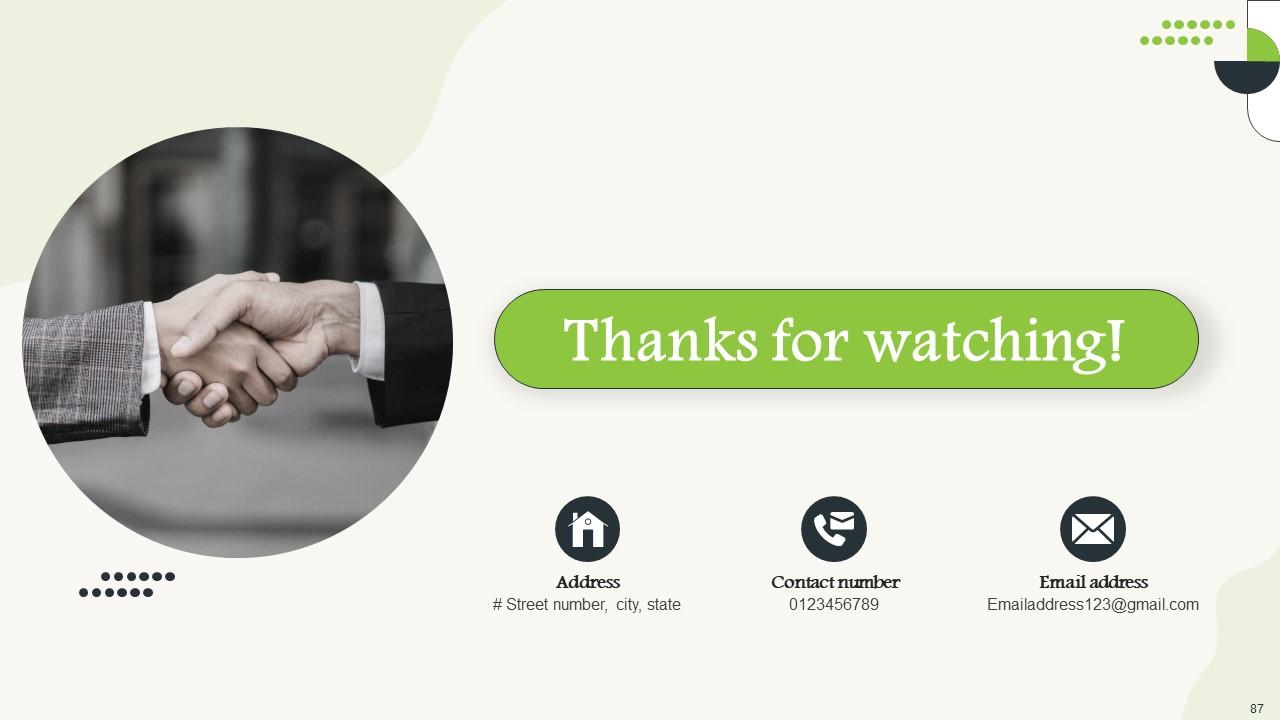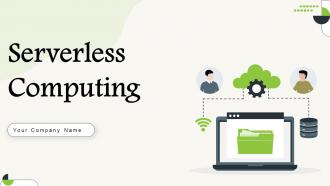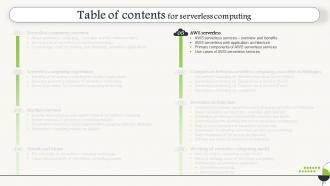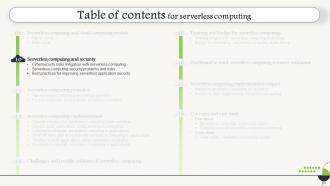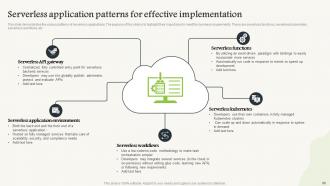Serverless Computing Powerpoint Presentation Slides
This serverless computing PPT includes a serverless computing overview, key features, and technologies for building and deploying serverless applications. This PowerPoint presentation demonstrates the importance, market overview, emerging trends, and benefits of serverless computing. We have also covered the overview, use cases, and primary components of AWS serverless services. In addition, this event-driven computing PPT represents the comparison between serverless computing and other technologies such as Infrastructure-as-a-Service IaaS, Backend-as-a-Service BaaS, Platform-as-a-Service PaaS, and containers. Furthermore, the Function-as-a-Service module explains the fundamental concept and terms of serverless architecture. It also discusses the working process, primary use cases, and advantages of serverless architecture technology. Moreover, this serverless architecture deck contains sections about models, service providers, training, and budget for serverless computing. It illustrates a complete plan to build applications using serverless computing, and challenges faced during implementation, and their possible solutions. This deck also provides serverless computing implementation impact on businesses and before vs. after comparison. Lastly, this serverless applications deck comprises a roadmap, a 30-60-90 days plan, a timeline, a checklist to integrate serverless computing in applications, and a dashboard to track serverless computing resource utilization. Download our 100 percent editable and customizable template, compatible with Google Slides.
This serverless computing PPT includes a serverless computing overview, key features, and technologies for building and dep..
- Google Slides is a new FREE Presentation software from Google.
- All our content is 100% compatible with Google Slides.
- Just download our designs, and upload them to Google Slides and they will work automatically.
- Amaze your audience with SlideTeam and Google Slides.
-
Want Changes to This PPT Slide? Check out our Presentation Design Services
- WideScreen Aspect ratio is becoming a very popular format. When you download this product, the downloaded ZIP will contain this product in both standard and widescreen format.
-

- Some older products that we have may only be in standard format, but they can easily be converted to widescreen.
- To do this, please open the SlideTeam product in Powerpoint, and go to
- Design ( On the top bar) -> Page Setup -> and select "On-screen Show (16:9)” in the drop down for "Slides Sized for".
- The slide or theme will change to widescreen, and all graphics will adjust automatically. You can similarly convert our content to any other desired screen aspect ratio.
Compatible With Google Slides

Get This In WideScreen
You must be logged in to download this presentation.
PowerPoint presentation slides
Enthrall your audience with this Serverless Computing Powerpoint Presentation Slides. Increase your presentation threshold by deploying this well-crafted template. It acts as a great communication tool due to its well-researched content. It also contains stylized icons, graphics, visuals etc, which make it an immediate attention-grabber. Comprising eighty seven slides, this complete deck is all you need to get noticed. All the slides and their content can be altered to suit your unique business setting. Not only that, other components and graphics can also be modified to add personal touches to this prefabricated set.
People who downloaded this PowerPoint presentation also viewed the following :
Content of this Powerpoint Presentation
Slide 1: This slide introduces Serverless Computing. State Your Company Name and begin.
Slide 2: This slide is an Agenda slide. State your agendas here.
Slide 3: This slide shows a Table of Contents for the presentation.
Slide 4: This slide is in continuation with the previous slide and shows the table of Contents.
Slide 5: This slide is in continuation with the previous slide and shows the table of Contents.
Slide 6: This slide discusses the serverless computing model.
Slide 7: This slide outlines the main features of serverless computing technology.
Slide 8: This slide outlines the different types of serverless computing technologies to develop serverless applications.
Slide 9: This slide introduces Serverless computing overview out of the table of contents.
Slide 10: This slide shows the Benefits of serverless computing for modern applications.
Slide 11: This slide describes the Reasons for promoting the adoption of serverless computing.
Slide 12: This slide contains Services provided by serverless computing technology.
Slide 13: This slide introduces a market overview out of the table of contents.
Slide 14: This slide illustrates the sector-wise services and market share of serverless computing.
Slide 15: This slide demonstrates the market analysis of the serverless computing industry.
Slide 16: This slide represents the market distribution of serverless computing based on various factors.
Slide 17: This slide depicts the market share of various serverless computing providers.
Slide 18: This slide introduces Trends and the future out of the Table of Contents.
Slide 19: This slide highlights the current trends of serverless computing systems which can enhance the quality of serverless applications.
Slide 20: This slide talks about the upcoming serverless computing improvements.
Slide 21: This slide introduces AWS serverless out of a Table of Contents.
Slide 22: This slide provides an overview of serverless on Amazon Web Services.
Slide 23: This slide represents the AWS serverless web application architecture.
Slide 24: This slide shows the list of various serverless technologies introduced by Amazon Web Services.
Slide 25: This slide demonstrates the use cases of AWS serverless services and is in continuation with the previous slide.
Slide 26: This slide describes the use cases of AWS serverless services and is in continuation with the previous slide.
Slide 27: This slide caters to the use cases of AWS serverless services and is in continuation with the previous slide.
Slide 28: This slide illustrates the use cases of AWS serverless services and is in continuation with the previous slide.
Slide 29: This slide introduces a Comparison between serverless computing and serverless architecture out of the table of contents.
Slide 30: This slide draws a comparison between serverless computing and Platform-as-a-Service (PaaS) based on several factors.
Slide 31: This slide showcases a comparison between serverless computing and backend-as-a-service (BaaS) based on several factors.
Slide 32: This slide describes a comparison between serverless computing and Platform-as-a-Service (PaaS) based on several factors.
Slide 33: This slide compares serverless computing with containers.
Slide 34: This slide introduces Serverless architecture out of the Table of Contents.
Slide 35: This slide discusses the correlation between serverless computing and serverless architecture.
Slide 36: This slide talks about serverless architecture and provides an overview.
Slide 37: This slide showcases the fundamental concepts and terms of serverless architecture.
Slide 38: This slide represents the functionality of serverless architecture.
Slide 39: This slide presents the role of cloud providers in serverless computing.
Slide 40: This slide illustrates the advantages of using serverless architecture.
Slide 41: This slide caters to the limitations of serverless computing systems.
Slide 42: This slide describes the Primary use cases of serverless architecture.
Slide 43: This slide introduces the Working of the serverless computing model out of the Table of Contents.
Slide 44: This slide discusses the working of serverless computing models.
Slide 45: This slide outlines the working steps of a serverless computing system.
Slide 46: This slide demonstrates about serverless backend component of serverless application with the help of a flow chart.
Slide 47: This slide shows the serverless functions which are also termed as Function-as-a-Service.
Slide 48: This slide is to illustrate the working of a serverless function and is in continuation with the previous slide.
Slide 49: This slide introduces Serverless computing and cloud computing models out of the table of contents.
Slide 50: This slide discusses the integration of serverless computing technology with a hybrid cloud computing model.
Slide 51: This slide caters to the integration of serverless computing technology with a multi-cloud computing model.
Slide 52: This slide introduces Serverless computing and security out of Table of Contents.
Slide 53: This slide talks about some ways that a serverless system can help reduce the attack surface by minimizing the number of attack vectors.
Slide 54: This slide shows the security challenges and risks of serverless computing.
Slide 55: This slide illustrates the best practices to enhance the security of serverless applications.
Slide 56: This slide introduces Serverless computing platforms out of the Table of Contents.
Slide 57: This slide demonstrates the popular serverless providers, named AWS Lambda, GCP (Google Cloud Platform) functions, and Azure functions.
Slide 58: This slide represents the prices of using various serverless computing providers.
Slide 59: This slide introduces Serverless computing implementation out of the Table of Contents.
Slide 60: This slide outlines the various scenarios that can help in deciding if serverless computing is the right choice or not.
Slide 61: This slide entails the implementation steps to build applications using serverless computing technology.
Slide 62: This slide represents the checklist for integrating serverless computing.
Slide 63: This slide is 30-60-90 days plan to incorporate serverless computing in applications.
Slide 64: This slide is a Timeline slide. Show data related to time intervals here.
Slide 65: This slide presents a Roadmap with additional text boxes.
Slide 66: This slide introduces Challenges and possible solutions of serverless computing out of the Table of contents.
Slide 67: This slide talks about the challenges faced by serverless computing.
Slide 68: This slide introduces Training and Budget for serverless computing applications out of the Table of contents.
Slide 69: This slide describes the training program for employees to integrate serverless computing into applications.
Slide 70: This slide represents the budget for building and deploying serverless computing applications.
Slide 71: This slide introduces Dashboard to track serverless computing resource utilization out of the Table of Contents.
Slide 72: This slide shows the dashboard that can be utilized by organizations to track the resource utilization of serverless computing.
Slide 73: This slide introduces the Serverless computing implementation impact out of the Table of Content.
Slide 74: This slide represents the various factors that showcase the improvement of business performance after adopting serverless computing.
Slide 75: This slide compares the business scenario after deploying serverless applications.
Slide 76: This slide introduces Use cases and case studies out of the Table of contents. f
Slide 77: This slide demonstrates the several use cases of serverless computing systems.
Slide 78: This slide describes several use cases of serverless computing systems.
Slide 79: This slide outlines the common uses of serverless computing platforms.
Slide 80: This slide introduces the Case study out of the Table of Contents.
Slide 81: This slide illustrates a case study on serverless computing proposed by Centizen.
Slide 82: This slide caters to a case study on serverless computing proposed by Centizen, in continuation with the previous slide.
Slide 83: This slide shows all the icons included in the presentation.
Slide 84: This slide is titled Additional Slides for moving forward.
Slide 85: This slide represents the drawbacks of serverless computing systems.
Slide 86: This slide demonstrates the various patterns of serverless applications with the help of a flow chart.
Slide 87: This slide is a thank-you slide with address, contact numbers, and email address.
Serverless Computing Powerpoint Presentation Slides with all 92 slides:
Use our Serverless Computing Powerpoint Presentation Slides to effectively help you save your valuable time. They are readymade to fit into any presentation structure.
FAQs
Serverless computing is a cloud computing model where developers focus on writing code without managing server infrastructure. It relies on cloud providers to automatically scale and manage resources. When a function is triggered, the cloud provider allocates resources as needed, executes the function, and then deallocates resources.
Serverless computing offers benefits such as automatic scalability, reduced operational overhead, cost savings, faster development, and the ability to focus on code rather than infrastructure management. It is ideal for microservices, event-driven applications, and workloads with variable traffic.
Serverless architecture is suitable for various use cases, including web applications, real-time data processing, chatbots, IoT applications, and background tasks like file processing and data transformation. It excels in scenarios where workloads are sporadic or unpredictable.
Serverless computing has limitations, including potential cold start latency, resource constraints, and limited control over the underlying infrastructure. Long-running tasks may not be cost-effective, and some applications may require traditional server-based approaches for optimal performance and control.
Key terms in serverless architecture include functions (serverless units of code), events (triggers that initiate function execution), and statelessness (functions that do not retain data between invocations). Understanding these concepts is crucial for designing serverless applications effectively.
-
Wonderful templates design to use in business meetings.
-
Like always a great experience with you guys. Always there on the drop of hat to help.



